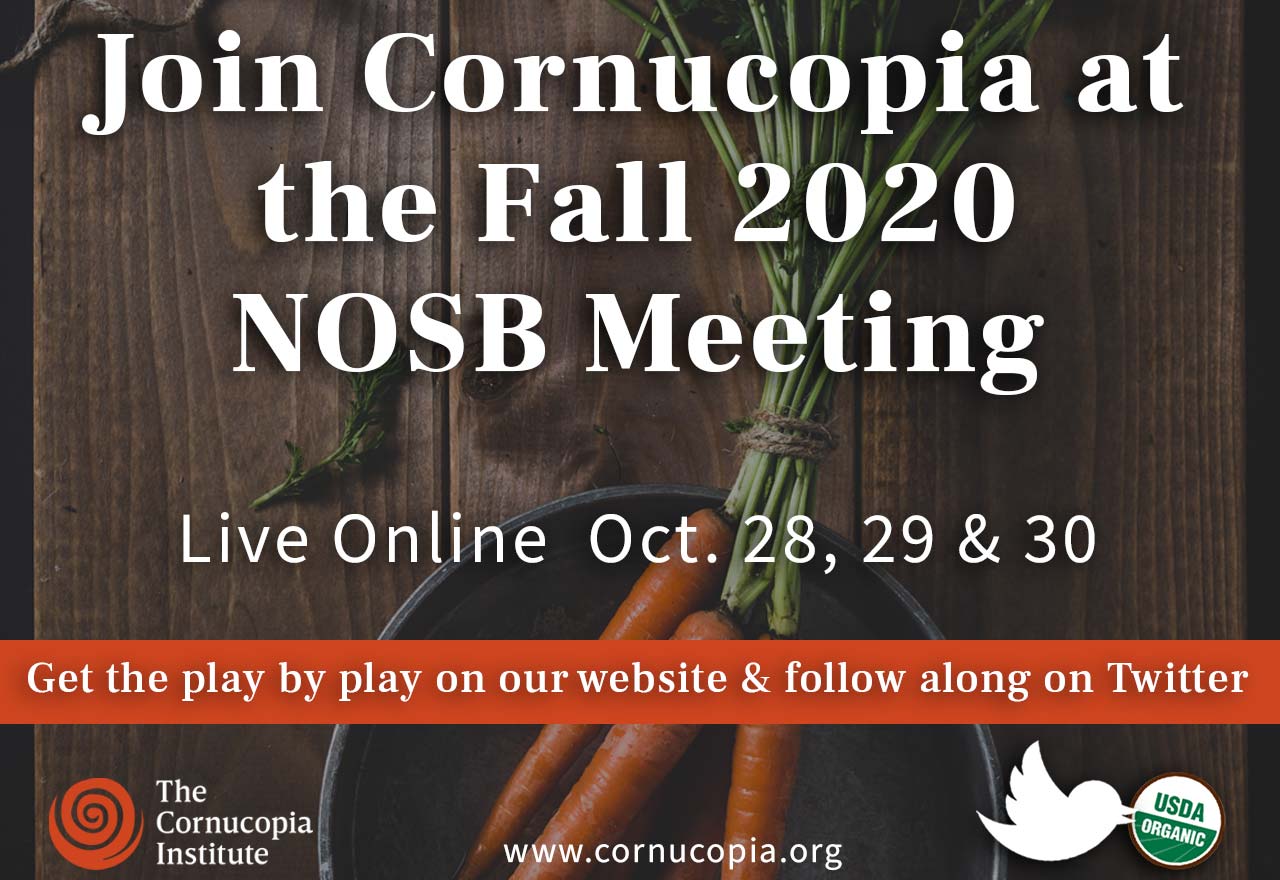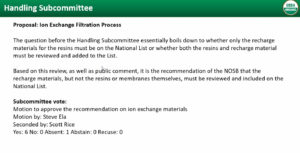Join The Cornucopia Institute as we keep you informed via web updates and live tweets from the National Organic Standards Board (NOSB) meeting online.
We will be sharing the play by play of the meeting on October 28, 29, and 30 below and with our Twitter followers at #NOSB or by simply following our stream.
For background on issues up for discussion at the meeting, see:
- Cornucopia’s formal written comments.
- Transcript of Kestrel Burcham’s oral testimony before the NOSB on October 22. (Listen to audio)
- Transcript of Melody Morrell’s oral testimony before the NOSB on October 22. (Listen to audio)
- Transcript of Cornucopia Board Vice President Helen Kees’ oral testimony before the NOSB on October 22 (Listen to audio)
Read Cornucopia’s notes on the NOSB meeting beginning October 28 at 12 pm ET.
Find our notes from the October 20 public comments and October 22 public comments below.
Thursday, November 12, 2020: Sanitizer Panel
Dr. Jennifer Tuckers makes some opening remarks.
Steve Ela, Board chair, then facilitates the the meeting.
Steve does a roll call of the NOSB. Both Rick Greenwood and Dan Seitz are not present and will not be present for the rest of the call. The rest of the Board members are present for the panel.
Dave Mortensen then introduces the panelists:
Bob Durst. Linus Pauling Institute. Managed Food Composition Lab at Oregon State University for over 20 years. Principle at Simple Organic Solutions. [email protected]
Dr. Joseph Morelli. Corporate scientist, food and beverage division.
Dr. Angela Anandappa. Executive director, Alliance for Advanced Sanitation. Instructor at Northeastern University. Expert in food safety and associated materials, and interested in food safety challenges and substances that could be useful to the organic industry. [email protected]
Steve Ela Facilitates. He notes that the structure of the panel will be 3 presentations, followed by questions from the NOSB.
Bob Durst’s Presentation
Food safety has to be the primary concern of the industry. Food borne illness would be a bad mark to the organic marketplace. Cleaning and sanitizing practices can be implemented that are compatible with organic principles.
Durst notes he is focused on manufacturing and handling side, as he does not have background in crops and livestock.
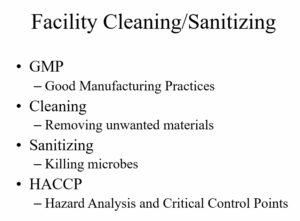
HACCP is becoming more widely adopted, and even managed in a few sections of the industry. Cleaning is primarily to prevent co-mingling of materials. The OSP should address all these issues.
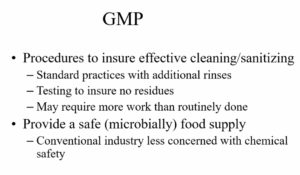
As far as food safety is concerned, often the same issues apply to organic as they do for conventional. OFPA criteria includes things like detrimental interactions, toxicity, biological effects, etc.
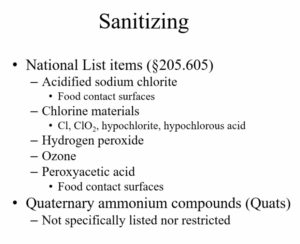
Dr. Joseph Morelli’s Presentation
Relative criteria are going to be balanced differently depending on the application (for example when you are looking at cleaning with anti-microbials, the surface type matters). Because of this it’s difficult to have clear qualitative decision trees due to this complication.
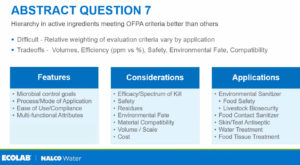
Some of the challenges we face are the use of CAS# and nomenclature. It’s important to ask folks what precedent they have to assume their sanitizer conforms with the organic rules?
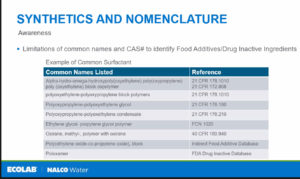
Organic production commonly uses similar cleaners and sanitizers at different levels of the operation. But those uses may not be harmonized within the regulations themselves.
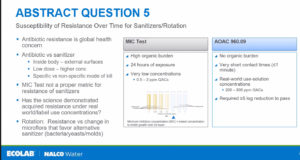
Dr. Angela Anandappa’s Presentation
Ask why what and how when asking whether you need these materials at all? And do we have an alternative to the material (and equivalence in the performance)? This is important information for us to consider. Also relevant is us having a conversation about sanitizers only, or all cleaning agents? We should be able to evaluate these things from a systems-basis.
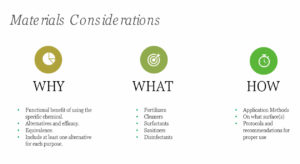
Where do the chemicals fit into our world of food safety? If we are not increasing food safety with the chemical then we are not achieving our goal. We need to ask: at which step in the sanitation process is the chemical required? Water quality affects things. We know that sanitizers do not work on “dirty” surfaces, so surfaces must be cleaned first.
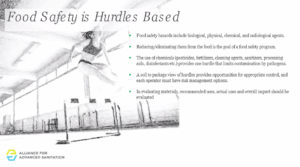
Biofilms are present on most areas of the planet. On food processing equipment biofilms can be in heavy loads. Should consider biofilms rather than target organisms; in part because bacteria live in communities. Biofilms are living communities that possess complex organization, defense mechanisms, hierarchy, and team work between members of the “community.” They can communicate and have a memory. This raises further questions when speaking about resistance. When we evaluate biocides we need to keep this in mind. Cleaning may remove just the top layer of biofilm, but not destroy lower community.
Evaluation criteria for materials based on effectiveness. Over time microbial community changes—whether it’s responding to the cleaner or something else is dependent on many factors. It’s very complex; the surface is complex.
The important criteria for addition and removal: Resistance versus persistence—resistance is from to horizontal gene transfer, but the organisms can also evolve to have an adaptation against a sanitizer. For organic foods the biggest impact is emphasizing “cleaning” over just the use of a new chemical.
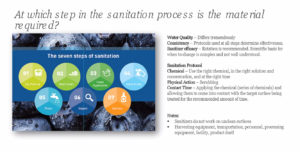
Steve Ela facilitates question and answer with the panelists.
Oakley: It can be very difficult to determine the “necessity”, can you help the board figure out how to make a full evaluation, especially with respect to necessity. We are looking for on ow to access new petitions fairly and effectively.
Morelli: Some of the criteria you must use are already useful for that question. What can it do to enable user compliance. What is it offering above and beyond what you have? If it helps us achieve safe food better, it should be considered.
Durst: The protocol for what is in place on pest management, where you have hierarchy of treatment, is something that might be appropriate for sanitizers. You have materials that are regularly used, but if you have someone who finds those not effective for some reason, they have nowhere to go right now. Essentially building in a hierarchy of use.
Ela: So start with cleaning; a certifier could look at what you did first, such as cleaning, them IPM approach, then harder chemicals…
Durst: the problem is: what are those materials? And an event like that is something that would need an immediate response like in a food plant. They will need to respond quickly for best food safety.
Morelli: If you look at anti-microbials listed, they require high concentrations to be effective or they will not have the breadth of kill that food processors and handlers are worried about. So what’s the relative impact using something in large volume, versus something that might be effective in very small levels. “Natural” might not have the full spectrum of kill needed to fit all applications.
Bradmen: In terms of resistance, I know it’s different than antibiotic residence. I’ve heard for ammonia compounds (QUATs) there is movement of genetic material, meaning there could be crossover. We have a petition right now for CPC (a QUAT); first time this class of material would be on the list if it was approved (another chlorine compound). It’s also in the category of a food contact material, which raises concerns for the consumer. What is your take on this?
Morelli: It’s not accurate to call this a chlorine compound, this is better described as a QUAT compound. Cross resistance is a tougher topic. In lab settings they can demonstrate that cross-resistance happens, do not have proof that that happens in real-world setting. You need to have a pool of organisms available to have that transfer of genes. Reality is we have evidence both that it is possible and that it isn’t possible.
Anandappa: Resistance and persistence are different. Stick with the word “persistence”… a certain amount of rotation is suggested because organisms are good at persisting. We are looking for what to recommend to facilities when to rotate. There is an opportunity for some type of resistance, but there is a necessity to say there is a possibility we need to monitor. One of the things we need to provide operators is a choice of chemicals; for outbreaks, would be good to have an option of using a different material. Preventive cleaning is also important. There need to be options.
Morelli: You can have innate resistance. The organism may have some genetics that promote resistance already; that’s innate, it does not mean resistance. It just has higher resistance. Acquired resistance is where there is a genetic exchange that is expressed phenotypically—it has to lead to a change in tolerance. Adaptation means the organism is changing with it’s environment. Looking at sanitizers, it’s used at much higher concentrations with less soil, so less risky than antibiotic resistance in humans. A change in MSC is not an appropriate measure.
Mortensen: The issue of having the “tool in the toolbox” comes up a lot, and that there is a need to expand the toolbox. Concerned that this expansion is a serious slippery slope. At some point the list of materials used in organic is so long we are no longer discerning. Can you imagine a way that compounds like sanitizers where we start form saying no—what does “no” look like? The one step past the “no” for these criteria, then maybe we consider other factors. Does this make any sense? If it does, what are the rules of thumb hat would lead one to conclude that a compound is a “no” compound?
Durst: The use of cleaning compounds, not sanitizers, is virtually unrestricted because those have some kind of intervening step in them (like rinsing) that allow them to be used. So procedurally you don’t need to evaluate them because they don’t make contact with the food. Sanitizers are different, but maybe in situations like processing (food contact surfaces rather than direct food contact) where there is an outbreak maybe you can use a sanitizer but then you have to go through some procedure to assure those sanitizers are no longer present. That’s how QUATs right now are used in the industry. Because QUATS leave residues, you go through cleaning afterwards and re-sanitize with something else before removing forward with processing.
Morelli: Additional steps are always difficult to consider because they slow production time for processor.
Anandappa: People rush to sanitize without considering quality of water or don’t test frequently enough. For fresh produce and products that are consumed minimally processed, it is a special are where we need to be stricter about what we are using. Water is the big one. You can see bacterial counts even after a sanitizer is applied because the water is poor.
Ela: Question becomes should we approve everything because they all have purposes. But do we then try and evaluate downstream environmental damage then as the deciding factor?
Morelli: If you have a new candidate, what benefits does it provide over other ones? It’s a rational assessment to consider trade-offs. Can’t look at one factor; it might be more application-specific. Saying “no” across the bord will make our food less safe.
Buie: Where do we consider the functional groups that are attached to these molecules?
Morelli: Just breaking it down to functional group will not help evaluating. The organic criteria are more useful.
Buie: It seems like there could be interactions between cleaner and sanitizers and we are wondering if that’s something that need to be considered before adding something to the list.
Morelli: You shouldn’t be adding sanitizer on top of the cleaner. Cleaning does need to be done effectively before sanitizing is then done. You cannot sanitize right without cleaning first.
Durst: Just approving a compound—that is never applied just alone. Materials instead are applied in formulations. So does that mean those sanitizers cannot be used because they are formulated with other things? I think the ruling on that was that the TRs were looking at formulated products, so that it’s been accepted.
Morelli: Yes, many of the formulations include stabilizers at a minimum. So do cleaning formulations.
Oakley: The Board is challenged when we receive petitions for new materials. In revieing new material petitions, when determining specific need/use that it’s being petitioned for, there is a question of the need is already being met. Petitioners always think there is a unique need. How we weigh that out is very difficult for us. Wondering if each of you had thoughts if you were on the Board how you would approach these petition materials and fairly and accurately evaluate.
Anandappa: A flow chart comes to mind, we need one for this. Would be helpful to communicate to people before they send a petition. Currently approved materials can be approved for different use case—those are the easier ones to approve. My experience has shown any once of these materials you need a back and then a backup to the backup. That’s risk management for the list. Irrespective of the petitioner themselves. Different types of producers may be using the same chemical; you need 2-3 chemicals of the same class for the same purpose. Otherwise you just need something that addresses each question.
Oakley: Do you have suggestions on how we might develop some kind of flow chart/decision tree? Any suggestions would be appreciated.
Anandappa: Taking some of the presentations we did today and follow up could develop a basic stick figure framework. Necessity, efficacy, and alternatives approach come first for me. Is it a distinct situation from what has existed in the past?
Morelli: If you can’t distinguish market availability, effectiveness, etc. Then perhaps determine based on other criteria. Would be less concerned about environmental fate if something breaks down, because it’s easier to determine definitively.
Ela: Concerned about needing 2-3 options in the same class. Is it okay to bounce around outside of classes?
Durst: Yes, rotating tools is useful because different things respond to different types.
Anandappa: You may want 1-2 from different classes. A certain amount of rotation is recommended throughout.
Bradmen: There are lots of problems with workers being exposed to bleach and related compounds. There is very little literature on exposure monitoring in food processing. Heard mention of IPM approach, talked about in term of rotating materials, but not necessarily managing populations. If we kill everything do we open up niches for pathogenic bacteria that wouldn’t otherwise exist.
Anandappa: Complicated area. You’re asking: can we take holistic view of food processing environment instead of thinking of it as a target to completely eliminate microflora. If cleaning is done correctly the sanitizer is not the biggest issue. IPM is for pest management is really about exclusion and doing everything possible to avoid chemicals based on understanding of target organisms. Sanitizers are last resort for the surface of interest (not your entire facility). It’s a risk-based approach.
Ela: Bob mentioned as long as there is proper rinsing, processors can use what they want, even in organic. But I want the NOP to answer whether it’s allowed to use anything as long as it’s removed entirely.
Morelli: GMPs should include evaluation whether you intend to remove all of a sanitizer, and whether it’s effective.
Ela: [Reads comment from certifier in the chat that states: “As a certifier, we let food processors use any material as an equipment cleaner or sanitizer, as long as you remove any residue.”]
Jared Clark (with the NOP): We do look to certifiers to ensure that contamination with prohibited substances is prevented in some way. We look to certifiers in the OSP.
Ela: So when we get a petition for something, so what we are really approving is either food contact or that material NOT removed with a rinse after it’s applied.
Durst: Yes, you’re interpreting that right. But there is a real difference between cleaners and sanitizers. Cleaners you always want to remove. Sanitizers you don’t want to remove or rinse it, because you are at high risk of re-contaminating and processors don’t want to do that.
Ela: My understanding is that biofilms are difficult to reach with both cleaners and sanitizers. How do we approach that?
Anandappa: Biofilm removal—multi-layered organisms. You have to evaluate biofilm development first. You have to use a lot of physical force to clean before even going in with a sanitizer. A surface that looks clean may still have biofilm.
Morelli: Hygienic design is also important. Some processors have issues with this. In dairy, score count is an issue. We tend to believe lab pasteurize counts are associated with some of these biofilms.
Anandappa: Even with good hygienic design it won’t prevent biofilms. Proper cleaning is what it comes down to in many circumstances.
Ela: Should we be annotating these substances to specify certain procedures when we have food contact surfaces? What do we have to think about for those situations>
Durst: Something to think about if it’s a contact surface sanitizer versus a direct food contact. Definitely may want to evaluate with different criteria.
Ela: How would we look at direct food contact versus food surface contact differently?
Morelli: Food contact sanitizer is also different than food tissue treatment. The EPA reviews food contact sanitizers; they do assessments of safety. Same thing with food treatment, but under FDA. These all do appropriate risk assessment.
Ela: Agreed, but we are more restricted in organics.
Anandappa: We also look for residue limits if it comes into contact with food, and whether it’s GRAS.
Oakley: I am trying to summarize what we as a subcommittee need to look at. Some of what the NOSB needs to be looking at is whether adequate cleaning and rinsing is occurring first, before sanitation. Then asking ourselves the “new need” a petition material might be meeting, and is that being adequately demonstrated. And alternatives, and are they adequate, and are their old materials that could be approved for a new use.
Durst: It’s the additional criteria in organics that complicate matters.
Oakley: It’s a challenge to weight the different needs of food safety and organic principles.
Durst: When you get a TR for a material in general, needs to take a bigger look at it. A TR-like-thing addressing sanitizing as a generic might be called for. It could be part of the decision tree.
Baird: We are getting improvements in materials, and they are being worked on all the time. My concern is that those of us that do the evaluation under OFPA we are assuming that if the chemical has the same base as something already approved we don’t need it. We may be missing out on new technologies that are better?
Morelli: It’s not just about chemistry for sure. You have to look at all relevant attributes of a material. Wresting with how to make this decision makes sense, l it’s tough, and there are a lot of anti-microbials on the market right now.
Ela: We often get comments fearing we will take away sanitizers, and others ask for a comprehensive review of sanitizers. This has given a lot to think about.
Mortensen: This was all very helpful. It would be nice for NOSB to forge a more dynamic relationships with the EPA; this also came up with the discussion of inerts. A path forward is clearer than it was before the panel. Thanks panelists.
Steve Ela adjourns the fall 2020 NOSB meeting.
Friday, October 30, 2020: NOSB Meeting
12 PM ET: Call to Order, Agenda Overview; Materials Subcommittee Research Priorities
NOSB Chair Steve Ela welcomed everyone to the second day of the NOSB meeting. All NOSB members are present at the beginning of the call. Today the NOSB will go through Materials and Crops Subcommittee matters.
Dave Mortensen, Chairperson, presents the Materials Subcommittee (MS) Research Priorities.
Proposal: Research Priorities 2020
[Note: The NOSB presents an annual list of research priorities for organic food and agriculture. The NOSB requests that integrated research be undertaken with consideration of the whole farm system, recognizing the interplay of agroecology, the surrounding environment, and both native and farmed species of plants and animals.]
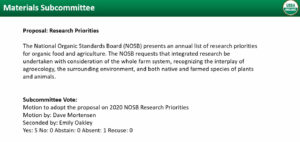
Mortensen: Subcommittee discussed which research priorities need to be sunsetted and which should be prioritized. Public comments on the priorities were generally favorable. USDA’s Competitive Grants Program has embraced NOSB’s research priorities. Seeking to weight the items that are more urgent. Overall the Board is excited about the document.
Rice: Perhaps we can consider the issue of human capital as an area for attention in research.
Mortensen: We could think about expanding research priorities to include education needs as well.
Motion to adopt the 2020 NOSB Research Priorities.
- Vote: 0 no; 15 yes. The proposal on 2020 NOSB Research Priorities was adopted.
12:10 PM ET: Crops Subcommittee
The Crops Subcommittee (CS) discussion is led by Jesse Buie, Chairperson.
Proposal: Wild, native fish for liquid fish products
Summary of issue: The use of fish in crop fertility products has a long history in organic agriculture. Over the past five years, the board has heard from stakeholders about potential negative environmental impacts of harvesting some marine materials for organic production. The purpose of this proposal is to limit the impact of harvesting wild, native fish for fertilizer and to ensure that liquid fish fertilizer products used in organic production are not harmful to the environment.
Oakley: Originally received testimony that some fertilizer is created from fish exclusively harvested for this purpose. A Technical Report on this issue gave us more information on sourcing and related issues. After further input, the board agreed to investigate the possibility of an annotation that fish products must come from byproducts of human use. Other uses are for livestock, oil, and meal. This makes this annotation more complicated to enforce. Some commenters who supported it thought it could be stronger; concerns that there could be effects in marine ecosystems.
Ammonia extract supporters felt this annotation should go forward, noting it will likely exclude 40% of the total supply. They claimed that ammonia extract could fill that void.
Questions about what sort of verification would be required. Anything beyond attestation? Some clarifying language has been added to terms defined at 205.2 (see slide).
The issue of pet food was not discussed in the TR. More information is needed in the future.
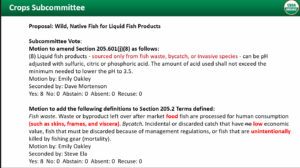
Turner: Largely supportive. A lot of good input from the comments. Conflicted about pet food (does not think ocean environments should be damage to feed dog) and agrees more work is needed there. Heartened by comment on being more specific about what bycatch includes. There should be further protections for threatened species. Could naming species be enforceable?
Oakley: Protected species are covered by existing laws to some extent. A lot of species-specific research was done for marine macro-algae. We have not done that here because it would require an enormous amount of research that may be difficult to obtain or easy to contest.
Rice: How can the board work on similar or same issues across subcommittees? This conversation rings on EPA List 4 Inerts and other issues.
Oakley: This proposal is meant to address the livestock use issue, in part. Livestock feed aspect; this is something that we would be restricting. Meal and oil from fish is something that’s primarily used in livestock. if we put in livestock feed it would defeat the other purpose of the annotation, opening it up so broadly it would negate the point of the annotation.
Ela: When we first brought this up we were concerned about wish being used on organic farms. Stakeholders claimed there was no problem here, but as we have proceeded, we now are talking about economic impacts. When we go to pass this motion suddenly there is all this economic impact concerns. It makes me concerned about the process we have.
Oakley: One commenter noted that saying “fish harvested only for fertilizer” is problematic. It gets tricky when we try to nail down why a fish is being harvested. Fish are being harvested for numerous reasons and solubles are sort of a byproduct. There were differing views on TR results. Fish harvested for wet reduction process can be used in the fertilizer in all parts, but mostly wet reduction is primarily used for livestock feed. Fertilizer is a “third tier”, essentially.
Ela: As we were about to drop the issue, one commenter said they knew of a company harvesting fish for this purpose. It’s very complicated and the outcry about economic impact surprised me. This shows that we need to be careful and dig a little deeper, ask more specific questions in this process. This is a complicated topic.
Baird: I don’t think we should discount livestock feed. Used to work for feed company, formulated feeds. Many times the fish meal was used. If you are formulating fish feed you have to use fish meal and fish oil. Again we are hearing comments not to rush this issue.Concerned that we’re going to pass some of these things in hopes that NOP will take care of it. Doesn’t think it’s NOP’s job to nail down issues we passed in a hurry.
Oakley: Our intention was to source only from fish bycatch as an effort to reduce our impact on the broader fishery ecosystem. Whether there is or is not enough waste from processing for human use, if this went through rule making, stakeholders would then be active and we would find out the total ramifications.
Vote to amend Section 205.601(j)(8) as noted above concerning Liquid Fish Products.
- Vote: 0 no; 15 yes. Amendment passes.
[Discussion follows on Robert’s Rules of Order; some Board members want to send the issue back to Subcommittee. The NOP asks that whatever they choose to do to make it very clear in the cover letter what the NOSB wants done.]
Powell-Palm makes a motion to move this issue back to Subcommittee, Baird seconds.
Oakley: What does the board want the subcommittee to work on? It will be only to work on definitions, as far as I know. It was the intention of the proposal to exclude livestock; this was not an oversight.
Mortensen: We are effectively questioning the vote we just took, correct?
Motion to send this back to subcommittee.
- Vote: 10 no; 5 yes. Motion fails.
Motion to add the following definitions to Section 205.2, terms defined (see slide for language).
- Vote 1 no; 13 yes; 1 abstention. Motion passes.
Proposal: Paper (Plant pots and other crop production aids) – petitioned
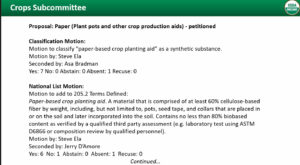
Ela: Received a lot of testimony that paper pots are very important to small growers. We have expanded the work to “paper-based planting aids” from just paper pots. The biodegradable standard was removed because it is difficult to impossible to enforce. ACA asked for reference to pesticides be removed, as this would make the paper pots a pesticide. Consideration to remove biodegradable biobased mulch from the listing. Most commenters are in favor of including paper-based crop planting aids to the National List.
[Ela then summarizes the comments received.]
Mortensen: Suggests we could put changes in a cover letter and send on to the NOP to incorporate. Would like to move this forward now for small farmers.
Turner: Enthusiastic about this, but deeply concerned about language that allows for virgin paper in these products. Thinks it dis-incentivizes innovation. All of these moving forward will use virgin paper if that is how the listing reads.
Ela: The program first flagged this listing for the use of virgin paper and adhesives. These products cannot be made from post-consumer content; they require some amount of virgin paper. Fiber lengths needed for the pots makes it difficult to do recycled/waste paper. Some manufacturers of paper pots use sustainable trees and are proud of it, but of course other manufactures could do something different. At this point, a viable product must include some virgin paper fibers. Excluding virgin paper would exclude every product on the market right now.
Rice: Cautions the board in moving items to the program thinking they are close enough and asking NOP to sort them out. We need to get it as close to right as we can without perfect being the enemy. Listing clarifications have precedent from the past.
Jeffery: Behooves the NOSB to own the language of our recommendations as much as we can. We need this for small, local producers. Not comfortable with lab testing as a reference in the regulations because we need to continue educating the consumer that organic is process-based. Would prefer to review to composition review rather than a test. Could be okay with virgin paper in the short-term and amend when new products are available.
Greenwood: This is necessary for small organic farmers. Paper is very complicated. We could debate it forever. Don’t like the virgin paper, but in the mass balance, wonders if it’s truly a major obstacle.
Bradman: The 20% that does not have to be bio-based: we are allowing the intentional introduction of plastic into the soil. It is an important tool for small farmers, but this is problematic. The goal down the road would be 100% bio-based. We should ponder this 20%. We are sort of setting a standard for biobased mulch films, which we will discuss later today.
Buie: Does the third motion satisfactorily deal with the virgin paper issue?
Ela: No. Responding to the testing comment from Mindee Jeffery: We already allow testing on a number of products to confirm purity. Does not conflict with the process base of organic. OMRI submitted lengthy comments on how it will work to identify qualified third parties. OMRI suggested the use of testing.
Oakley: Understands paper concerns. Paper mulch that is allowed is also made from virgin paper. Prefers that the annotation say 100% bio-based content.
Ela: Problem with bio-based content is that cellulose can be used to make synthetic products. 100% bio-based does not limit it to actually being bio-degradeable. You can make complex items out of bio-based content. Surprisingly difficult issue. There are no natural fibers. Separating fibers from wood or hemp is a synthetic extraction process. Perhaps a delay could allow hemp product makers to get products to market.
Powell-Palm then motions to send this issue back to subcommittee. Jeffery: Seconded.
- Vote 4 no; 10 yes; 1 abstention. Motion passes. The paper pots issue will go back to subcommittee.
Proposal: Sodium carbonate lignin – petitioned
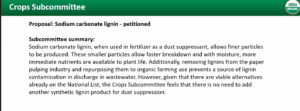
Greenwood: This is a synthetic product. This is a non-toxic compound, used to bind fertilizer for less dust. The TR identified the issue that another lignin is already on the National List. Do we add another synthetic when that is so?
Buie: Do you recommend adding this? Public comments indicate no need.
Greenwood: All on the subcommittee voted against it. Don’t think we need another lignin.
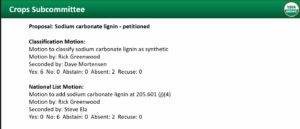
Motion to classify Sodium carbonate lignin as a synthetic.
- Vote: no; 15 yes. Sodium carbonate lignin was classified as a synthetic material.
Motion to add Sodium carbonate lignin to the National List at 205.601(j)(4).
- Vote: 15 no; 0 yes. Petition was denied.
1:35 PM ET: Crops Subcommittee, 2022 Sunset substances review
Soap-based algicide/demossers
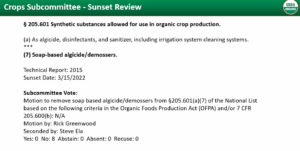
Greenwood: Most comments approve of relisting.
Motion to remove this substance from the National List at Sec. 205.601.
- Vote: 15 no; 0 yes. Soap-based algicide/demossers remain on the National List.
Ammonium carbonate
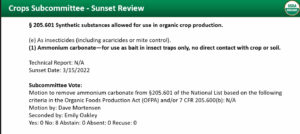
Mortensen: Ammonium carbonate is used in baits for insect management in livestock, poultry, and nut and fruit orchards. Used in a targeted way and it is an integral part of organic IPM. Received overwhelmingly strong report for relisting.
Motion to remove this substance from the National List at Sec. 205.601.
- Vote: 15 no; 0 yes. Ammonium carbonate remains on the National List.
Soaps, insecticidal
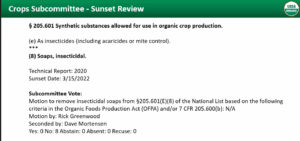
Greenwood: Public comments indicate strong community support. Performed a 2020 TR as an update. Little threat to environment when used as directed. Half-life is less than a day. No apparent effect on beneficial insects such as ladybugs. Subcommittee voted unanimously to relist.
Motion to remove this substance from the National List at Sec. 205.601.
- Vote: 15 no; 0 yes. Soaps, insecticidal remain on the National List.
Vitamin D3
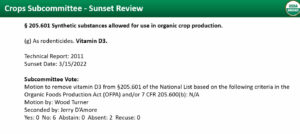
Turner: Used as a rodenticide around fruit and nut orchards. Strong support from community. Some comments suggest lack of effectiveness, but many suggest it would be deeply problematic to de-list it.
Mortensen: Questioning non-target effects. What species does this refer to?
Turner: Small mammals; not a concern to birds. No further details available.
Motion to remove this substance from the National List at Sec. 205.601.
- Vote: 15 no; 0 yes. Vitamin D3 remains on the National List.
Aquatic plant extracts
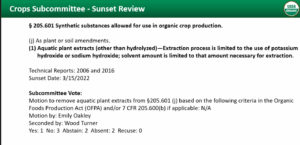
Oakley: Community support for relisting. One commentor made request for clarification on what is meant by “other than hydrolyzed.”
Mortensen: In light of the vote last night on marine materials, can you walk us through the logic here?
Oakley: Our vote last night makes me want to vote to relist, as I hope our vote last night goes to rule making.
Bradman: I voted against relisting in subcommittee due to my concern for extracting nutrients from one environment and moving it to another. It’s important to scrutinize where materials come from. Will reverse vote here in light of the vote last night [on marine macroalgae].
Oakley: Particularly concerned about wild materials from a wild ecosystem.
Mortensen: We are assuming if we vote to relist, the rule voted on last night will hopefully come into play quickly.
Buie: Have stakeholders expressed a need for aquatic plant extracts?
Oakley: Yes, it is commonly used.
Ela: Concerned about prefacing votes on this material on last night’s vote. Rule making is time-consuming.
Turner: Concerned that the process here will leave some ecosystems exposed for a while without the benefit of stronger rules.
Oakley: Hopes the program is listening. Asks program to expedite rule making.
Motion to remove this substance from the National List at Sec. 205.601(j).
- Vote: Vote: 12 no; 0 yes; 3 abstention. Aquatic plant extracts remain on the National List.
Lignin sulfonate
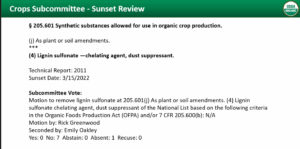
Greenwood: This material has tremendous support from stakeholders. Chelating agent, dust suppressant. Low toxicity. Byproduct of paper-making industry. Subcommittee supports relisting.
Rice: We had a comment regarding how this material is listed. Questioning whether an annotation should be revisited to clarify uses. Crops Subcommittee could look at this possibility.
Motion to remove this substance from the National List at Sec. 205.601(j) as plant or soil amendments.
- Vote: 15 no; 0 yes. Motion fails, Lignin sulfonate remains on the National List.
Sodium silicate
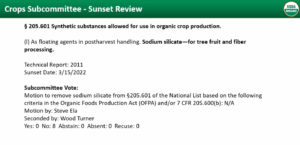
Ela: Primarily used to help pack pears. Some use for fiber processing, for which the board received no comments. This is still essential for small processors who cannot afford packing line updates. There were a few concerned comments about this essentially being a glass product, and that that comes with some safety risks.
Motion to remove this substance from the National List at Sec. 205.601(j).
- Vote: 15 no; 0 yes. Motion fails, Sodium silicate remains on the National List.
EPA List 4 – Inerts of minimal concern
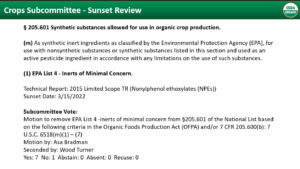
Bradman: We have a system for pesticide formulations that permit use of EPA List 4 inerts. The need for softer less toxic materials is important; not just for organic production, but for products that bridge the gap and are used in conventional as well.
[These substances] are not necessarily chemically or biologically inert. EPA List 4 was introduced in 1996, but EPA quit maintaining this list around 2006/2009. The issue is with synthetics on List 4. There are concerns that these materials from List 4 were incorporated to the National List without thorough review. Science has advanced since then as well. Written into OFPA at 6517 is the requirement that synthetic substances are not classified by the EPA as inerts of toxicological concern. In other words: we can only use materials that are NOT of toxicological concern. EPA is intrinsically involved in the review that would go into these materials, separate from what we would do in our review of list 4 inerts. List 4 is explicitly not supported by the EPA anymore. The idea of OFPA and the organic program is of continuous improvement. This is part of the process and should not be considered a threat by the organic community. Suggestion to use Safer Choice list to evaluate these materials moving forward. Public comments have been useful, including NOC’s outline of steps.
The Safer Choice list would not be used in place of EPA List 4. This is a controversial issue. If the board de-lists it, the intent is to create an orderly process to set up a system that includes community input. We currently have a broken system. Pesticides are extremely important for organic production and are less toxic than those used in conventional agriculture. Given their importance, the organic community must think carefully about what is in those pesticides. We need a transparent and thoughtful process for continuous improvement. Concerned about making a decision that would be perceived as undermining the logic of our oversight and recommendation practice.
Rice: In terms of our process, has a hard time using this vote to send a message, knowing the road of regulation is long. If nothing happens, this will simply relist. Much of our work is nuanced and detailed but politics doesn’t see that. This vote could appear as an unwise decision of a crazy board. I would love this issue to progress, but I think we need to apply pressure otherwise.
Bradman: Appreciate those comments.
Powell-Palm: When I first got into the world of NOSB in about 2016-17, was against Sen. Roberts’ language changes for the 2018 Farm Bill. Worries that, given the strong and consistent messaging from farmers, we need to relist it. Otherwise the NOSB could be perceived as not listening to constituents.
Baird: Farmers are going to panic. They will see the NOSB as having taken away the tools they need. Does not support this move.
Turner: Inclined to support the process Asa has laid out. Uncomfortable to think we are currently guided by this list. Cannot believe there is not a sense of urgency from the organic community to fix this. Nate, if we don’t do something here, tell me how this will change.
Powell-Palm: The 2015 recommendation was hard work the board has already done. There is a lot of work we can be doing while List 4 remains on the list. Does not think the risk is worth it. The country’s nerves are raw right now and we risk signaling we don’t listen to farmers. NOSB has a very good reputation compared to other federal advisory boards.
Ela: Sympathizes with concerns for a misstep causing the demise of the organic program. Is a pesticide user and it would take him out of business if they were de-listed. Would appreciate stakeholders contact him directly with concerns. This comes down to distrust of the program. Have had since 2015 to put something in place, and nothing has happened. Believes nothing will happen by 2025 if we relist it. The board would likely need to sideline all other work to make this work a priority. There has been no comment indicating what kind of system we should use. Cautions the board in this last flurry of emails and calls. Affronted by past board member statement that the board is making backroom deals. Agrees there is a question about suggested method, but accepts Dr. Tucker’s integrity. More importantly, notes there are fail–safes in the system. It will be relisted in two years if no progress is made. OFPA itself says we cannot use synthetics unless they are on the National List. The European standards do not look at Inerts at all, but OFPA does.
Jeffery: Expresses gratitude for great leadership and governance in this moment. Wants organic to be understood as a democratic institution. Given uncertainty in Washington, concerned about a process that goes against transparency. In favor of taking a year to outline a clear process for EPA List 4 Inerts in a transparent process.
Oakley: Although we did hear from a lot of people against de-listing, many comments supported it.
Powell-Palm: Trusts Steve. Coming from a position close to the farmer. Farms in the system are very fragile right now. Cannot support potentially destabilizing farms further. Offered to spend tenure on the board working on this. Why can we not move forward with the 2015 recommendation?
Dr. Tucker: Nothing is inspiring as a deadline; there is nothing as scary as a deadline. A vote to de-list would be a strong signal to program. Based on public comments and discussion: we do have the 2015 recommendation. There are a few legal problems. Without a vote to de-list, she would try to sell this to the program as best she can.
Seitz: Has gone back and forth several times in the course of this conversation. Appreciates the difficult and detailed conversation.
Bradman: Expected when he joined the board this would be his issue on the board. Four years are gone in his term now. Would volunteer to help on these issues, even after he is off the NOSB.
Mortensen: Thanks to Nate and Mindee for their perspectives. This was discussed deeply four years ago, and it has gone largely unaddressed. Believes a board needs some clout to get the EPA and USDA to work together; does not believe the NOSB has that clout.
Oakley: When Dave and Asa first got on the board, they set a meeting to try to set this road map. The program would need to get in touch with the EPA, with no clarity on who would be contacted. Even when the board has tried to work on this issue with the program, it has been very problematic. Is this still an appropriate listing? Does it reflect the values of organic? Does it meet the criteria we are supposed to be following?
Ela: Suggestions that he is trying to push this—he postponed the vote to today to allow full discussion. Does worry about backroom deals and lobbying.
Jeffery: Only experienced Steve as exceedingly neutral in comments and disagreements.
Motion to remove EPA list 4 Inerts from the national list at 205.601 (crops).
- Vote: 9 no; 6 yes. EPA List 4 – Inerts of minimal concern remain on the National List.
Motion to remove EPA list 4 Inerts from the national list at 205.603 (livestock).
- Vote: 9 no; 6 yes. EPA List 4 – Inerts of minimal concern remain on the National List.
3:50 PM ET: Crops Subcommittee, Con’t
Crop Subcommittee Resolution
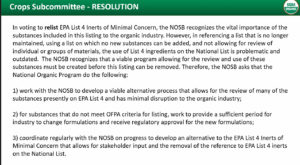
[Text from Resolution: In voting to relist EPA List 4 Inerts of Minimal Concern, the NOSB recognizes the vital importance of the substances included in this listing to the organic industry. However, in referencing a list that is no longer maintained, using a list on which no new substances can be added, and not allowing for review of individual or groups of materials, the use of List 4 ingredients on the National List is problematic and outdated. The NOSB recognizes that a viable program allowing for the review and use of these substances must be created before this listing can be removed. Therefore, the NOSB asks that the National Organic Program do the following:
1) work with the NOSB to develop a viable alternative process that allows for the review of many of the substances presently on EPA List 4 and has minimal disruption to the organic industry;
2) for substances that do not meet OFPA criteria for listing, work to provide a sufficient period for industry to change formulations and receive regulatory approval for the new formulations;
3) coordinate regularly with the NOSB on progress to develop an alternative to the EPA List 4 Inerts of Minimal Concern that allows for stakeholder input and the removal of the reference to EPA List 4 inerts on the National List.]
A resolution was drafted to the NOP by the Crops Subcommittee regarding EPA list 4 inerts.
Steve Ela moved to adopt the resolution, seconded by Jerry D’Amore.
- Vote: 15 yes; 0 no. Motion passes, resolution passed onto NOP to encourage work on this project.
Arsenic
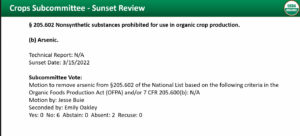
Buie: Comments suggest continuing to list arsenic as prohibited substance.
Motion to remove arsenic from 205.602 of the National List.
- Vote: 15 no; 0 yes. Arsenic remains a prohibited substance on the National List
Strychnine
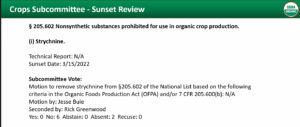
Motion to remove strychnine from 205.602 of the National List.
- Vote: 15 no; 0 yes. Strychnine remains a prohibited substance on the National List
Discussion Document: Ammonia Extract – petitioned
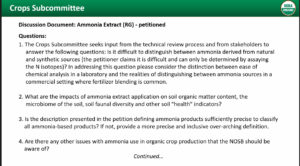
Mortensen: This is a petition to prohibit use of ammonia extract for use in crop production. Many comments simply suggested allowance or disallowance without answering the questions posed. This prohibition is being considered in part because the NOP in December 2000 prohibited or restricted the use of substances of high solubility, such as ammonia extract. Ammonia is used a lot in conventional agriculture, where anhydrous ammonia kills everything within a specified distance of application. The carbon to nitrogen ratio (about 3:1) is much higher than the ratio from cover crop residues (about 30:1).
Board asked whether this manure derived concentrated extract from other forms. It can be chemically discerned from conventional, but it would be very difficult to tell apart in the field. There were few comments regarding this material’s impact on soil health. Research shows it would have strong adverse effects on fauna diversity and result in an increased turnover rate of carbon in the soil. This is not what comments suggested. More research would be welcomed, but this material generally will not support biodiversity. Opines this is a problematic application for use in soil systems. Systems design and building a system though which crops are fed via soil health are preferred in organic. A lot of fertilizer dealers commented wanting more forms of fertilizer in organic production. Not surprising. A lot of comments said this is inconsistent with OFPA and soil health indications.
Jeffery: CDFA has been looking at this and Mindee can get their input as we move through this topic.
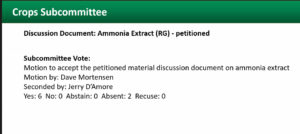
Discussion Document: Biodegradable biobased mulch (BBM) annotation change
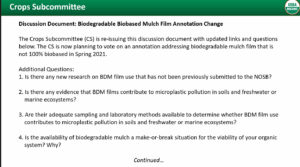
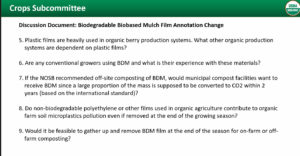
Bradman: The use of plastics in organic is exploding. Comments suggest plastic use is essential and that organic costs would soar without it. There is heavy use in crops and livestock operations (to protect feed or silage). Problem with residual plastics on organic farms. Overall concern and revulsion in organic community over this heavy use of plastic that is not recycled. Current listing to require 100% bio-based material is not practical. This product does not exist. Also, if it’s really biodegradable, we should consider reducing the requirements for how much is bio-based.
Stakeholders ask for NOSB to move forward on this essential material, while others are concerned about petroleum-based materials and microplastics in soil. Additionally, some bio-based products do not biodegrade. The EU is also developing rules about this. Considering the risks and benefits, we don’t have to argue the lesser of two evils, comparing BBM to plastic. However, the amount of plastic being used is astonishing. Comments indicated dissatisfaction with all four options offered by the NOSB. The proposal next spring will likely either be to leave this annotation unchanged or to allow a lower percentage of bio-based material.
Mortensen: Has seen a lot of plastic waste on farms. Need to move away from this level of plastic use. While 80% bio-based material is not ideal, it seems to him to be a lot better than these huge piles of plastic. Can we view this as one of perhaps three steps to get where we need to be? We can continue to seek innovation in this area. It’s clear from presentations before the board that biodegradation is not fully possible in the field.
Bradman: Agrees. This will require additional review down the road. Plastic is not seen as contaminating the soil directly, so it is considered acceptable, but this seems to him to be problematic.
Mortensen: We should be clear this is not essential. There are farmers in New England that use mulch. To do that at large scale would be challenging, clearly.
Bradman: Some farmers say plastic reduces labor and tractor runs as well.
Baird: Likes the idea of doing a graduation of steps. In 20 years of inspection, plastic is ubiquitous. Honest farmers will tell you there’s no way to get it all out of the soil. This proposal has got to be a better way.
Oakley: Plastic mulch is widely used, but many organic farmers do not use it (including Emily). It is very possible to grow profitably without it.
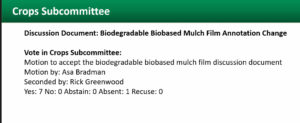
Cornucopia’s take: The use of plastics in organic production is a serious concern, but biodegradable bio-based milch films composed of petroleum-based products are not the answer unless and until the science shows they do not contribute to micro-plastic issues, impacting biodiversity, or soil health. Cornucopia would prefer the organic marketplace use the precautionary principle when approaching new technology like BBMs.
4:35 PM ET: NOSB Work Agenda; Officer Elections
[The NOSB work agenda will be found at at https://www.ams.usda.gov/rules-regulations/organic/nosb in the near future.]
Bradman: I don’t see List 4 Inerts on the work agenda. It appears that the board’s plate will be full in handling, but this is a high priority.
Ela: This will need to be added via a formal procedure.
Oakley: It was on the work agenda when she got on the board; is it really removed?
Ela: We will ensure it is on the agenda moving forward.
NOSB Officer Elections
Powell-Palm: Nominates Steve Ela for Chair.
Jeffery: Seconded.
[Great enthusiasm on the board, no other nominations for Chair.]
Rice: The board will maintain confidentiality of votes using Survey Monkey. In an uncontested situation like this, we don’t need to use that tool. [Ela asked Scott Rice to take over this process.]
Steve Ela is elected Chair.
Bradman: Nominates Nate for Vice-Chair
Nate Powell-Palm indicates willingness to be Vice-Chair. No objections.
Nate Powell-Palm is elected Vice-Chair.
D’Amore: Nominates Mindee Jeffery for Secretary.
Powell-Palm: Seconded.
Baird: Nominates Rick Greenwood for Secretary.
Greenwood: Declines.
Jeffery indicates willingness to be Secretary. No objections.
Mindee Jeffery is elected Secretary.
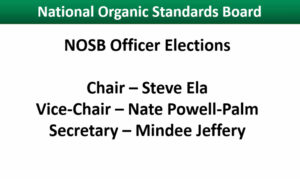
Farewell to outgoing NOSB members
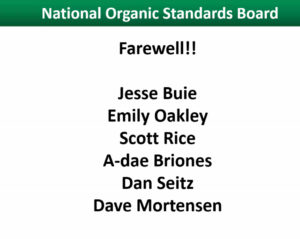
Ela: Heartfelt good-bye to outgoing board members as a group and individually.
[Notes that Dave Mortensen is resigning after the Sanitizer Panel, due to professional constraints.]
Briones: Thanks the other members. Speaks to organic integrity and how much work it takes (and will take).
Seitz: Spoke out against hydroponic production in organic. Hopes to curtail factory farms posing as organic. Notes these problems needs to be addressed.
Buie: Believes in protecting the integrity of the organic seal. Restoring stakeholder confidence requires the NOP to do it’s job. Expressed confidence that the NOP is going to do its job, which is why he voted as he did on EPA List 4 inerts, and this NOSB will maximize what it can do for stakeholders. I will use remaining time to get more minority farmers involved in organics and this process. The NOSB we have now is going to take us to the next level; and I am confident the NOP will do it’s job.
Ela: We need more diverse representation on the Board. Looks forward to Buie helping get more diverse representation, especially on the NOSB.
Rice: Thanks everyone who has assisted over the years. Hopes that he has served certifiers well.
Oakley: [Note: a copy of Emily Oakley’s full farewell was provided to Cornucopia, which we have posted here.]
I live in a so-called red state, and I can tell you that organic consumers come from all ends of the political spectrum, as do organic farmers. The organic label must remain above political pressure or changes in political agendas. Organics is organics regardless of who is in office.
Likewise, organics it’s not about who has the most money or who can hire the most lobbyists. Might does not make right in the organic system. Compromise and open, honest, and transparent collaboration are what’s needed for this organic democracy to work. Every voice must be heard with equal resonance, even those who may not have spoken.
Let us be guided by the principles that created and built the organic movement, and which sustains it to this day. The goal is not get big or get out, or about adopting the newest technologies. The goal is to nurture farm businesses that can provide fairly for the people who steward them, not by looking for the cheapest or easiest or even most efficient way, but by making a commitment to place, forming a relationship to the land they farm, and developing a sense of responsibility to the ecosystem around them and the broader global environment upon which the farm, and ultimately we all, depend.e
It has been a true honor to serve on the board. Thank you to the committed staff at NOP (especially Michelle, who makes it possible for us to do our work), to the remarkable folks willing to serve the organic community and uphold integrity on the NOSB (especially to Steve for his incredible leadership–this has been far away the most collegial of all my years on the board), and to the stakeholders who engage tirelessly in this process, often as volunteers themselves, in hopes of safeguarding the values and practices of organics. As another retiring board member once said, I will miss the people but not the work. Thanks for all you do, and I look forward to becoming just another organic farmer again.
Mortensen: Been a real honor working with the other NOSB members; sorry to be stepping down. Will continue to fight for ecologically-based farming.
Other business and closing remarks
Ela: The NOSB has created a sign on letter as individuals, encouraging the cost-share be reinstated at full cost.
The Sanitizer Panel will be coming up in November. The panel will help to review sanitizers as a group as stakeholders often ask for. Ela expresses hope that the incoming NOSB members will participate in the Sanitizer Panel.
[Ela then turns it back to the NOP.]
Tucker: Thank you to all the NOSB, especially the parting members. Thanks Steve Ela for facilitating. Mentions difficulties of the pandemic and how the NOSB still came together.
[Steve Ela declares the meeting closed.]
5:25 PM ET: NOSB Meeting Closes
Thursday, October 29, 2020: NOSB Meeting
12 PM ET: Call to Order, Agenda Overview; Handling Subcommittee
NOSB Chair Steve Ela welcomed everyone to the second day of the NOSB meeting. Today the NOSB will go through Materials Subcommittee and Handling Subcommittee matters.
A roll call showed all NOSB members were present. Ela then turned the meeting over to the Handling Subcommittee (HS) Asa Bradman, Chairperson.
Proposal: Low-acyl gellan gum – petitioned
Petition for low-acyl gellan gum.
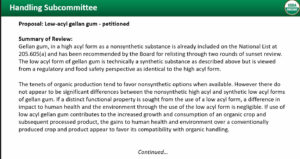
Rice: Gellan gum was added in 2010. The removal of acetyl groups was determined to make low-acyl gellan gum a synthetic. Low-acyl gellan gum is widely used in beverages and supplements and does not have a viable alternative that can be used in vegetarian hard and soft capsule manufacture. From a regulatory perspective it is identical to high-acyl gellan gum (as a synthetic). Option for use in vegan and veterinarian capsules is the most compelling reason to add this (because consumers have concerns about carageenan). Candy companies see this as functioning a little better in their formulations. Comments in opposition to this listing noted that there are alternatives and more synthetics are not needed on the list. Pullulan is another substance used as a vegetarian alternative for capsules [NOTE: pullulan is made from fermentation using particular microbes, usually from tapioca starch].
Oakley: Challenging listing because the comments about vegetarian capsule use are compelling but also thinks there should be a higher bar for adding to the National List.
Seitz: Clarifying that there are other materials that could meet manufacturer need, but not as ideally. Can you discuss further?
Rice: This comes down to how people feel about synthetic listings vs non-synthetic listing. Comments show there are not great options for the vegetarian capsule. Recalls pullulan discussion (can we link to that in our notes from that meeting???).
Ela: Wonders why the NOSB has separated high-acyl and low-acyl in listings?
Rice: Because low-acyl gellan gum will be listed as a synthetic, it is on a different part of the National List
Mortensen: Any insight into whether our approving this could influence the ability to sell an organic product abroad?
Rice: Important to note that materials may be listed differently in different regulations. Did not look into the trade implications.
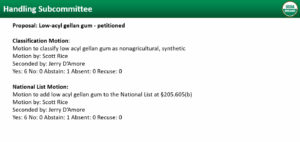
NOSB makes a motion to classify Low acyl gellan gum as a non-agricultural, synthetic.
- Vote: 15 yes; 0 no. Low-acyl gellan gum is classified as a non-agricultural synthetic.
Motion to add LAGG to the National list at Section 205.605(b).
- Vote: 14 yes; 0 no; 1 abstention (Oakley). Motion passe, Low acyl gellan gum is added to the National List at 205.605(b).
Proposal: Ion exchange filtration
Ela: Proposal referred to NOSB by the NOP. Complicated topic involving chemistry and regulatory processes. Few comments suggested it should not be allowed. FDA’s classification of ion exchange residues left in question whether these could be food contact substances. NOP has said that food contact substances are allowable. Others argue that organic should have a higher level of review than other agencies provide. Believes this leads to only the recharged materials needing to be on the National List. But are the resins inert? Do they degrade into the material being filtered? The Technical Review did not cover this well. Some comments suggested the resins to degrade but did not provide evidence. Should we wait for further review?
The recharge material could be present in the final product, but are the resins inert? The NOP has been somewhat fuzzy on this. Memos have been sent and some have been rescinded. There has been no guidance.
Bradman: Read the comments and proposal; sees complicated and challenging issues. Hoping to have some robust discussion on this.
Rice: Good comments from certifiers. There is nothing definitive from the NOP on this. Not generally a fan of having something in the regulations that requires guidance, but this is the case for it. Most certifiers are operating in parallel with the subcommittee recommendation here.
Ela: Are these resins degrading into the final food product? TR says not, but this has been called into question.
Oakley: Asked about comments from Emily Brown-Rosen and what the program’s comments are.
Tucker: The program has had inconsistency on this topic. Would like to see what the board does. They don’t yet have an answer as it is a very complex topic. Instructions as a general rule are used for topics that affect certifiers. For something that impacts the broader industry, as this would, it would be more appropriate for rule making or guidance. But will not speculate on that at this time.
Ela: Comes down to food contact; do the materials break down into the product? Most concerned with whether these materials leech into products? Further research into migration seems warranted; especially considering concerns raised in TR. We lack information as to what rate leaching may occur. Comfortable forwarding on to program with recommendation that only the re-charge materials should be listed but is open to discussion others who think resins contribute to the final product.
Mortensen: Has limited knowledge of this from tables used in research. Agrees that the exchange would result in some loss off the column. The membranes and resins age and as they do, their integrity drops, so they cannot be used indefinitely. Imagines that there are things coming off these exchange columns that are moving with the food at low concentrations, and probably increasing as column ages. We would want to have the substance that manufactures the membranes and resins reviewed, in that case.
Bradman: Has used some of these materials in the lab. Supports the recommendation, but is on the fence a little bit. Concern has been raised about BPA and migration into food from food packaging. More research warranted. Not sure this affects the decision right now.
Powell-Palm: Thinks about these issues as an inspector. This seems to be a legal question for food contact substances in general. If we say the degradation of materials in contact with food is under review, we will need to consider many materials in this way. Example of the boiler.
Mortensen: Helpful extension of the logic, Nate. The surface of a stainless steel vessel or something else unlikely to release compounds. We do know these materials are being released. Seems different, but it is a spectrum of leaching. We want to be careful with the intimacy of the degradation process during the aging of those columns.
Turner: Why would the resins not be included? What are the implications for pushing this material back for more research? WIll it put the listing in limbo for a long time or will we get research? Is it fundamentally unenforceable?
Rice: NOP asked us to make a recommendation. We’re not recommending addition of materials. Not adding anything that isn’t already there, just considering the material. To the program: What are our next steps?
Tucker: This is a new process. There’s been a certifier conflict on materials. This come back to certifier consistency. The memo caused more questions and so it has been put to the board. Certifiers continue to allow this as they believe is correct. If the board is unable to make a recommendation, the inconsistency will continue among certifiers. Certifiers are unclear whether this is a noncompliance or not. It would be difficult to issue a noncompliance at this point. Which inconsistencies are having the greater impact on the market? The NOP is seeking input on what to address first among certifier inconsistencies.
Rice: Coming from the certifier world, I think this is a priority. This is one that has been batted around for some time.
Mortensen: The precautionary principle. Could we word this to say that until we have better data, the resins and membranes should be on the National List?
Ela: The issue is that a number of manufacturers do this process with resins not on the National List. Some of these materials that we use in organic could be disallowed and it could cause significant disruption to the marketplace. Some products could disappear.
Mortensen: So if we vote no, it could mean we think it’s too restrictive or not restrictive enough.
Powell-Palm: Putting these on the List would not serve the purpose we are after. Which food contact substances should be considered? More legal guidance from NOP could help us across the broader range of materials for certifier clarity.
Ela: Do you want the board to work on this further? Or will we just allow certifier inconsistency?
Tucker: It is an open work agenda item now and will remain so unless the board asks otherwise.
Rice: Would like o vote on this to provide some certifier consistency. More time for the board to look at this will not likely help in this decision. The broader question about which materials should be included is a broader legal question for the program.
Powell-Palm: Agree.
Ela: Requests more data from commenters, especially regarding the break down and food contact issues.
Motion to approve the recommendation on ion exchange.
- Vote: 6 no; 9 yes. Motion fails, the NOSB will take this proposal back under consideration.
1:00 PM ET: Handling Subcommittee (HS) 2022 Sunset Substances Review
Kaolin
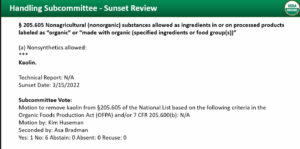
Huseman: Few comments were offered, most were positive. Suggestion there could be an alternative in use.
Bradman: Some concerns about this material in terms of the nano size of the material. An annotation would be beyond the scope of the sunset review before us.
Motion to remove kaolin from the National List.
- Vote: 15 no; 0 yes. Kaolin remains on the National List.
Sodium bicarbonate
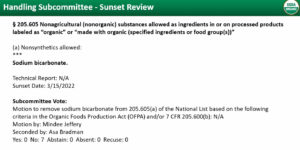
Jeffery: Essential substance with wide usage. No comments suggesting de-listing. Appreciates comparison to cornstarch and baking soda.
Motion to remove sodium bicarbonate from the National List.
- Vote: 15 no; 0 yes. Sodium bicarbonate remains on the National List
Waxes – nonsynthetic (Wood rosin)
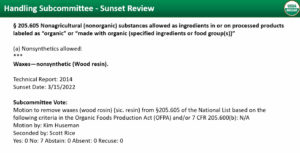
Huseman: Used for coating on fruits and other applications. Given the climate and export limitations, having wood rosin in the toolbox is needed, per comments.
Bradman: Like some other waxes used as fruit coatings and other products, this is an unlisted ingredient. It should be labeled. Recognizes concern about over-annotations, but there are concerns about how this material is manufactured.
Huseman: This is a recurring theme, such as in orange shellac. Further investigation is needed outside of sunset review. This coating may not always be used, complicating matters.
Motion to remove waxes (wood rosin) from the National List.
- Vote: 15 no; 0 yes . Waxes – nonsynthetic (Wood rosin) remain on the National List.
Ammonium bicarbonate
Jeffery: General support for relisting.
Motion to remove Ammonium bicarbonate from the National List.
- Vote: 15 no; 0 yes. Ammonium bicarbonate remains on the National List.
Ammonium carbonate
Jeffery: Minimal uses with some essentiality. One commenter suggested de-listing.
Motion to remove Ammonium carbonate from the National List.
- Vote: 15 no; 0 yes. Ammonium carbonate remains on the National List.
Calcium phosphates (monobasic, dibasic, and tribasic)
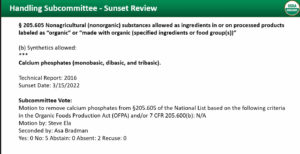
D’Amore: Spring 2020 meeting included 20 comments, largely in support of relisting. Potential health issues have been indicated as possible, but research found no single phosphate can be implicated in health issues. Calcium phosphates are considered essential.
Motion to remove calcium phosphates from the National List.
- Vote: 15 no; 0 yes. Calcium phosphates remain on the National List.
Ozone
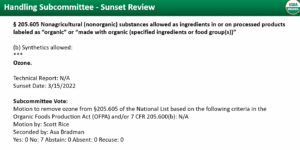
Rice: Comments in spring and fall indicate support for relisting. Note that ozone should be looked at in overall review of sanitizers.
Motion to remove ozone from the National List.
- Vote: 15 no; 0 yes. Ozone remains on the National List.
Sodium hydroxide
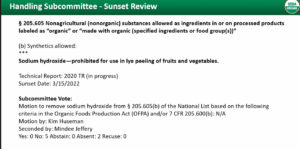
Jeffery: Comments reflected wide and essential usage; support for relisting. Some asked for annotation to limit the use after investigation of essentiality.
Motion to remove sodium hydroxide from the National List.
- Vote: 15 no; 0 yes. Sodium hydroxide remains on the National List.
Carnauba wax
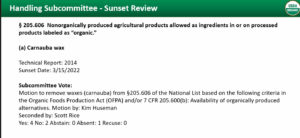
Huseman: Quite a few comments were made in the fall. This wax is not an everyday tool, but it is used on pears and other fruits during times of year when the wax on the fruit is suboptimal. In some cases, an organic form is sufficient to purposes, in other applications organic does not work. Industry and producer comments helped. Some concern around use of solvents for extraction.
Mortensen: Please explain the split vote in subcommittee?
Huseman: Availability of organic forms was part of the discussion and there is ample organic supply in the market. Are there synthetics involved in extraction that may be prohibited? But the organic form may not be appropriate for all uses.
Bradman: Feels like comments are mixed up. Refer to vote to remove it from 606, but this is not the issue. If we remove it from 606, it’s still available but must be the organic form. Does not have good data on the availability of organic carnauba wax.
Ela: What’s your gut feeling, Kim? Anything further?
Huseman: Appreciated depth of fall comments. Cannot discredit what seems to be enough carnauba wax in organic form to fill the need. Does not have enough information to determine whether the organic form is sufficient to the uses. Will vote to keep it on the National List. Asks that those using the non-organic form look hard at their options.
Motion to remove carnauba wax from the National List.
- Vote: 11 no; 3 yes; 1 abstention. Motion fails and Carnauba wax remains on the National List.
Colors (18)
[NOTE: there are 18 total colors up for sunset review. The following will be voted on: Colors Beet juice extract color, Beta Carotene, Black Currant juice color, Black/Purple Carrot Juice color, Blueberry Juice color, Carrot Juice color, Cherry Juice color, Chokeberry/Aronia Juice color, Elderberry Juice color, Grape Juice color, Grape Skin Extract color, Paprika color, Pumpkin Juice color, Purple Potato juice color, Red Cabbage Extract color, Red radish Extract color, Saffron Extract color, Turmeric Extract color]
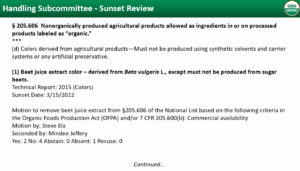
D’Amore: About 87% of the commentors were in favor of re-listing. Only 20% of commenters responded to individual colors. All others commented on the full slate. This is a complex group of listings.
Greenwood: We are about to vote on 18 items as one vote; consent agenda is already in play.
Ela: We are voting on these individually. You are correct historically. One large manufacturer of organic colors noted they can make any color with cost being the only factor. Other commenters claimed to be unable to source some colors organically.
Mortensen: If we allow the non-organic form when it is available organically, we are demotivating organic production. Concerned we are creating a disincentive to the private sector to move organic materials forward in the marketplace.
Turner: Did the subcommittee have any industry evidence about availability of supply?
D’Amore: Varies throughout the colors. Feels out on a limb with some recommendations to de-list.
Ela: Relied on stakeholder comments, but they were not very clear overall. Jerry reached out to many stakeholders individually, so he does have some evidence.
Jeffery: There is impetus to move in the direction of functional organic colors (organic does not always provide the color manufacturers seek).
Ela: But when you drill down, some companies claim adequate supply of some organic colors but did not name those colors.
The NOSB then moves to vote on each individual color.
Beet juice extract
Motion to remove Beet juice extract color from the National List.
- Vote: 15 no; 0 yes. Motion fails; Beet juice extract color (nonorganically produced) remains on the National List.
Beta carotene extract color
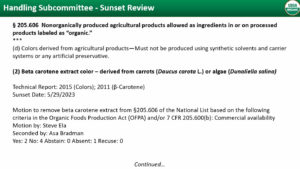
D’Amore: Adequate supply of organic is a concern. Recommends relisting.
Motion to remove Beta carotene extract color from the National List.
- Vote: 15 no; 0 yes. Motion fails, Beta carotene extract color (nonorganically produced) remains on the National List.
Black Currant juice color
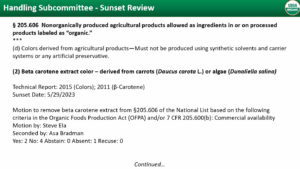
D’Amore: Comments and industry research suggest there is an increase in suitable supply of organic.
Motion to remove Black Currant juice color from the National List.
- Vote: 0 no; 15 yes. Motion passes, Black currant juice color (nonorganically produced) is removed from the National List.
2:05 ET: Lunch Break; the NOSB will reconvene at 3pm ET
3pm ET: Handling Subcommitte Con’t, Colors
Black/Purple carrot juice color
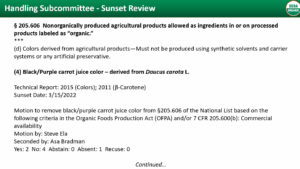
D’Amore: Recommends this one be relisted for inadequate suitable supply for an organic alternative.
Turner: Are these colors similar (black carrot vs black currant)?
D’Amore: Will address this moving forward. There is also an issue of seasonal availability.
Ela: There can be issues that a color is available but is the wrong hue, or the hue is unstable.
Motion to remove Black Currant juice color from the National List.
- Vote: 15 no; 0 yes. Motion failed, black/Purple carrot juice color (nonorganically produced) remains on the National List.
Blueberry juice color
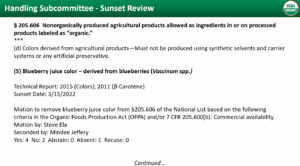
D’Amore: Comments offered no new challenges and recommends it be removed based on availability. (Is a blueberry grower himself.)
Motion to remove blueberry juice color from the National List.
- Vote: 2 no; 13 yes. Motion passes, blueberry juice color (nonorganically produced) is removed from the National List.
Carrot juice color
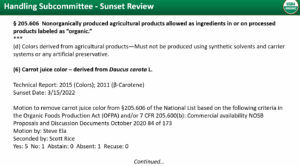
D’Amore: Comments were split on the availability of this. The issue is batch to batch color conformity and uniformity of color. Recommends removal based on adequate commercial availability.
Bradman: Colors are an interesting component of food processing. Engaged in study of health implications. Plant-based colors have better marks on safety in general. Colors have no impact on quality of the food but do affect consumer opinion.
Motion to remove carrot juice color from the National List.
- Vote: 0 no; 15 yes. Motion passes, carrot juice color (nonorganically produced) is removed from the National List.
Cherry juice color
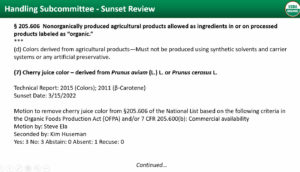
D’Amore: Subcommittee vote was split. Recommends removal of this color due to adequate availability of an organic alternative.
Motion to remove cherry juice color from the National List.
- Vote: 0 no; 14 yes; 1 absent. Motion passes, cherry juice color (non-organically produced) is removed from the National List.
Chokeberry/Aronia Juice color
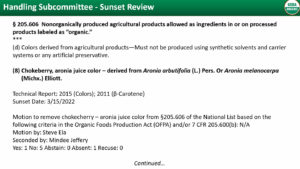
D’Amore: Recommends relisting due to inadequate availability of organic alternative.
Motion to remove cherry juice color from the National List.
- Vote: 14 no; 0 yes; 1 absent (Baird). Motion fails, chokeberry juice color (non-organically produced) will remain on the National List.
Elderberry juice color
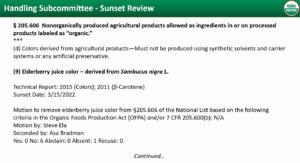
D’Amore: New comments support that this color is short in organic supply. Recommends relisting for this reason.
Motion to remove elderberry juice color from the National List.
- Vote: 14 no; 0 yes; 1 absent (Baird). Motion fails, elderberry juice color (non-organically produced) will remain on the National List.
Grape juice color
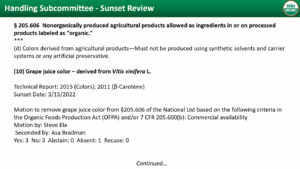
D’Amore: Subcommittee had a split vote. It is a coordination issue rather than organic availability issue. Inconsistent color from organic grape juice. Recommends de-listing.
Mortensen: Thought on consistency: There are a number of different grapes grown with enormous variability of color. Can imagine the difficulty of getting a specific grape color that can be functionally part of a processing chain.
D’Amore: Asked himself what is the difference between organic and conventional grape production. Does conventional production actually alter the state of the product? Has never seen a distinction of the properties of organic and conventional blueberries in his experience. Does not believe this can be an issue with grapes either.
Mortensen: So the variation of color from conventional to organic is not great?
D’Amore: Right.
Huseman: Are there opportunities for some of these colors to be used interchangeably? Noting the next one is grape skin.
D’Amore: Finds these to be two different items entirely.
Baird: Heard in the past form constituents that availability of raw product does not mean there is enough byproduct left to make colors.
D’Amore: The availability of raw product is there. Sometimes we go with the flow and end up stifling innovation. Efforts must be made by the color industry.
Baird: Another argument offered has been that the color processors won’t stop a conventional process to just do organic colors.
D’Amore: Thinks the issue of cleaning equipment between runs can be legitimate. But the volume of use may be as small as 10-15 tons per year. Could not get to the volume of use with this color, so feels less robust on his stance on this one.
Motion to remove grape juice juice color from the National List.
- Vote: 0 no; 15 yes. Motion passes, grape juice color (non-organically produced) is removed from the National List.
Grape skin extract
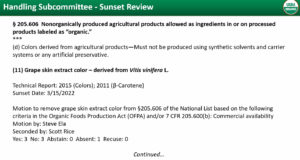
D’Amore: Organic inputs seem to be limited in this case. Recommends relisting. One issue is that the grape skins are a waste product from the wine industry and this is a beneficial use.
Motion to remove grape skin extract from the National List.
- Vote: 15 no; 0 yes. Motion fails, grape skin extract (non-organically produced) will remain on the National List.
Paprika color
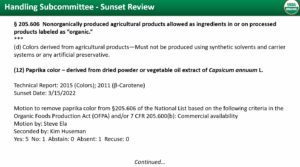
D’Amore: Recommends delisting based on adequate supply of organic alternative.
Motion to remove paprika color from the National List.
- Vote: 0 no; 15 yes. Motion passes, paprika color (non-organically produced) is removed from the National List.
Pumpkin Juice color
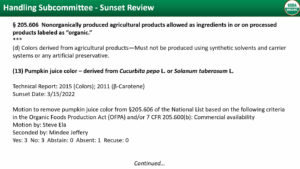
D’Amore: Recommends de-listing this color. When the community knows in advance that the vote is split and it provokes no reaction from the community, it tells a lot.
Motion to remove pumpkin color from the National List.
- Vote: 0 no; 15 yes. Motion passes, pumpkin juice color (non-organically produced) is removed from the National List.
Purple Potato juice color
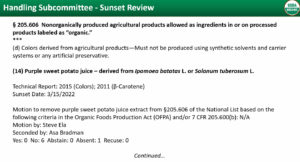
Motion to remove purple potato juice color from the National List.
- Vote: 15 no; 0 yes. Motion fails, purple potato juice color (non-organically produced) will remain on the National List.
Red cabbage extract color
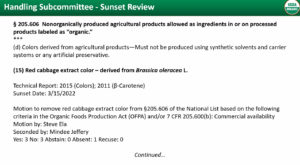
D’Amore: Believes relisting is needed due to lack of availability of organic alternative.
Bradman: Understood there were 24 listing in the Organic Integrity database.
D’Amore: This claim is made of potential and not of actuality, according to those he spoke with. Believes this would create undue hardship, but it’s a weak case.
Turner: Does availability of organic color correlate to lack of availability of organic red cabbage?
D’Amore: The entire category of color is around optics. No.
Mortensen: This crop is rarely seen in the East and Northeast outside of small markets.
D’Amore: Largest reason I’m advocating to relist this color.
Motion to remove red cabbage extract color from the National List.
- Vote: 15 no; 0 yes. Motion fails, red cabbage extract color (non-organically produced) remains on the National List
Red radish extract color
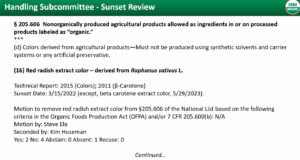
D’Amore: Found no new information in comments, so recommending to relist this color. Has no better information.
Motion to remove red radish extract color from the National List.
- Vote: 15 no; 0 yes. Motion fails, red radish extract color (non-organically produced) remains on the National List.
Saffron extract color
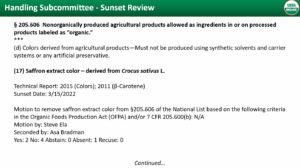
D’Amore: No real effort to show support from the stakeholder community. Recommends delisting because the community is ambivalent at best. No comments strongly supported the need for this. Conflicted. This vote will show which side we err on: possible disruption of commerce or encouraging innovation.
Rice: Rationale for keeping red radish on the list was because we had not heard from anyone. Thinks saffron is likely harder to secure.
D’Amore: Distinction is that with red radish, got a response that could be used. With saffron, unclear how much this is even used. Little response. Your request for logic is well-made.
Mortensen: Seen this grown. If flowers are used for color, that’s a lot of flowers to extract pigment from.
Baird: Someone petitioned this; they needed it. Wonders if they did not realize they needed to come back to comment. Seems they still need it now.
D’Amore: This is an orphan crop. When grown, it is specifically grown for this purpose. Possibly just feeling irritated at not getting anyone to comment, which he concurs is not the best course of action.
Powell-Palm: OTA comments noted two counts for need.
Motion to remove saffron extract color from the National List.
- Vote: 14 no; 1 yes (Ela). Motion fails, saffron extract color (non-organically produced) remains on the National List.
Turmeric extract color
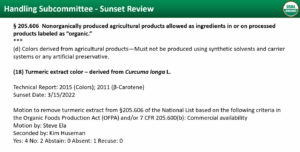
D’Amore: Recommends de-listing. Stakeholder response has been lackluster in terms of relisting. Comments note the organic supply is primarily off-shore and suspect for fraud.
Motion to remove turmeric extract color from the National List.
- Vote: 4 no; 11 yes. Motion passes, turmeric extract color (non-organically produced) was removed from the National List.
4pm ET: Handling Subcommitte Con’t, 2022 Sunset Substances Review
Glycerin
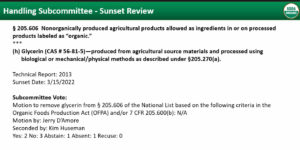
D’Amore: Nearly all comments favor keeping glycerin on the National List. Split vote on subcommittee. Learned glycerin has a wider use than initially realized. Recommends relisting.
Seitz: Potential large organic supply available; how did you arrive at this opinion?
D’Amore: Adequate and suitable availability research suggests it would be disruptive to de-list this material. Seems to be more need for this than organic supply can meet.
Oakley: Understands the greater need, but would the organic production not meet production needs?
D’Amore: Glycerin is used in flavors.
Baird: Seems that the functionality is in question.
Powell-Palm: Reminder that 606 materials can be petitioned off at any time. If we find the supply, we can remove this material.
Bradman: Concerns that this listing is as a fermentation product and not agricultural.
Motion to remove glycerin from the National List at 205.606.
- Vote: 13 no; 2 yes. Motion fails, NOSB recommends glycerin remain on the National List.
Inulin-oligofructose enriched (IOE)
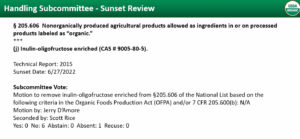
D’Amore: Most comments were in favor of relisting. Subcommittee supports relisting for its distinct lack of functionality for alternative products.
Motion to remove IOE from the National List at 205.606.
- Vote: 15 no; 0 yes. Motion fails, NOSB recommends IOE remain on the National List.
Kelp
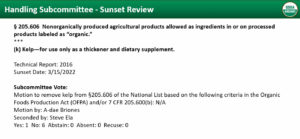
Romero Briones: Kelp is a very ambiguous term; can refer to many kinds of algae and seaweed. The Latin binomials are used elsewhere. Referenced discussion document around marine algae. Opinion that 606 can sometimes be used as a loophole and remain there, even with petitions asking for substances to be removed. It becomes more and more difficult to remove items from 606; that’s problematic.
Oakley: We cannot underscore enough the challenge of having a word like kelp on the National List. It is very broad. Many kelps are available in organic form, but it is unclear which kelps are being used in production. Difficult to say what is available organically or not when the term is so general.
Bradman: Kelp is under a lot of stress and the populations off the northern California coast and Tasmanian coast, populations are collapsing. Kelp is under a lot of stress; vulnerability related to disruptions from climate change and changes in overall ecology. Seaweeds are very important to many cultural and culinary traditions. Seems like the organic wild crop category may be appropriate for this material.
Oakley: Agrees. If you buy seaweeds in grocery store they are being certified organic to wild crop standard.
Romero Briones: Discrepancies between 606 and livestock feed provision. Livestock feed is required to be organic.
Motion to remove kelp from the National List at 205.606.
- Vote: 4 no; 11 yes. Motion passes, NOSB recommends kelp be removed from the National List.
Orange shellac-unbleached
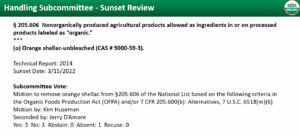
Huseman: This shellac comes from an insect. Used in jelly bean coatings, with few alternatives. The trees where the insects reside are in question; perhaps we should look at a limited TR for insecticide use. This is an alternative to low-acyl gellan gum. Commercial availability of organic alternative is low. Supports relisting.
Bradman: Wants to follow up with an annotation on these types of materials.
Motion to remove orange shellac from the National List at 205.606.
Vote: 15 no; 0 yes. Motion fails, NOSB recommends orange shellac remain on the National List.
Starches: Cornstarch (native)
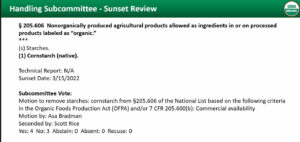
Bradman: Cornstarch is a thickener in many foods and in the processing of baking powder. There are many companies that produce organic cornstarch. Many comments in support of delisting. Some manufacturers say the organic alternative is not as available at the same level of functionality or quality. Subcommittee discussion focused on what availability means. If there are needs for special forms of cornstarch, those should be petitioned separately. Would like to address the need for specialized forms through annotation and relist here.
Jeffery: Learned a lot about this material and has changed mind about de-listing. Sees important and specific functionality uses and seeks the annotation solution.
Rice: Good candidate for addressing via annotation and supports relisting.
Mortensen: Struggling with this one. Worries if the board doesn’t send a signal, while organic grain growers struggle to get a fair price.
Motion to remove cornstarch from the National List at 205.606.
- Vote: 9 no; 6 yes. Motion fails, NOSB recommends cornstarch remain on the National List.
Starches: Sweet potato starch
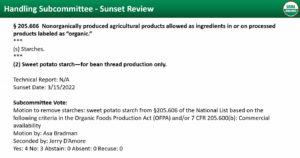
Bradman: Similarities with the discussion of cornstarch, nut there has been almost no public comment on this material. The subcommittee was split. There is almost no information available on use. Oregon Tilth suggested 16 of their operations use the organic form only. One other reference did not note whether the material was organic. Recommends de-listing.
Motion to remove sweet potato starch from the National List at 205.606.
- Vote: 3 no; 11 yes; 1 absent. Motion passes, NOSB recommends sweet potato starch be removed from the National List.
Turkish bay leaves
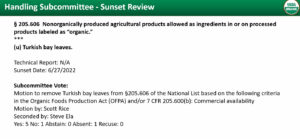
Rice: Did not receive many new comments in the fall, and most support de-listing. It appears organic supply has met demand and the supply is stable.
Motion to remove turkish bay leaves from the National List at 205.606.
- Vote: 0 no; 15 yes. Motion passes, NOSB recommends turkish bay leaves be removed from the National List.
Whey protein concentrate
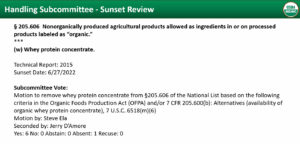
Romero Briones: Discussed this thoroughly in subcommittee. Comments almost unanimously agreed it should be de-listed. It was voted unanimously for removal in 2015, but the NOP opted to keep it listed. WODPA and CROPP noted it is available in organic form to meet demand. [Notes that the NOSB previously voted to remove this substance in 2015, but the NOP choose to continue its listing.]
Motion to remove whey protein concentrate from the National List at 205.606.
- Vote: 0 no; 15 yes. Motion passes, NOSB recommends whey protein concentrate be removed from the National List.
Discussion Document: Whey protein concentrate – petitioned for removal
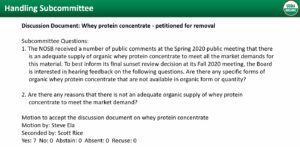
Ela: Whey protein concentrate was de-listed via sunset review. The rule making did not go through last time, so recommends keeping the petition to remove on the record. We will let it sit just in case the de-listing does not go through on sunset, so we can continue to try and de-list this product.
At this time Steve ELA notes that the meeting is running overtime. Ela suggested a schedule change, moving the Proposal: Research Priorities 2020 to tomorrow’s schedule.
5pm ET: Materials Subcommittee (MS), Marine Macroalgae
Proposal: Marine Macroalgae in Crop Fertility Inputs
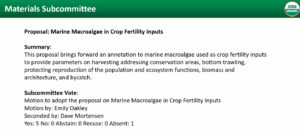
Oakley: The proposal recommends two annotations with ultimately a five year phase-in. [Goes on to summarize comments on this issue in general.]
Opposed commenters: cover substance and process. One certifier concerned that some manufacturers could not meet parameters, would an affidavit of harvest parameters be required? Harvest site visit not required by parameters proposed by MS. How can inspectors verify what bycatch is acceptable, and what occurs? Should be taken up by sci task force. Another commenter: affidavits not effective in real-world. Farmers concerned about impacts on supply. Companies who harvest and purchase: in general are not in support of proposal, ask sent back to MS. Companies seem to want the status quo to remain in place. Some in opposition questioned legal authority. Legal authority for this work is found sec 6518 of OFPA: the NOSB IS authorized to develop proposed National List additions and amendments. In short: NOSB does not require a petition to suggest annotations.
There were questions and concerns about proposed harvest areas: conservation areas should be addressed through scientific task force.
Other commenters mentioned prohibited methods issues. Prohibited methods being methods included those that harm reproduction [of the seaweeds]. “Repeat harvesting” was mentioned by one scientists, and suggested that “undisturbed natural stands” should be amended to include “undisturbed by harvesting”.
Bycatch issue: commenter suggested that “monitored and prevented” language be amended to “monitored and minimized”. Scientists said the latter was too subjective [noted that this language was already suggested, reviewed, and discarded for this reason]. Harvesters should take steps to prevent bycatch.
Important to note that the Subcommittee only heard from one commenter that personally harvests (rockweed in Maine), and they said that they could support the proposal if the annotation in sec. 602 were removed.
Summarizing comments in favor: Wide-ranging support for proposal. Some supported the proposal but worried it did not go far enough; many said rockweed should be specifically prohibited. Certifiers said these annotations were generally supported. Some commenters noted that “Environmental impact” does not just applying to farm, but inputs as well.
Conservation organizations were concerned about loss of habitat and loss of detritus. Rockweed is important lobster habitat. In general conservation groups were in favor of the proposal, with some suggestions for edits for more specific protections. Harvesters may not know that harvesting in protected areas is not allowed without specific prohibition [in general harvesters were criticized by conservation organizations by not being careful enough; over-harvest a concern].
Scientists supported the annotations as a good “middle path”, though some suggested stricter language.
Macroalgae research shows how they are important species, and improper harvesting can do lasting damage to ecological systems. Other stakeholders specified that these guidelines set out in proposal are general and specific guidelines will need to be adapted to each species [as the needs are different].
[Oakley continues discussion.]
If the NOSB votes to approve the proposal:
- NOP goes on to create scientific task force, provide recommendations for guidance, and if needed any suggestions for clarifying annotation language.
- Proposal cover letter would spell out areas of public comments to guide recommendation and eventual rule making.
- Proposal would go through rule making. Then it would have 5-year phase in.
Only a few dozen species are used in organic inputs. The task force could start specifying which species are relevant; then how each should be dealt with concerning individual needs. Coastal indigenous tribes often restrict or control harvest in their areas, or can be impacted by harvest. These tribes will need to be consulted.
Macroalgae harvest parameters attempt to make sure harvest is sustainable.
Voices calling for this to be sent back to subcommittee; Oakley notes that comments are general concerns of interpretation that can be addressed by ask force. In general scientists and stakeholders are supportive in general. Changing annotation could risk losing scientific support.
Oakley’s question to the rest of the NOSB: What specific comment concerns do you think need to be addressed? Scientists are telling us these parameters are sensible, and do-able. Oakley recommends we move this vote forward today.
Turner: Responsibility to advance most conservation thinking.
Bradman: Thank you to Oakley. Agree that should vote on it today and not send back to subcommittee. Special responsibility that we are going into a different environment to extract, then put them on land to grow food for ourselves. Marine materials have been used a long time; considered an ecological way to cycle resources. But that imposes on us a special responsibility. Climate change and changes in seaweed populations and marine environments in general set the stage. These materials are used a lot of fertility, foliage application (which are feeding the plant, not the soil). We are almost invading another environment, similar to fish harvest and usage on land. This is an important first step.
Mortensen: The boundaries we place around sustainable organic production cannot end at the field or farm, when we are relying on products from ocean. It’s a daily subject of depleted fisheries and struggling lobster industry on the East coast where he lives. Specific critiques about biomass, etc. those critiques and concerns can and should be addressed by the task force. Those concerns need to be taken up by another group. Moving forward on ecosystem-service thinking the same way the Boards thinking on native ecosystem issues; this is a consistent next step. Also think the Board should move forward with vote and not send this back.
Seitz: Having written regulations and policy for 30 years, it’s the ones that pertain to most complex subjects that are most difficult to craft in a way to satisfy everyone. No matter what we draft it will be open to criticism. This is the middle ground—realistic, open to strengthening over time. This has already gotten extensive input; support voting on this and urge others to support this.
Greenwood: Being number 4-5 in line, everyone has already said what I want to say. Thought: some of this is like “strip mining”; don’t want to look back 20 years and wonder what we were doing destroying land. There is urgency here and he supports the proposal.
Romero-Briones: Live in a family that relies on subsistence seaweed harvesting, and come from a community that relies on subsistence farming. The tribal community remains alarmed about commodification of seaweeds and over-harvest. Many of tribe that relied on seaweed harvesting found their seaweed beds decimated and damaged by harvesting.
These historical tribal beds have been harvested for over 250 generations, and to see it depleted in the course of 2 seasons is very alarming. Struggled with this proposal because tribal communities do not want the government to have a hand on these traditional beds. In support of proposal, but want to stress that there must be an inclusion of tribal communities. Some of beds being harvested in conservation areas and state parks are historic harvest beds; support proposal with those emphasis and concerns. Over-harvest and destruction is occurring; tribal livelihood and life is also at risk.
Rice: Share concerns already expressed; marine environment needs to be looked at in lens of buffering climate change issues. Full support of protecting of ecosystems, especially as diver. Nest step as task force, then rule making, then guidance. Concern about relying on guidance: it’s helpful but it is not the regulation, which is difficult from certification end. Yes guidance can be helpful, and in this case it’s probably necessary because of complex topic. Deep hesitation when we look at handbook and don’t see anything added. There are a lot of angles in this that would need to be fleshed out since we are talking about a practice standard of harvest. In support in theory and hesitant about the process.
Baird: Rice just articulated my hesitation with process. We all want to protect aquatic ecosystem, but the process from what I’m hearing has not quite been followed. Normally we put forth full proposal, with a paper, then time to comment, then review. We’ve heard that folks say they have not had time to look at full proposal. I cannot vote on this in the positive because it appears our process has not been followed correctly.
Oakley: Re: the process; do you write long annotation that needs fleshing out. The wild crop standard itself is broad and vague and interpretation of it is based on guidance from NOP and certifying community. Think that a lot of angles would need to be fleshed out, does not preclude moving forward. That’s just the nature of this process. We are not able to address every point. Something of this nature really does require a scientific task force, and the task force should include a wide range of stakeholders (including tribal communities). Given the complexity of this situation, it is possible to move this forward. Process points Baird brought up: the process has varied quite a bit regarding whether a discussion document is brought up first. From harvester perspective, we specifically requested comments from harvesters throughout this process, and really they declined to provide comment. I wish they’d told me at the time they needed more time, or were more constructive. Despite that, harvesters did give us substantial comment this time around. If we vote this forward, in the cover letter it will be quite long to address all the areas of concern. Perhaps concerns of harvesters could be addressed first by task force.
Jeffery: Interested in “stewards of place” in tribal sovereignty; can tribal communities be exempt from parameters. Could that be fleshed out in guidance?
Oakley: I know A-Dae mention subsistence harvest, which would be exempt potentially. I agree and feel strongly that we defer to tribal sovereignty in all areas. This is something else that could be a first step to ensure this is clearly addressed in language.
Jeffery: Process-wise, adding something like tribal sovereignty would be the only reason I vote to have this go back to sub-committee. Is this a sticking point to anyone else; can someone shed light?
Ela: We can often add details like this in our cover letter to the NOP when we pass a motion. We can provide small tweaks in cover letter along with our rationale. Another way is that we specifically include it in the proposal. Some of these things can go around in circles. I can’t tell you exactly, but it could be included in cover letter to the NOP [so that they know these issues are important ones to consider moving forward].
Tucker: As part of any process we do in USDA there is a tribal office and we do tribal consultations. It’s part of the standard process and in this case it would be an important consideration. [Notes she needs to go mobile with the meeting running long, but will still be listening in, audio-only.]
Huseman: Thanks Oakley. Her questions answered by other discussion.
Buie: I would like to see this move forward, but if there are procedure issues, we have to deal with let’s see what we can do to get it corrected.
Ela: Can’t speak to broader procedural issues. Not uncommon to go straight to a proposal without a discussion document in between; and Emily has already put several discussion documents on this topic forward, even if it wasn’t with this specific annotation. The procedure isn’t different, so I’d like the decision to be made on the substance only and not based on the procedure.
Powell-Palm: First year on NOSB; this is an important issue and the earlier comments made about the respective impact organic farming has on these ecosystems is necessary to consider. I would like to see us proceed so that this annotation moves to become a rule. Worry that the consistent information we got during commenters, with having none of them supporting the annotation in general, worries that if we pass this it will not have a lot of viability. Would like to see it as viable as possible from a rule making process.
Oakley: Wanted to address some of these issues. Spell out how much effort was put into getting feedback; feels effort was not met with much enthusiasm: I asked two different individuals to pass onto OTA marine materials task force whether or not language was feasible; asked if it covers what they are already doing, and was told someone was talking with harvesters. Need to demonstrate an environmental need for this proposal., Told to solicit feedback from specific scientists, which was then done. The scientists then gave feedback and were helpful in crafting final language. Tried to provide environmental perspective by coming through scientific literature.
Another question raised by harvesters was sec. 602 comment; the NOP said that we could make that annotation suggestion as a Board. So if you want to see this proceed, then that is voting on it now. Sending it back now will mean it’s likely to not become a rule making.
The primary recommendation from the harvesters, aside from interpretation of language, is that the annotation be re-written that the review be tied to 3rd party entities. The 3rd party review is the status quo; that’s what harvesters want. There are serious issues with this suggestion. The public comment in majority is supportive of this version. If we send it back it’s just going to lead to the same kind of opposition; think that this is the time to capture the greatest number of NOSB members that were involved in the panel. Sending it back will require a re-invention of the wheel. Don’t forget how many stakeholders we did hear from saying that this is adequate; this is ready to go. This can be voted forward and then all voices can be heard through scientific panel process.
Mortensen: I feel strongly about sending it back: don’t let perfection be the enemy of the good. We could nickel and dime this for 10 years. The panel will help resolve the detailed issues. If we don’t act and support this now we won’t be coming back to this anytime soon, and it’s too critical not to act on this now. We need to put this forward to say we support an sustainable organic system.
Rice: Form another process point: we have a host of recommendations that have not been moved on by NOP. Native ecosystems went through some time ago and we haven’t seen traction on that. How would we see that this moves somewhere and gets on regulatory agenda? This NOSB makes fantastic recommendations, but we need some assurances these things move forward.
Oakley: I concur with Rice. I think voting on this increases likelihood because the NOP will see we are moving forward with “continuous improvement”. Having another proposal on their desk increases their chance they will start working on these issues and not see them as outliers and anomalies.
Ela: We will move to vote.
Motion to adopt the proposal on marine macroalgae in crop fertility inputs.
- 13 yes, 2 no. Motion passes; the NOSB has adopted the proposal as it stands on marine macroalgae in crop fertility inputs.
6:05pm ET: NOSB meeting adjourns for the evening
Wednesday, October 28, 2020: NOSB Meeting
12 PM ET: Call to Order, Agenda Overview, Introductions
Dr. Jennifer Tucker, Deputy Administrator of the National Organic Program (NOP), welcomes all to the Spring 2020 NOSB meeting. This meeting is being held remotely due to the impacts and closures from the COVID-19 virus.
Tucker thanked Jesse Buie, Emily Oakley, Dan Seitz, A-dae Romero Briones, and Scott Rice for their service on the board, noting this is the final meeting of their terms.
NOSB Chair Steve Ela welcomed the five new board members: Amy Bruch (Farmer seat),Logan Petrey (Farmer seat),Dr. Carolyn Dimitri (Public/Consumer Interest Seat), Brian Caldwell (Public/Consumer Interest Seat), and Kyla Smith (USDA-accredited certifier seat).
NOSB member attendance:
Organic Producers
Jesse Buie (January 2016 – January 2021)
Emily Oakley (January 2016 – January 2021)
Steve Ela (January 2017 – January 2022)
Nathan Powell-Palm (January 2020 – January 2025)Environmentalists / Resource Conservationists
Asa Bradman (January 2017 – January 2022)
James R. “Rick” Greenwood (May 2018 – January 2023)
Wood Turner (January 2020 – January 2025)Consumer / Public Interest Advocates
Dan Seitz (January 2016 – January 2021)
A-dae Romero-Briones (January 2016 – January 2021)
Sue Baird (January 2017 – January 2022)Handlers / Processors
Kimberly Huseman (January 2020 – January 2025)
Gerard D’Amore (January 2020 – January 2025)Retailer
Mindee Jeffery (January 2020 – January 2025)Scientist (Toxicology, Ecology, or Biochemistry)
Dave Mortensen (January 2017 – January 2022)USDA Accredited Certifying Agent
Scott Rice (January 2016 – January 2021)
Secretary’s report (acceptance of Spring 2020 meeting summary as official record)
Jesse Buie, NOSB Secretary, offered the minutes from the last meeting for acceptance. The Board agreed.
NOSB report
Steve Ela, NOSB Chairperson, thanked the board and NOP staff. He noted that, while virtual meetings allow more attendance and save our carbon footprints, Steve opined that it will be good to return to in-person meetings. He has found in-person meetings more helpful for building relationships and allow for deeper discussion.
Ela suggested that the organic community should consider contentious issues with a willingness to compromise. Thorny issues make consensus unlikely.
He reported that rule making is a complex activity, including input on economics and law. Appreciates the efforts of the NOP in rule making.
He voiced that the overlap of comment periods for the NOSB meeting and the SOE was unintentional. It was necessary based on the timelines involved. He noted that some comments questioned the Sanitizer Panel meeting outside the meeting and clarified that this is not unique to this meeting. It allows the NOSB to spend more time on complex issues.
NOP Update
Dr. Tucker offered the NOP update in the Organic Integrity Learning Center. She acknowledged that certifiers have found new ways to ensure organic integrity during the pandemic.
Origin of Livestock update: The “Origin of Livestock” rule making (OOL) continues to be a program priority. There are a complex set of variables and legal questions. The organic community had expected a final rule this summer, as had the NOP, but the final rule review found specific legal questions that could jeopardize the agency’s position. We all want an enforceable rule that will stand up in court. Any final rule must be consistent with the law.
There will be a second proposed rule for public comment. This will make the rule more enforceable and allow the public to provide input on changes that have occurred since 2015.
Three points that will go into a new rule-making. Specifically concerned about how the “regulatory unit” was defined at the person level, although the NOP works at operation level (to be more enforceable, the Proposed Rule will have the operation as the certified entity). Animal movement is also an issue; regulating the movement of transitioned animals is also an ongoing question. Also the new rule and work will address whether the regulation falls within the scope of OFPA.
Along with the Strengthening Organic Enforcement (SOE) rule, Origin of Livestock continues to be of the highest priority.
Tucker then reported the FY 2021 NOP goals are strong organic control systems, robust enforcement, develop standards, and engage partners and stakeholders.
For Cornucopia’s take on the Origin of Livestock rule making, this article speaks to how the regulatory delay has hurt family-scale organic dairy. Interested readers who want to learn more about the basis for these problems can also check out Cornucopia’s comprehensive report: The Industrialization of Organic Dairy. Cornucopia also has extensive materials concerning the Strengthening Organic Enforcement rule making.
NOP Compliance and Enforcement Update
Director Betsy Rakola gave the NOP Compliance and Enforcement Update. Four main goals:
- Partner with other enforcement agencies, including the Office of the Inspector General. Collaborative investigations have helped stop fraud. REferred to high profile grain fraud cases in 2018 and 2019. In 2019 the NOP held a training for the Office of Inspector General (OIG) and in 2020 the OIG held a training for certifiers.
- Import oversight and risk-based surveillance is ongoing. After learning the baseline for trade, the NOP can identify sudden spikes in imports from a particular country.
- Organic livestock compliance program includes unannounced on-site visits from the NOP to evaluate compliance with the pasture and grazing standards. These spot checks in 2019 found most dairies in compliance. In 2020, the NOP found some certifiers offering more flexibility than is provided in the regulations and issued certifier non-compliance.
Rakola discusses their status on complaints and Inquiries: the backlog has been reduced and the goal is to respond to all complaints within 12 months. Over 750 complaints and inquiries are received each year. 40% are resolved with educational information to address consumer needs. The remaining 60% of complaints result in investigation, with 1 in 4 of these resulting in enforcement action. 10% of the complaints result in criminal investigation (9%) or charges (1%). The NOP is also now offering an online form where people can submit complaints.
Questions from the NOSB:
Oakley: [To Dr. Jennifer Tucker] Regarding the survey results from OFA/ACA/NOC. This survey showed inconsistency in transition times allowed by various certifiers. What can the NOP offer?
Tucker: Offers thanks to the groups who did the survey. NOP meets regularly with the Accredited Certifiers Association (ACA) to improve consistency across certifiers. The program will review the survey. NOP is waiting to see what happens with the currently advancing hydroponic lawsuit before moving forward with policy.
Oakley: Appreciates and understands the program’s restraints here, but the survey did point out inconsistencies unrelated to the issue of hydroponic, including on poultry and greenhouses. Is there potential for the program to work through these issues in the near-term?
Tucker: The program needs more time to review the results of the survey. This is possible.
Ela: In terms of enforcement, are there more things the NOSB can do to support the program?
Tucker: The work of the board on import enforcement informed the SOE. A lot of enforcement does have to happen at the federal level, behind the curtain. Details, such as certifier compliance, will continue to require input from the NOSB moving forward.
Rakola: The new federal program partnerships are helping. But as issues are more serious and involve other federal agencies, the less can be publicly said.
Rice: The Organic Learning Center is helpful. Who is able to access this? It seems that some of the information there may be better as not available to all audiences.
Tucker: Right now, anyone can sign on there. It’s possible in the future that there may be courses only certification staff and inspectors can take. This is a rather new offering and it is still evolving.
Rice: That sensitivity to limiting the accreditation audit side only to enforcement personnel is important. Could lay out a path for fraud otherwise.
Buie: Have you found noncompliance in the acreage vs the year’s production rate?
Rakola: Yes, and many certifiers are improving their yield analysis calculations. Risk-based decision-making is encouraged in order to make timely decisions and not get bogged down. Some of the acreage reports were questionable. This analysis requires the ability to know what yields are in particular places and seasons.
Ela: For crop insurance, farmers have to note their yield. Noted that his farm has sometimes doubled or tripled the average county yield. Can the program use this information in analysis?
Rakola: We are working on this. Our market experts give their input, and this is evolving for the better.
Greenwood: Do you ever see operators complaining about their competitors as a tool to disrupt production?
Rakola: We do note the relationship of the complainant to the object of the complaint. We focus primarily on evidence of wrongdoing.
1:10 PM ET: Guest speaker from Customs and Border Protection (CBP), Lea-Ann Bigelow
Lea-Ann Bigelow is the Director of the Interagency Collaborative Division of CBP. She is involved in local, state, and international trade issues and oversees all technological enhancements (ACE), including where all organic import certificates will be housed.
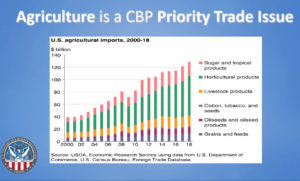
Bigelow: Thanks to the NOSB and the NOP for all of their work.
While CBP, like the NOP and NOSB, is committed to transparency regarding standards, some of their work must remain protected regarding law enforcement. This may affect what can be shared with the NOSB today and in the future.
CBP is working on seven priority trade issues, including agriculture. Organic is the fastest growing sector in agriculture, accounting for 5% of US agriculture.
2020 has been productive for CBP’s partnership with NOP. The Automated Certificate for Trade was implemented, the interagency flow of information has improved, and is preparing to implement the SOE in a phased plan. CBP’s platforms have increased the flow of information to increase compliance.
CBP and AMS will work on training this year to improve Congressional and agency understanding of the regulations and enforcement.
CBP’s operational ecosystem includes physical inspection personnel, with over 1,700 personnel operating internationally. Over 2,500 personnel operate at over 250 US ports.
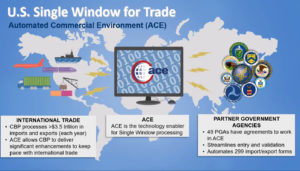
The other front line for trade in imports is the Automated Commercial Environment (ACE) (see slide). Boots on the ground and at ports cannot stop fraud alone. ACE is the processor for all imports and exports of the US. Each day in 2019, CBP processed 78,000 truck, rail, and sea containers.
ACE also enables import data analysis over time. ACE provides the raw data translated into the formal US trade statistics. The transition to ACE was enabled by Executive Order in 2014.
Bigelow is seeking help from the NOSB to join CBP in educating organic stakeholders, including the development of a fact sheet for the trade community.
Questions from the NOSB:
Mortensen: In late 2016 and 2017, the NOSB heard that the USA is badly understaffed in APHIS [and unable] to increase the inspections needed. Are the 2,500 CBP personnel part of APHIS?
Bigelow: No. We are never near the number of staff we need, particularly because of mail. [Many organic products arrive in the US through the mail system.]
Mortensen: My sense was APHIS was seriously understaffed. Has the ACE system helped take the pressure off boots on the ground?
Bigelow: We have to rely on ACE. It is a system that includes a legion of risk assessing analysts watching the data. Physical inspection is only part of the process. We are trying to catch fraud before it arrives at port. Bills of lading can help analysts, for instance.
Greenwood: How do you parse out the work? I did not hear you reference the U.S. Food and Drug Administration (FDA).
Bigelow: We now have improved coordination with agencies including the FDA and National Oceanic and Atmospheric Administration (NOAA). ACE has made trade and enforcement easier. The scientific analysis is shared as well.
Powell-Palm: For different products, AMS set up a different message set. How can we get to that point in imported organic products, such as testing for GMOs for countries of concern?
Bigelow: We’d have to do some upfront analysis, but this is possible under the current system.
Tucker: As the data flows in (ACE has barely begun to be used), the NOP will be able to determine where this type of analysis is best done.
Ela: How many staff at NOP are working on enforcement?
Tucker: Rakola’s staff is about 50 people, with 5 more staff members working on trade, as well as contract support.
Bigelow: Across the US government, use of data science and investments in the talent to do analysis and systems has grown.
Ela: Hopes that once we return to in-person meetings, we can still benefit from technological advances so that experts like Bigelow can attend.
1:50 PM ET: Break for Lunch
3:00 PM ET: Livestock Subcommittee (LS)
Sue Baird, Chairperson of the LS, reported that they had 8 livestock substance sunset reviews and a petition for fenbendazole up for discussion. Third time to consider fenbendazole under organics.
The 2019 petition for annotation change:
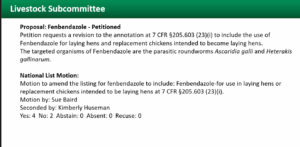
Received a lot of comments, many seeking a limited Technical Review (TR) for use on poultry. Bringing the results of that TR into the discussion today. Major concern is that there can be residue in eggs for up to 8 days after administration.
Powell-Palm: Is also an organic inspector who visits many organic farms. He does a lot of organic poultry layer operation inspections. Took the question of parasite levels to his inspections, including how it is affecting them economically. Inspected over 2 million birds this year. Organic layers are going well. There is a robust production system in place. Called some large egg processors who indicated no consumer complaints of worms in eggs. He believes it is a poor precedent to add a material that has not been widely called for by organic poultry farmers.
Rice: Echoed Nate’s comments on need. There is no evidence of worms in eggs; prefers to have small number of eggs with worms over explaining to stakeholders why there is fenbendazole residue in eggs.
Seitz: Echoes concerns about chemical residue in eggs. He does eat raw eggs in mayonnaise and egg nog. Infestations can be addressed through cultural methods and emergency use is not well-defined. Problematic that entire flocks would be dosed, rather than single animals. Cautions against adding to National List at this time.
Buie: Torn on this issue. As a farmer, tools are helpful for specific circumstances. In some cases, cultural processes do not work. Favors the addition of fenbendazole but is troubled by the residue issue.
Baird: PCO claimed their laying operations were asking for it. In Missouri, producers are seeing worms in eggs. Wonders if this issue of worms is climate-driven. Cool, wet springs seem to drive worm populations up. Pathologists claim an increase in worms of 900%, but this may be in all production, not just organic.
Greenwood: Concerned about the emergency use definition. Terramycin was used in foul brood for bees several years ago, but it was overused and became a prophylactic use. Is concerned about this possibility of fenbendazole.
Mortensen: Particularly concerned about the mode of action in the compound, cell division inhibitor. Concern for pregnant women and unborn children specifically. We need to improve foundational practices to prevent this problem in flocks instead.
Bradman: Unlabeled residue in eggs is concerning. There is information on retention in terms of biological half-life. Would prefer a withdrawal period to protect vulnerable populations, such as children.
Turner: Agrees with many of these comments: residue, management. Concerned about animal welfare issues in not using fenbendazole, but thinks the other issues trump that.
D’Amore: Feels uncomfortable with this petition. Cooking does not remove the residues. Rewards to not balance with the pluses on this one.
The NOSB moves to vote on this issue. Motion to amend the listing for fenbendazole to include the use for laying hens.
- Motion fails, 1 yes and 14 no, 0 abstentions.
Cornucopia’s take: fenbendazole is a powerful synthetic parasiticide (meaning it works to control internal parasites) which needs approval before being used in organic production. Cornucopia’s review of this material shows that cultural management and other production methods are the best way to control parasites, and that factory-organic poultry producers are most at risk for severe parasite issues. This synthetic is not compatible with organic production and is of high risk for abuse.
3:25 PM ET: Livestock Subcommittee (LS), Sunset Review
Butorphanol
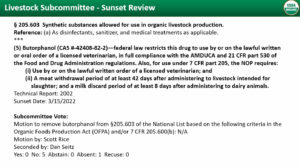
Discussion on removal of butorphanol from the National List:
Rice: Comments claim infrequent use but also necessity for production.
Bradman: In contrast to the last material, this does have a withdrawal period. Understands this is not used herd-wide and does have considerations for withdrawal and that favors it.
The NOSB moves to a vote on whether to remove this substance from the National List.
- Vote: 0 yes; 15 no. Butorphanol remains on the National List .
Flunixin
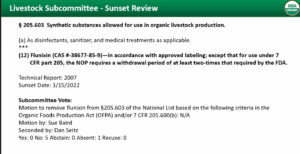
Baird: Producers say it is imperative.
The NOSB moves to a vote on whether to remove this substance from the National List.
- Vote: 0 yes; 15 no. Flunixin remains on the National List.
Magnesium hydroxide
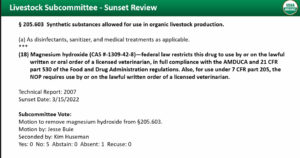
Buie: Used as antacid. Found to be compliant with OFPA and committee does not recommend its removal from the NL.
Ela: The NOSB members did not recuse themselves from any of the material review votes; wanted to add this note to the public record.
The NOSB moves to a vote on whether to remove this substance from the National List.
- Vote: 0 yes; 15 no. Magnesium hydroxide remains on the National List.
Poloxalene
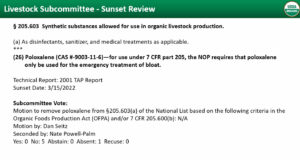
Seitz: Used for emergency treatment of bloat, fairly infrequently. Considered essential.
Bradman: Has read many of the comments and understands the support for it. It is a synthetic and is chemically close to many of the plastics under discussion. Described as copolymer of polypropylene. Last TR was in 2001. May be time for a TR update. Concerned about lack of update…
Seitz: Excellent observation, but it is now up for a vote.
Huseman: Understands there are no alternatives provided for this material. Leans toward relisting until there is further information.
Seitz: This appears to be a unique substance with no alternatives noted.
The NOSB moves to a vote on whether to remove this substance from the National List.
- Vote: 0 yes; 15 no. Poloxalene remains on the National List.
Formic acid
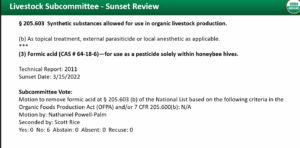
Powell-Palm: Pesticide for honeybee hives. Subcommittee does not recommend removal. Uncommonly used but critical material without adequate substitute.
The NOSB moves to a vote on whether to remove this substance from the National List.
- Vote: 0 yes; 15 no. Formic acid remains on the National List.
EPA List 4 – Inerts of Minimal Concern
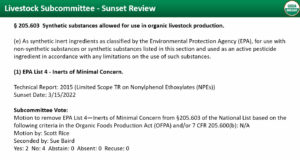
Rice: Public and written comments addressed this thoroughly. The NOSB is looking for motion from this outdated, unsupported (by EPA) listing. Notes the Safer Choice is not a practical alternative to EPA List 4. Not looking at Safer Choice as a replacement, but rather for a model. United in agreement that Board would like to move beyond this, and the vote comes down to how to communicate the NOSB’s desire for motion on this issue. Does not think it’s a good practice for the board to move things forward without good faith that it will truly move forward. Prefers a recommendation to relist and send a strong message to NOP to move it forward.
Tucker: An inherent tension here is that nothing inspires like a deadline and nothing is as scary as a deadline. This is a complex problem. We did not move ahead with this in 2015; I was clear that there were other priorities at that time. It is now time to deal with this. Safer Choice offers architecture for the path forward. Safer Choice is not codified in the regulations, where EPA List 4 was. It is not under the same administrative procedures act, making this more complex. NOSB is considering what to do with this listing. If you vote to remove, it would be referred to the program and they would engage in a rule making procedure. The NOP must consider economic impact. There has to be a replacement in order to remove this listing. We do need an NOSB recommendation to add a synthetic. The NOP could employ an Advanced Notice of Proposed Rulemaking to go through a public comment process and gather more information. Referencing a non-codified list can be problematic. OFPA was written with List 3 and 4 in mind. Without these lists, OFPA can be read in a different way. Rulemaking must be legally linked to the statute.
Ela: If the board voted to de-list, with the sunset in two years, if no other rulemaking occurs, what happens?
Tucker: It would remain on the National List to maintain the listing for market certainty.
Ela: Every board member will need to vote on faith and trust either way. Rice and I agree in principle, perhaps not on the method. Notes that Harold Austin’s comments that 60% of Washington tree fruits would disappear seems low; more like 90%. Does not favor these materials being removed, but he does believe de-listing is an appropriate path. This listing is uniquely complex, making viable alternatives difficult to identify. There were no comments that offered a clear path forward. Does not believe this will disappear from List. Believes a vote to de-list would put this in Jenny’s court and encourage higher-ups to engage with this. NOP’s paid staff can engage with the EPA, but NOSB is volunteer group likely to be overwhelmed by the over 200 materials in EPA List 4. Worried that relisting will put the NOSB in this same spot in five years.
Oakley: Complicated situation. Public comments showed concern for optics of delisting but believes there are negative optics to relisting as well.
Bradman: Followed this field carefully and sees a lot of merit in the development of less toxic materials in agriculture. The defunct EPA List 4 prevents innovation and there needs to be input regarding what goes on the National List. In principle, I don’t think there should be unlabeled inerts in any pesticide formulation, but especially in organic.
Mortensen: The point for me is Ela’s last point about whether this is an appropriate task for the NOSB. Or should it be done by the NOP with input from the NOSB? Unwise for NOSB to imagine it can do this well on their own.
Greenwood: Hopes we can get away from the term “inert.” We know that a number of the items in the 200 materials would not be allowed. For de-listing. Makes more sense to move it to the NOP.
Baird: Appreciates the complexity of this issue. Initially worried about potential problems for producers, but now feels assured that there will be needed review.
Seitz: Any substance that comes before the board in the future should list every ingredient. There shouldn’t be trade secrets in this area. If the material is appropriate for organic use, the board should know what is in it.
Powell-Palm: Believes the 2015 recommendation was clear and wished it could have been implemented. Feels sick to not offer an alternative.
Bradman: We do have the 2015 recommendations to provide a road map. We need to open a process.
Rice: Is there anything that would prevent the program from opening Advanced Notice of Proposed Rulemaking is the board votes to relist?
Tucker: Program does support an Advanced Notice of Proposed Rulemaking based on public comments. Even if you relist it, there is desire to move forward; at the same time, nothing inspires like a deadline.
Turner[?]: We have to move forward. Everything we do is complicated and taxes the brain. Can you, Jenny, give a sense of how quickly that notice would occur if we voted to de-list? Months? Any sense of this?
Tucker: It is something that goes through the standard clearance process: office of general counsel, admin, perhaps OMB as well (other staff think no need for OMB to be involved). NOP staff has begun putting together the Advanced Notice of Proposed Rule making. No economic analysis is needed because we are not proposing anything here. Spring-ish? But does not stand by this timeline [because of unpredictability of regulatory process].
Ela: Wants the NOP to work on this. Will vote to de-list. It will not go through rulemaking due to high economic cost. De-listing would make it likely we return in five years with a viable alternative ready.
Baird: [Wants to clarify to listeners] even if we vote to de-list, the NOP does not have to remove it as shown in other instances. Producers can breathe easy.
Jeffery: Cognizant of tension. Reminds board consumers choose organic because of concerns about pesticides overwhelmingly. We can trust our partnerships between the board, the program, and consumers.
Ela: Prefers to defer this vote until Friday so the discussion can continue in Crops Subcommittee.
Board agrees to defer the vote on List 4 Inerts until a later time, when more discussion can take place.
Excipients
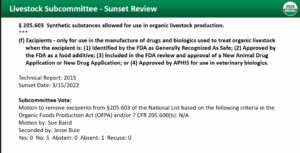
Baird: There are 8,000 excipients available. Comments correlate this issue to the issue with inerts. There is confusion among certifiers about which excipients are allowed. Some commenters stated that removing excipients would impact food safety via sanitation products.
Bradman: Some of the comments suggest there’s a role for certifiers to review materials, potential for discrepancies about how excipients are viewed.
Baird: There is likely inconsistency among certifiers.
Ela: Recognizes this is similar to List 4, and some may say the board is being inconsistent. There are strict rules on the use of these drugs and do have withdrawal dates. Not quite the same as List 4 in that way.
The NOSB moves to a vote on whether to remove this substance from the National List.
- Vote: 0 yes; 15 no. Excipients remain on the National List.
Strychnine
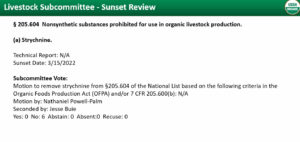
Powell-Palm: Toxic alkaloid commonly used to control rodents, leading to violent death. 30 commenters supported the relisting.
The NOSB moves to a vote on whether to remove this substance from the National List.
- Vote: 0 yes; 15 no. Strychnine remains on the National List as a substance prohibited in organic production.
4:35 PM ET: Policy Development Subcommittee (PDS)
Consent Calender Voting Discussion Document
Rick Greenwood, Chairperson of the PDS: Committee prepared discussion document regarding the use of consent calendar voting. This could streamline some of the meeting agenda when we have examples of non-controversial items like ammonium carbonate and ammonium bicarbonate. Under this practice, any controversial materials could be pulled from the slate by any Board member, and then the remaining materials could be voted on at one time. Opens up the consent calendar voting discussion document for discussion.

Bradman: Interesting idea. Concerned that inefficiencies exist in having duplicative discussion in spring and fall regarding sunset materials. Suggests increases in efficiency in the future.
Greenwood: We spent 15 minutes reading through the sunsets at both meetings. How we improve efficiency is another issue.
Mortensen: Anything we can do to provide more time for substantive discussion. Wonders what the process is by which grouping occurs. Underscores the importance of that process for grouping.
Greenwood: One thing to consider this; another to operationalize it. It is complicated.
Oakley: Surprised by the lack of more public comment on this. Will PDS consider reissuing this or put forth questions for the spring?
Greenwood: Expected more comments. It could appear like a way to limit discussion and push items through. It is not that. Good idea to reissue.
Turner: Loves this idea. Must ensure there is open discussion and that individual board voices are heard.
Greenwood: Spend a lot of time taking votes on sunset items; example of strychnine.
Baird: First five–year sunset review used some version of this because the list was too long to consider individually. We do need more time for discussion.
Ela: Only worry is we need to present each sunset material’s pros and cons to recognize the public comments. It makes my head spin to think about how to group materials. There needs to be high transparency.
4:50 PM ET: Compliance, Accreditation, & Certification Subcommittee (CACS)
Human Capitol Strategy for Organic Inspectors and Reviewers, discussion document
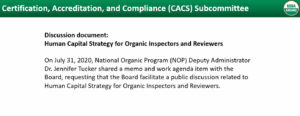
Scott Rice, Chairperson of CACS: Received a lot of great comments on human capital management. Need is made clearer during pandemic. IOIA reported an impending crisis in lack of inspectors and reviewers. Some commenters objected to the turn of phrase, “human capital.” There is a need for funding to move this forward. All suggested are costly. Some commenters noted there is not enough data to determine how many inspectors there are, where they are located, etc.
More inspectors are needed as the organic industry grows. Many ideas were offered in public comments. Recruitment, education, and fair pay are needed. Under-served populations must be considered.
Mortensen: Appreciated the creativity and thoughtfulness of written and public comments.
Powell-Palm: An inspector since 2012 and a teacher of organic inspectors since 2017. We have not discussed that being an inspector is an incredible job, and I don’t think we do a good job of selling that. The reporting work of the organic inspector keeps us all going—it is not drudgery; it is an incredible privilege.
Rice: Jenny’s intent was to kick off this discussion, and it will continue.
NOSB goes into recess until Noon ET, October 29, 2020.
Tuesday, October 20, 2020: Public Comments
[Public comments were exclusively via webinar this year due to response to the COVID-19 pandemic.]
Michelle Arsenault, NOSB Advisory Board Specialist, gave introductions and instructions for the public comments to come. Dr. Jennifer Tucker, NOP Deputy Administrator, then welcomed the NOSB and thanks commenters and audience. Special acknowledgement and thanks were given to the five NOSB members who were about to begin their last NOSB meeting.
NOSB members in attendance (all NOSB members we present at the beginning of the call):
Organic Producers
Jesse Buie (January 2016 – January 2021)
Emily Oakley (January 2016 – January 2021)
Steve Ela (January 2017 – January 2022)
Nathan Powell-Palm (January 2020 – January 2025) – new member
Environmentalists / Resource Conservationists
Asa Bradman (January 2017 – January 2022)
James R. “Rick” Greenwood (May 2018 – January 2023)
Wood Turner (January 2020 – January 2025)
Consumer / Public Interest Advocates
Dan Seitz (January 2016 – January 2021)
A-dae Romero-Briones (January 2016 – January 2021)
Sue Baird (January 2017 – January 2022)
Handlers / Processors
Kimberly Huseman (January 2020 – January 2025)
Gerard D’Amore (January 2020 – January 2025)
Retailer
Mindee Jeffery (January 2020 – January 2025)
Scientist (Toxicology, Ecology, or Biochemistry)
Dave Mortensen (January 2017 – January 2022)
USDA Accredited Certifying Agent
Scott Rice (January 2016 – January 2021)
Public comments on 10/20/2020:
Keith Jones—Exec. Dir. Biological Products Industry Alliance (CS, LS: Inerts)
From a nonprofit organization advancing sustainability through biological solutions. Many member companies develop chemical solutions; many just for organic market. EPA list 4 Inerts: asks that the NOSB should recommend continued listing as it currently stands. A comprehensive list of approved list of chemicals allowed is needed to prevent industry harm. Removal of this listing would lead to sudden loss of organic production tools and would cause significant harm to organic growers.
Ela: Because List 4 has not been updated in many years, how do we propose we move forward? Just because we vote to de-list something does not mean it’s automatically de-listed. If we re-list there is no incentive to move forward; difficult if not impossible to improve on the problematic listing.
Jones: Work with EPA to update list. You can’t just shut down list without a clear path.
Bradman: Several stakeholders in community have laid out good road map on how to resolve some of these issues. You say you don’t see a way forward: what do you think of other proposals out there? Why don’t you see a clear path going forward?
Jones: Refer NOSB to written comments. Many of our members produce products for organic growers. Presently we don’t see a clear path going forward, specifically we need a longer timeline to develop new products.
Bradman: A lot of the substances would probably carry forward onto a new list.
Jones: Concern from our members that important ingredients would not carry over; fears of uncertainty.
Tucker: What the “safer choice” list is and is not at this time we need to look at; it’s not codified in regulations. How do we refer to a list that does not have the same public comment questions? Lots of legal questions to be considered. The NOSB’s job is to evaluate these materials and make a recommendation to the Program. In this case, because of the complexity, a good initial step is an advanced notice of proposed rulemaking where we would lay out challenges and legal questions and what are some options, then we would get feedback during that formal procedure. Any action to remove something from National List in this case would need to be accompanied by a replacement strategy. Added complexity here is that the NOP cannot add something to the National List without the NOSB’s recommendation. We cannot remove something off the list without doing rule-making.
Dee Browder—State of NC (PDS)
Skipped.
Mark Kastel—Dir. of OrganicEye, the investigative arm of Beyond Pesticides (General)
Speaking to the pending rule-making on organic enforcement (SOE): encourages other organizations to open up the organic community and along with the NOSB debate on the SOE rule. The intent of Congress was to form an independent stakeholder panel in the NOSB to act as a buffer and protector for the marketplace. The Secretary is required to consult with NOSB in the implementation of OFPA itself. The NOP has not consulted with the NOSB on all parts of the [SOE rule]. Under the existing rules the USDA orchestrates the revocation of certificates of Black Sea Region. Large corporate agribusinesses and certifiers love regulations because they often squeeze out smaller competitors. This could possibly be a very damaging rule for many.
Before the power was taken away from the NOSB to set their own agenda; suggests the NOSB convene discussions of the community on [the SOE].
Doug Currier—The Organic Materials Review Institute (OMRI) (CS; HS; LS; MS)
Comments on proposals for wild-native fish and marine macroalgae. OMRI supports interest shown by NOSB in accessing negative environmental impacts of proposed inputs. OMRI supports the use of NOP guidance documents in development of best practices for marine materials. Comment references OMRI written comments, where they suggested language for the rule.
Estimated impacts of approval on the liquid fish products: only a handful of products are created from fish waste/bycatch, so we recommend a phase-out period. OMRI requests that the material subcommittee outline a road map on how to access environmental impact of other non-synthetic materials (ex: guano, mined materials, etc.).
Oakley: We received a few comments from folks on liquid fish concerning pet food—some folks wanted waste derived from pet food creation as allowed in organic. Do you think this would be okay?
Currier: Tricky because we don’t often get details on sources of the fish. “Fish waste” should be defined; also tricky because we don’t normally get into amount of detail when it comes to sourcing of fish.
Mortensen: What do you have in mind regarding a road map?
Currier: There are other non-synthetic allowed materials that would not need to petition, and these materials may warrant an evaluation of environmental impact. The thought would be that the NOSB is working on addressing the environmental impact of fish and macroalgae, and gathering that experience and putting it into a document to help with future evaluations would be valuable.
Jay Feldman—Exec. Dir. Beyond Pesticides (General)
Biodegradable mulch: a change in annotation is being considered but belies important considerations. Organic can help mitigate threats of biodiversity decline and climate. Is the role of organic the role to take these challenges on or is it just a niche market? Those that point to the market as a cure must be able to point to support for that in the law. Organic creates a systems approach; does not ask to determine relative risk. It does not disincentivize the use of natural substances. Organic law identified soil as the foundation; the law does not assume the use of synthetic inputs.
Please do NOT consider biodegradable mulch technology until it meets the standards required under the law. Not just by playing with relative risk, which does not lead to solutions. Protect the NOSB’s authority.
Bradman: On your comment on relative risk. Plastics are currently being permitted in organic—for example with strawberries, it looks like they have created containers in the field. The volume of plastic waste is unbelievable, and organic sector is a big contributor to it. The biodegradable mulch is problematic because it’s petroleum derived. We do have to think about relative risk.
Feldman: Using relative risk calculations is problematic, look at how pesticide use has evolved—from the pan into the fire. We are assuming plastic is the only solution, when it has really significant environmental impacts. We need to incentivize research into solutions, NOT relative risk calculations.
Terry Shistar—BOD of Beyond Pesticides (Misc.)
We see signs of ecological collapse everywhere. As BP focuses on the dispersal of toxic chemicals, organic can be a part of the solution. Organic is part of the conviction that food production can work with nature; not just an alternative for people seeking better food. It’s part of preventing ecological disaster. According to regulations organic responds to site-specific conditions, that foster cycling of resources, etc. Meeting these goals is essential to a sustainable future.
Do not allow virgin paper in organic. Virgin paper from wood pulp results form much greater environmental impacts than recycled. Get plastic out of organic. Micro-plastics cause harmful effects through physical effects and carrying toxic chemicals. Protect marine life. We are concerned about over harvesting of marine materials. The requirements of the subcommittee on fish products is too weak. Only post-consumer waste should be allowed.
Oakley: Did you have thoughts on Doug’s comments from OMRI about developing a road map to access non-synthetic substances road map.
Shistar: It’s a good suggestion. Reminds me of another topic that has fallen to the wayside: contaminated inputs.
Aimee Simpson—PCC Community Markets (General)
Dir. Of advocacy and product sustainability.
We must keep pressing forward addressing climate change. Organic is uniquely positioned to address this issue. The NOP and NOSB must advocate for organic to have a place at the table. NOSB should make recommendation to strengthen requirements for climate friendly practices. Cuts to cost-share are concerning; find a solution to the gap. Also find other ways for financial support organic farmers.
Continue to encourage NOP and NOSB to develop standard on how to address issues of environmental impact (seaweed, fish, etc.). For Fenbendazole, our farms have not needed this synthetic; exception for emergency needs to be strictly defined. New synthetics [like Fenbendazole] should not be added without need.
Oakley: We plan to continue to work on fish and seaweed issues. It is very difficult because it’s very case-by-case. We share these concerns that you and others have brought up.
Wood: It’s a huge amount of work to go through environmental impacts.
Simpson: The macroalgae annotation is good as an interim, but there are complexities that call for more details on specific harvest methods. You have to go down to each level and tie them together. [For example] the fish oil annotation—concerned about bycatch inclusion, because depending on fisheries, some are well-monitors and some are not. You could potentially incentivize bycatch depending on that annotation. Having a comprehensive organic aquatic standard is needed; these annotations are just a start.
Ela: In terms of addressing climate change, how would you purpose we start to tackle that?
Simpson: Best place to start is what organic has in its standards already; organic already has what other state and federal programs are trying to implement. We need to dig into these standards and identify them, showing how organic can meet these elements and already in the existing standards. Having a road map laid out by NOSB and NOP and look at what we have existing through new lenses being applied to standards to see how it can work with carbon markets and carbon sequestration? How can we set organic up to feed into that and not re-invent the wheel.
Amalie Lipstreu—Ohio Ecological Food and Farm Association (General)
Accessibility topic: can you adjust upcoming meeting dates by a couple weeks each year to ensure farmers can participate?
The NOSB work agenda and the role of organic agriculture in climate change. Its important for organic stakeholders to understand why items that have overwhelming support are not being acted upon. In research priority recommend advance research into the role of organic agriculture into climate change. We know organic requires practices that foster soil health; the adoption of these practices by conventional farmers is celebrated. When climate change is discussed, organic is rarely mentioned, even though we know these practices are important in mitigation. Emphasizing this is a way forward in dealing with this crisis.
Harold Austin—Former NOSB member and current Chair of the NHC Organic subcommittee (CS; HS; General)
Comment for the crops subcommittee regarding list 4 inerts: its important you do not de-list; there is proper procedure that needs to be followed. You should have moved forward with separate proposal before moving to de-list. If the list 4 inerts are de-listed almost all pheromone dispensers would be de-listed. We would lose significant portion of organic tree fruit. Supports the adoption of 2015 NOSB recommendation [for this listing].
For the materials subcommittee: the proposal on marine macroalgae; cannot support as written. It would create chaos that is not necessary. It needs to move forward. Additional listing under 602 is not necessary and sets a dangerous precedent.
Robert Casper—Buyer, Consumer, PCP(HS; LS)
Skipped.
Kiki Hubbard—Organic Seed Alliance (CS; MS)
Director of advocacy and communications. Mission drive to make sure organic farmers have the seed they need to be successful. Keeping seed and plant breeding issues should be at forefront of NOSB work plan and NOP’s plans for implementation. Hope to see topic of excluded methods back on work plan for next meeting. Understanding and addressing new breeding techniques is important; also would provide clarity to a number of organic stakeholders who deal with seeds and crops. The development of biotech has outpaced the policy. There is a need to make decisions on methods that are still considered “to be determined”.
The organic seed requirements should be strengthened; previous NOSB recommendations for rule-making and guidance should be passed.
Douglas Deveaux—COOP Board member, farmer (angus and hemp) (CACS; LS; PDS)
Skipped.
John Martin—BioStar Organics, LLC (CS: Ammonia Extract)
Producer of two of the products of ammonia liquid fertilizer, petitioner. Methane (which is harmful) and nitrogen and ammonia is produced as a natural process of breakdown of organic waste. Company collects organic waste and processes it in digesters, collecting the methane gas. This technology removes all suspended solids for composting. Remaining liquid is concentrated. There is no extraction of nitrogen and ammonia, only water is extracted. The development of this fertilizer goes back a decade. Our manufacturing process has been inspected, including my OMRI. Cannot be considered synthetic.
Buie: Stakeholders mentioned potential for fraud in this production process.
Martin: In investigation by OMRI, there was fraudulent use of synthetic nitrogen in some fertilizers. It’s a simple test to perform that you can differentiate between synthetic and non-synthetic nitrogen.
Ela: Can you speak more to what goes into digester?
Martin: In our process its all organic material; manure or food waste that is pre-consumer (nothing that is taken from garbage bag). Tested before digested to determine if something harmful to bacteria or something considered non-organic.
Allen Philo—VP of Business development for BioStar Organics (CS)
Has worked with organic farmers to help their fertility for many years. Our product complies with organic program. Our products are easy to distinguish because they are a concentrate and are not an extraction. When applying manure or compost to field: does separating manure or compost from solid or liquid violate NOP guidelines? What about removing water? The answer is no. That is our process, and our final product is gentle in the environment and can increase biological diversity and activity in the soil. Fraud is of small concern with our products.
Daniel Hazen—Perfect Blend Organics (manufacturer) (CS)
Addressing ammonia petition. Largest manufacture of fertilizer in WA state. Petition follows organic standards on non-synthetic side. This product was developed with BioStar. We feel this product is a solution to the huge manure issues at large. In NOP 5012 governed liquid fertilizer. We get inspections regularly. Tests can easily identify products as organic; fraud is not a huge concern. Isotope analysis can be done in-field as well; it’s the same as monitoring any other liquid product on the market already. The petition is a disingenuous attempt to push market competition. Please reject the petition.
Question: Are the bacteria naturally occurring?
Hazen: In our process there are no bacteria interjected in the process at all. It’s all naturally occurring. Our process is slightly different than BioStar; ours is always manure-based.
Jeffery: Thank you for all the information. We want to hear all sides.
Oakley: How do you see this as a solution to manure issues across the industry?
Hazen: This product basically has no phosphates which helps to clean up our environment. There is a phosphate overload. This is a carbon-based product compared to products with no carbon at all.
Mortensen: One of the considerations the subcommittee was looking at was other sources of nitrogen as well. Carbon and nitrogen ratios for cover crops for example are very different than ammonia extracts. From the point-of-view of soil health and recycling and capturing nitrogen through systems plan; your product is still highly concentrated.
Hazen: Organic growers should get more credit; some folks take this product and blend it with an amino acid for example. This product is just one more tool in growers toolbox to help them grow to crop’s genetic potential.
Greenwood: You add fresh water to your system; what happens to the liquid leftover? How do you handle wastewater?
Hazen: There is no wastewater. The machine removes particulate; and then it goes through evaporator and condensate is fresh water that then goes back into the process. It’s a full system. When you look at hog lagoons or other manure digestors they remove all the phosphates and then they return fresh water of drinking quality, that can then be discharged. So this is truly a solution to problems organic dairy industry and others are facing.
Tina Jensen Augustine—OMRI (CS; HS)
Paper planting aids are an important tool and tricky for material reviews. We support annotation but requires clarifications; definition of required 3rd party review. The procedural aspects of this annotation and definition are not clear. The focus should be on 80% bio-based content. OMRI supports requiring testing to define bio-based, and not requiring 3rd party review. The other ingredients besides the cellulose is a concern for some stakeholders, 80% cellulose helps limit these concerns. Limiting non-bio-based additives to strengtheners, binders, etc. only, would help limit concerns.
Combining planting aids with pesticides or nutrient review makes this material review more unclear.
Jeffery: In the sense of supporting paper planting aids but having questions with definitions, should we go back to subcommittee and work on definition more or move proposal forward?
Jensen: I’d like to see proposal move forward but with some of the changes we’ve outlined [see written comments].
Ela: Adding the 20% limit to binders, strengthening… what would be concerning that could be added?
Jensen: Plastic coatings, colorants… it’s hard to predict what else could be put in there. But limiting what types of products could be put in there to what has already been identified (to hold the pots together) will help the pots match what organic intends.
Jennifer Taylor—IFOAM international
Our work builds capacity for organic farmers worldwide; advocates for agro-ecological farming practices and sustainable development. NOSB members have opportunity to be good stewards of organic agriculture. Reflect on bigger organic picture: the IFOAM principles of organic agriculture. Health, fairness, etc. The standards should be established not just for economic benefits, but also to support well-being and health of our environments: healthy soil, plants, and animals, and consumers. Access to healthy foods and the benefits of organic farming systems are for everyone. Inclusion and social justice are essential to organic capacity building. As important as standards are, organic needs targeted participatory training for black, indigenous, and disadvantaged farmers. Small-scale organic farmers are vital. NOSB should recommend and promote participatory capacity building and well-being strategies, hands-on assistance model for organic.
Oakley: No question, but thank you for your comments and I hope they will be taken into consideration for future Board appointments.
Mortensen: Thank you for reminding us of that structure and emphasis.
Ela: How do you think the NOSB can increase diversity and address issues you talked about?
Taylor: Purposefully target black indigenous and underprivileged communities—provides outreach to even more communities spreading benefits of organic movement.
Dave Carter—Representing Merck Health (LS)
Principle of Crystal Springs Consulting. Supports listing of fenbendazole for emergency treatments in poultry. It does not harm beneficial insects. Poultry producers also struggle with internal parasites, especially as they spend more time on the soil. Two square feet per bird recommendation is not helpful for parasites; it’s more for animal welfare. Chickens get their beaks down into the dirt while foraging; very different than managing ruminants.
Baird: It said in your comments that you assisted in the petition for organic dairy cattle. Have you seen what the gut of birds looks like when they have worm infestations? Do conventional poultry operations use fenbendazole? The TR showed that there could be damage to dung beetles and others.
Carter: Blayne Mozisek will present shortly. The suffering is serious when they have an infestation. Yes conventional agriculture does use this, with a withdrawal time. The damage to dung beetles and others is less severe than other parasiticides.
Bradman: My concern is that you would dose the entire flock prophylactically if there is an infestation. This is different than ruminants because you can dose an individual. Can you address the difference in prophylactically applying this to whole flocks. Many producers never have a need for this and have stated that this hasn’t been a problem and all and are concerned about it’s use.
Carter: Existence of parasites varies by season and region. In terms of flocks versus individual animals; if an outbreak occurs in a flock it sweeps through the flock. An emergency would not constitute just a few birds; emergency occurs when it’s the full flock.
Bradman: What would the withdrawal period be?
Carter: Use the same withdrawal as you do in organic dairy.
Jaydee Hanson—Policy Director, Center for Food Safety (HS;LS;MS)
Excluded methods: Center urges NOSB that excluded methods be kept out of organic. Move forward with GE techniques
Marine Macroalgae: Non-Synthetics substances that should be prohibited. Annotation that specify parameters for the harvest of marine algae so that some could be used. Harvest parameters must include attempts to preserve marine ecology. Prohibit harvest methods like bottom trawling. Repeat harvest should be prohibited until biomass and architecture is of undisturbed natural stance. Bycatch must be monitored and prevented or eliminated in the case of status species. For macroalgae: a robust guidance is needed to clarify guidance because most inspectors are not familiar with marine ecosystems. Adding Latin binomials will help clarify, handling subcommittee in 2017. Approval of algae use needs to be site-specific. For example you might need separate listings for CA versus WA.
Fenbendazole—more work needed before listings. We oppose the listing as presently proposed. There will be residues present in eggs; you need a withholding period that will avoid all residues in eggs because consumers expect no residues in organic.
Oakley: Do you have suggestions for how NOSB might continue work on marine macroalgae? How do we engage the industry perspective?
Hanson: As you are regulating things you need to make it clear as to what you are regulating; to do that you need to use Latin names (because there are colloquial names for species). Contact state officials because they have regulations on harvest; they are well-versed in these issues.
Wood: Bycatch comment: do you mean the term is too broad? Should there be a species specific call out?
Hanson: Needs to be species specific. There are species that attach to hold fast on large algae. At the least you need to list what can’t be taken with the harvest of the bycatch, otherwise you contribute to elimination of these species. There are species that are locally or nationally endangered. There needs to be area-specific guidance.
Seitz: Can you talk more about potential consumer trust issues?
Hanson: You don’t want a different organic standard in something that kills worms versus something that kills bacteria. You need withholding period and if the residue isn’t getting removed then you can’t sell those eggs as organic.
Meagan Collins— Accredited Certifiers Association, Inc.
Membership includes 64 accredited certifiers. Comment on human capital management—this issue is central to the organic market. Qualified personal cant be retained due to decreased pay and other issues. Opportunities lie in encouraging future generation; professionalizing inspectors as a career. Collaborating with universities, working with 4H, trade schools, etc. Programs can be coupled with IOIA as an internship. Certifiers need to offer competitive wages, which is difficult. There needs to be additional financial support to certifiers, because otherwise the cost falls on farmers. Reducing the cost-share program in this respect is detrimental.
Blayne Mozisek—Merck Animal Health (LS: Fenbendazole)
Support fenbendazole listing for animal health and welfare [for organic laying hens]. Reviews the scientific literature. Food safety risks are not discussed in cited articles.
Oakley: How often would you say that it’s used as emergency treatment in conventional poultry? What would the level of treatment need to be?
Mozisek: Emergency situations should be based on a threshold of infestation in flocks. Literature cited speaks to months between treatment. It’s very dependent on flock location and specific needs. Monitor worm burden every 8-10 weeks.
Baird: Your written comments were very helpful. You did a survey of organic producers to figure out how often eggs had worms in them? People are concerned about residuals; what if we just allowed them in replacement hens?
Mozisek: [Shows graph of worms in fecal samples.] 45% of samples tested were positive, 10.3% exceeded burden. While helpful for those producing pullets, older hens are still exposed. So that wouldn’t help.
Bradman: Young children are exposed more per unit of body weight, that is certainly true. Also looking at your date, how large is the sample?
Mozisek: The tests were fecal samples, looking for worm eggs in the samples. Growers were asked to submit approximately 4-6 locations within each barn and 4-6 fecal droppings in each location there.
Mortensen: Children being sensitive; microtubule inhibitor chemical, which disrupts mitosis and cell division in growing organisms. One of the concerns we’ve had is that a compound that is active in that way is going to raise a flag that is more so than synthetics in general. Issue of residue is not taken lightly. Folks suspect not to have synthetic compounds used at all, and especially not those that inhibit cell division.
Mozisek: Fenbendazole has been on the market for decades and there have been no big risks shown.
Jeffery: Are you seeing a correlation between worms in samples and flock size?
Mozisek: No, we are not seeing a correlation. For ruminants pasture rotation works well for them because you can better control foliage. It’s a simpler life cycle for the poultry parasites. [Shows slide of GAP 5 chickens in CA; but note there is no vegetation on the ground.]
Greenwood: What temperature does fenbendazole degrade? Is it a human health issue because poultry products are eaten cooked?
Mozisek: Fenbendazole would not be degraded in temperatures we associate with cooking.
Powell-Palm: Did I understand that producers were leaving organic certification due to parasite load?
Mozisek: There was [at least one] grower who transitioned back to conventional due to parasite issues.
Shannon McCormick—Material Review Officer for Oregon Tilth (CS; LS; MS)
In 2015 the NOSB made a recommendation to revise the annotation for list 4 inerts. They recommend 3 replacement EPA lists, including the safer chemical list. Tilth supports the NOSB’s plan. To prevent disruption, Tilth opposes the removal of the EPA list 4 inerts. Instead, recommend moving forward on annotation/language change instead. Removal without a backup would greatly harm the organic marketplace. Recommend a minimum of 1 year implementation period to allow for adjustments.
Ela: If we choose to re-list, there is no incentive for the NOP to act on this. If we act to de-list, the program will have to move to do something about them.
McCormick: Our main concern is that a plan be in place before List 4 inerts are removed from the list. We do support the 2015 recommendation as written except for the safer chemical list (because it does not include pesticides).
Conor Mulroney—Quality Manager at Marroquin Organic International, Inc.; Organic Handler (HS: Ion Exchange)
Provided the industry with high quality ingredients for 30 years. Support handling subcommittee’s decision [on ion exchange]; ion exchange resins are important. It allows for quality and purity and reliability. Ion exchange resins do not have to go through review. Organic ingredients made through ion exchange are important parts of the industry.
Erin Bardagjy—Material Review Officer for Oregon Tilth (HS: Ion exchange)
Tilth supports NOSB’s recommendation with respect to ion exchange, it is in line with previous recommendation. This allows the continued production of things like juice, syrups, and dairy products without disruption.
Chris Schreiner—Executive Director Oregon Tilth (CACS; General)
Human capital strategies: even before the challenges of inspecting during a pandemic this has been a long term concern. Organic success is outpacing a well-trained workplace. Organic inspectors are retiring, and there are limited opportunities for new inspectors. Inspectors are often expected to shoulder health and liability insurance. As more universities develop certificate programs, lets work with them to create pipeline. Create mentorship programs. Tilth just began shifting from using independent contractors to having inspectors as employees. Continued training and professional development. Inspectors are essential workers for the organic marketplace. There is urgency and a need for action now.
Rice: Comments about undervaluing inspectors—issue of keeping it affordable for producers. Tilth is making them employees; how does this help keep those expenses in check versus putting it on the inspector? What’s the breaking point for passing those expenses on?
Schreiner: We don’t know the full impact yet; we are hiring them because we were fighting for supply with other certifiers. There are a variety of diverse rates among inspectors and making them employees we establish a base rate for all inspections. Controls consistency year to year as well.
Erika Rohr Luke—Marrone Bio Innovations (CS)
Marrone develops plant extract products for integrated pest control. Please don’t sunset EPA list 4; instead please engage in List 4 updates. The Safer Choice program is not a good replacement as the program is not equipped to deal with worker needs, farm needs, etc. We ask that the compliant inerts be updated. Five years or more may be needed for products to be re-formulated and trialed. Do not sunset without a replacement in place. NOSB should work with NOP and EPA staff to update the list of EPA list 4 inerts.
Bradman: The NOSB in general feels that current situation is broken, and there are substances on list 4 inerts that would never qualify as an organic pesticide. The goal is not to replace the list 4 inerts; goal based on previous recommendations is to open doorway to a process where this can be updated. We need an organic-specific list of inerts. Right now we don’t have that—we just have a list that is not maintained and not functional.
Rohr Luke: We would like the NOP to work with the EPA to update the current list into something that is NOP compliant and will encourage innovation in this area.
Jessica Shade—Dir. Of Science Programs for The Organic Center (MS)
[Comment was broken up/hard to hear.] Feedback on research priorities. Supportive of priorities for building soil health & sequestering carbon—hoping for adding this category for the list profitability comparison. Happy to see citrus greening in organic groves as a priority as well; we have a survey from organic growers out. It’s helpful that NOSB is highlighting this issue. It helps get large-scale federal funding. We would like to see soil health protection for organic farmers.
Maria Elena Lombardero Ventura— Int’l Foods Control Sa De CV Pravied Company (CACS; CS; HS)
Skipped.
Lynn Coody—Organic Produce Wholesalers Coalition (CACS; CS; HS; MS)
Coalition of seven businesses that distribute fresh produce domestically and internationally. Ammonia petition: this is not compatible with organic production. List 4 inerts: strongly disagree with the de-listing of this item. We urge re-listing. Marine macroalgae: we have multiple concerns; the document for this meeting is the first time everyone sees the full annotations. Grower feedback is limited. We do not support to listing in 602; should be included in section 203. The material subcommittee should work with the other subcommittees to make treatment of algal use more universal.
Mitch Clark—Maple Hill Creamery (HS; LS)
Skipped.
Dr. Allison Flinn—Merck Animal Health (LS: Fenbendazole)
Veterinarian in support of fenbendazole for emergency use in organic laying hens. Advocate for helping birds where emergency treatment is right. Raising hens outdoors has benefits and parasite challenges. Hens that suffer from high parasite burden suffer stress. Lack of clarity in regulations on what an “emergency” is in organics. Quantitative approach recommended; poultry vet experts should be consulted.
Baird: Have you seen increase in worm populations in organic flocks? Other presenters noted that since 2017 worms have increased exponentially.
Flinn: Refer to written comments for technical answers.
Emily Musgrave—Organic program manager at Driscoll’s Inc. (CS; HS)
Biodegradable biobased mulch (BBM): a 4 year research study showed no negative effects from BBM. Urges NOSB to re-write the annotation; this proposal needs further research and work o get right. We do not support proposal for wild and native fish as written; ask for more time for the community to weigh in on a change to the regulation. Supports the re-listing of EPA List 4 Inerts; removal is irresponsible until another solution is in place.
Oakley: Can you give specifics of marine macroalgae, how to get it right?
Musgrave: An industry feedback session on the topic would be helpful. Really specific questions could then be answered.
Bradman: Given involvement in berry industry and use of plastic films in strawberry: is that material recycled and how is it disposed of? Do you have growers who use BBM and how do they handle it (probably conventional growers)?
Musgrave: Disposal of films cannot be recycled because of dirt on them; this is why so many growers want an alternative. We have many organic growers interested in using BBMs and we have some conventional growers using BBMs now. I’d be happy to get back with specifics there.
Adam Warthesen—Dir. Of Govt. and Industry Relations for CROPP Cooperative/Organic Valley (General)
Does work on policy and advocacy as well. Critical to healthy dairy sector is consistent application of standards. The USDA has failed to accomplish this on the topic or origin of livestock. Sets of certifiers with how they are interpreting the regulations. In 2013 we had an OIG report and a proposed rule in 2015. The comments were strong in allowing a one-time event allowing a transition to organic and thereafter dairy animals must be from the last third of gestation. Right now, the USDA is out of since with federal mandate as well, since it was asked to finish this rule-making. Origin of livestock needs to move forward.
Jake Evans—True Organic Products, Inc. (CS: Ammonia Extract)
In the crop input level there has been fraud at all levels at different times. How can you regulate and trace synthetic ammonia mixed with other substances? Ammonia, the most common synthetic fertilizer, is ammonia regardless of how it is made. Do not support this petition for ammonia.
Ela: In terms of other speakers saying it’s easy to distinguish between synthetic and “natural” ammonia, how do you speak to that?
Evans: Blending synthetic into organic ammonia is a big gap that testing will not be able to detect. It’s a big risk for fraud.
Ehsan Toosi—True Organic Products (CACS; CS)
Research into sustainable agriculture and soil carbon cycling. Principle of organic cropping is improving soil fertility by improving biological processes. Directly applying ammonia minimally supplies soil food web, as it jumps over natural biological processes.
Ela: If there is an ammonia extra that has a high carbon-nitrogen ratio, does that get sequestered the same way as a manure or something else applied not broken down?
Toosi: The larger C-to-N ratio there is, the higher the chance of sequestration there is. Lower ratio leads to higher losses of carbon.
Ramy Colfer—True Organic Products (CS: Ammonia Extract)
Works in research and development; worked in farming department at Earthbound Farm previously. Organic farming requires biological and ecological process to successfully produce crops (systems approach). Ammonia extract would deliver a ‘quick fix’, not consistent with organic systems approach. The problems they could create if in common use could be much like what we see in convectional agriculture. We could see excessive vegetative growth, which could lead to increased pests and diseases. Encourage the NOSB to prohibit the use of ammonia products in organic farming.
Michael Menes—True Organic Products (CS: Ammonia Extract)
Ask to continue to expedite the petition to prohibit ammonia extract. The definition proposed in petition is purposefully broad: the focus should be on the finished product. Where does the biology happen? Is it found in nature? There are many alternatives already approved (example: liquid fish).
Ela: You make a number of liquid fertilizers. How do these different liquids not bypass the soil? Can you mix and match fertilizers with liquids and then a solid application, such that we could limit the total amount that could be applied to a crop with ammonia?
Menes: How do you define a liquid fertilizer? Ask where the biology is happening; feeding into the soil web versus directly the plant. There is an option to limit amount applied, but there is still that organic fraud potential of mixing natural and synthetic.
Jessica Knutzon—CP Kelco (HS)
Low Acyl Gellan gum (LAGG) petition: It’s made from the same bacteria that is found in nature (ex. on water lilies). The pasteurized product is precipitated dried and milled. High and low gum have some differences: LAGG has a very dense “cell” network. It has key properties of high gel strength, excellent flavor release, good stability with heat and acid, sparkling clarity, flexibility in melting and setting, etc. Found in many vegan options when you want to replace gelatin, icings and frostings, yogurt (dairy), bread fillings, ready to eat water gels, toothpaste, etc.
Kyle Bailey—CP Kelco (HS)
Support LAGG to the list of non-agricultural ingredients added. Essentiality of LAGG versus other gelling agents: LAGG can form fluid gels at low use levels and obtain long term suspension. It has low impact on mouth feel compared to algal gels. Also it provides heat stable gels for things like bakery fillings, and can be used in different acid levels. LAGG works in a broader working range, allowing streamlining for manufacturers. Allows for gelling and suspending purposes. Ask that LAGG be added to the approved list.
Allison Carrington—CP Kelco (HS: Low Acyl Gellan Gum)
There is a need for organic vegan LAGG. It’s made through natural fermentation. LAGG allows for the development of vegan “claim” hard capsule that allows for timed release technology. LAGG is the optimal choice because xanthan/locust gums has too high viscosity, pectin has low strength, and agar take too long to set. Vegan organic capsules offer more functional benefits, allowing for consumer vegan capsules. This is the only solution that meets consumer needs.
Patty Lovera—Policy Dir. For Organic Farmers Association (CS; LS; General)
Organic certification cost share: OFA members are upset about cutting reimbursement levels. NOP and AMS no longer administer this program, but we encourage that they reach out to see what happened and figure out how to prevent this.
Urge the NOP to work as quickly as possible to address origin of livestock; hope to hear an update on the status of that rulemaking.
Concerns about container and greenhouse transition period after application of prohibited substance; there is inconsistent application of transition period for container systems. The guidance left unanswered questions. A survey was conducted from certifiers for how certifiers interpret transition. 34 certifiers responded with a wide range of interpretations. The ACA working group is working on this issue. Clarity on this question is needed as soon as possible.
The grower group section of the Strengthening Organic Enforcement should be taken out of the rule so it can be discussed in more detail via the NOSB.
Rice: We raised similar concerns regarding the cost share issue. It is on our radar and we’ve brought it up to the NOP.
Oakley: thank you for the work done on survey to certifiers for requirements on 3-year transition issue. The results were varied, especially in some areas. This is a question for the NOP if they’ve seen these survey results and if so, what their thoughts are.
Tucker: Just received that survey this week and we will spend time looking through it; thank you to everybody who participated in that process.
Stephen Walker—MOSA (CACS; General)
Certifies 22,000 organic operations. The human capacity element discussion is important. Improvements are often well targeted, but more requirements make certification more difficult. If burdens are only put on certifiers it makes more difficult to do their job. Inspectors and managers are getting burnt out and farmers are spending more time on paperwork. Risk assessment could possibly lighten some burdens. Risk-based inspection scheduling could work. Also the NOP needs to make timely guidance to any changes in the regulation. The learning center is working well. Our regulatory sector is not funded enough, certifiers cannot handle that burden. Fiscal support should be on-par with conventional agriculture. Organic specifics are teachable but more soft skills are more difficult to find in inspectors.
Michael Crotser—CROPP Cooperative (HS)
Certification manager. Comment of sunset review of whey protein concentrate (WPC). We support removal of this WPC; CROPP is a major supplier of organic WPC. WPC production also yields lactose and is used to add protein to products. Organic whey is now available in form and volume and the supply will grow and provides new markets for organic goods. 60% of our whey is processed into whey powders. Non-organic WPC can only be used in organic with strict limitations. Our WPC supply is greater than market demand.
Alison Watkins—International Food Additives Council (IFAC) (HS)
Strongly support HS recommendation to relist wood rosin. It is an important material for organic food production. We support the relisting of calcium phosphates; they provide important technical assistance in foods and provide important nutrition. 18 colors are essential to organic as well; organic juices are not standardized for shade and are weaker for shade. There are no organic potato or paprika, and limited supply of other colors. We support relisting all of these colors.
IOE is used as a source of dietary fiber, helping consumers fill the fiber gap. We support the HS recommendation to re-list IOE.
Also support re-listing cornstarch. There is not enough organic supply available to meet the need. Native cornstarch is essential for baking, gummies, etc.
We also support listing low Acyl Gellen gum.
Bradman: Which colors are in better shape regarding organic supply?
Watkins: Would need to contact our color suppliers; also see our written comments.
Mortensen: Surprised to hear that 0.3% of harvested corn is organic. What level would we need to be at to increase demand to what is needed?
Watkins: I can reach out to our starch suppliers and ask.
Oakley: You said there is no organic paprika available but I see it on the organic integrity database.
Watkins: Different than the organic color extract form paprika.
John Hendrickson—Small Farm Works LLC (CS)
Sells paper pots; submitted original petition. Supports NOSB proposal to define paper pot/planting materials. These materials are benign and incredibly useful for small farmers. Concerns about language: could be misinterpretation that the aids contain a minimum of 60% natural fibers. There are synthetic cellulose based fibers, like rayon. Written comment has some suggested language. I remain concerned about the testing protocol to determine the bio-based content of planting aids. This test is not viable for testing of products made from wood pulp. In 2021 there would be a new product that replaces synthetic fibers with hemp fibers. I am in favor of the NOSB revisiting this annotation as technology evolves.
Mortensen: Thank you for your patience and providing information when we needed it.
Beth Rota—Quality Certification Services (CACS)
Human capital: effective management is critical. If human capital is not managed it will face huge limits to certification and increased fraud. Our ranks are not growing to keep pace with expanding industry. Certifiers need staff with specialized knowledge, and at the same time our reviewers and inspectors need to work in a very diverse industry. Organic certifiers also compete to a limited pool and cannot meet industry salaries that are competitive. QCS invests in training but we lose our investment when they move onto other certifiers or leave the industry entirely.
Suggest connecting with universities, trade schools, NOP-facilitated internship program, database of experts available for contract by certifiers. A robust cost-share program also is an important piece of this.
Eugenio Giraldo—Chief Technology Officer ‐ NuOrganics LLC (CS)
Ammonia is in manures. The organic production goals speaks to fertility management. Manures are rich in ammonia and phosphorus, which can result in water contamination. Manure ammonia is most in the environment in current manure management practices creating impacts. By collecting manure ammonia organic goals are fulfilled: fosters cycling of resources, reduced leaching ammonia and nitrates, recovers a lost resource, and avoid contamination by pathogens that might be in manure. Ammonia is the preferred nitrogen source for soil microorganisms and the hub of many microbial relations. OFPA provides the regulatory framework to use manure ammonia for environmental protection for soil fertility enhancement.
Ela: When you extract the ammonia from manure you don’t get the micronutrients?
Giraldo: When using this product, you don’t over apply phosphorus, and allows you to apply it only when the plant needs the ammonia. In this ammonia extraction the manure could then still go to be applied to field but without saturating the phosphorus.
Oakley: A a producer could use the ammonia extract and not apply the manure, correct?
Giraldo: Yes, they could, but according to requirements you still need to use manures. This would be a locally sourced nitrogen and a resource recovered.
Greenwood: When I first transitioned, I went to chicken manure and almost killed trees because trying to get enough nitrogen was difficult; see a real advantage of being able to split out nitrogen from the salts.
Alicia Jorgenson—University of California, Santa Cruz 2020 IGEM team (MS; PDS)
Tackles humanitarian issues using synthetic technology. USDA organic regulation requires no GE technology. How something is created has little say on the final product in some cases. The exclusion toward recombinant DNA tech is nonsensical in organic. The USDA stands in the way of a mulch film developed by recombinant kombucha that is biodegradable and not a petroleum product. The final product will contain no DNA. In accordance with EU standard all these bio-based materials are fully field compostable. There is no reason why recombinant DNA tech is incompatible with organic standards. We ask the NOSB to re-evaluate the excluded methods for bio-based films.
Bradman: I appreciate your comments. Not aware of any films that use recombinant DNA tech; are there any films that meet 100% biodegradable requirements but are produced from excluded methods? If there are any that would meet our current annotation except that they are produced by excluded methods I’d want to hear about those products.
Jorgenson: There are some mulches available that are high-biobased, but they are not flexible enough. If you allowed recombinant DNA technology you can add a plasticizer.
Ela: It’s not just the NOSB’s choice to determine the excluded methods. It’s codified in OFPA.
Jeffery: Beauty of the organic system is that the rationale that the community has chosen to excluded these methods is systems-based, not just as the final product. This rationale is part of the federal documents.
Jill Smith—Western Organic Dairy Producers Alliance and Pure Éire Dairy (LS; General)
Represent 285 dairies. We look forward to origin of livestock; consistency is needed across all types and sizes of operations. Producers suffer when they raise their young stock organically. Producers are leaving organic dairy. Holding everyone to the same standards is essential for our livelihoods.
We support the discussion on human capital management.
Whey protein concentrate should be removed from the list and further supports our dairy producers. We largely support the re-listing of livestock substances.
Kirk Sparks—CEO of Pacific Northwest Organics (CS)
Skipped.
Jennifer Berkebile—Pennsylvania Certified Organic (CS; HS; LS; MS)
Materials program manager. Cornstarch: There is a vote to remove cornstarch. However, baking powder often contains some cornstarch, but less than 70%. Without an option to use non-organic baking power it will be exempt for use in organic processing. This is a huge problem, because less than 70% of the product is agriculture it would be exempt from certification. But it cant then be used in a certified organic product, even if it contained organic cornstarch.
Paper as crop production: we support the listing of these planting aids. The product having pesticide ingredients would not be permitted anyway unless separately listed as an allowed pesticide.
Bio-degradable bio-based mulch film (BBM): we do not support current listing with no change. We support either the removal or a change to the listing so that current products or possible products can be used.
List 4 inerts: support the continued listing.
Rice: Couldn’t someone opt to get certified in the case of baking powder?
Berkebile: No, because the bulk of the product is not agricultural.
Tasha Sparks—Controller at Pacific Northwest Organics (CS)
Skipped.
Brian Ward—Clemson University (CACS; CS; MS)
I have some questions. The use of ethylene products on pineapple: why is this not labeled for use as a ripening agent in processing tomatoes? I have a patent on ammonia-based fertilizer that utilizes non-gmo bacteria. Uses soil amendments that are currently OMRI approved. Extracted as a stable product. In California (and other areas), why are there limits on how high the nitrogen content can be?
Alan Lewis—Natural Grocers (General)
Reminder: allowing any biotech that is excluded is a slippery slope. The idea that something can be an organic product even if the DNA of the last organism is removed is ridiculous.
Noah Lakritz—Policy and outreach specialist with CCOF (CS: List 4 Inerts; CACS)
De-listing or annotation changes for widely used ingredients—consider the processes certifiers have to take to respond. Presence of widely used materials in multi-ingredient blends widens reach and makes monitoring compliance more difficult.
CCOF supports re-listing of aquatic plant extracts. We are not aware of any commercially available alternatives. CCOF also supports liquid fish products and thinks the annotation is a problem as it’s hard to verify the purposed use of the fish at the time of harvest. Concerned with proposed de-listing of EPA List 4. Supports discussion of important human capital management discussion document.
Wood: Does CCOF think aquatic plant extract annotation does not need to be edited?
Lakritz: Widely-used materials there has to be extra care with de-listing and annotation changes because we don’t want to upset balance in system.
Sarah Reed—CCOF (General)
Cornstarch: forms of organic cornstarch are available; but cornstarch is not always used as a stand-alone product. If it is removed from listing, handlers might not be able to use baking powder. A possible correction could be adding an annotation taking into account the baking powder issue.
Carnauba wax and/or orange shellac: Often combined with multiple products to create fruit coatings. The same issue arises as it does with baking powder in that products wouldn’t be used in organics by accidental consequence.
Fritz Dramm—Dramm Corporation (CS: Liquid fish products)
Manager of Dramm; they create a fish fertilizer in WI. Explain what fish offal inputs might go into a liquid fish fertilizer: collect it form commercial operations throughout Great Lakes. Get range of racks, whole fish, guts, skins, and some bycatch. The DNR will take female fish that are caught and donate them to food pantries. If you cut a fish you cannot re-sell it, so we often get that fish as well. It’s a mix of things every year. Difficult to identify the balance of the value coming our way year-to-year is very valuable.
Vincent Chebny — Trece (Pheromone Product Supplier) (CS, LS: Inerts lists 3 & 4)
High concern for de-listing of inert ingredients. Produce 23 products with list 3 & 4 Inert ingredients. The consequences would be the loss of monitor products we make, which are used to monitor whether there is a pest problem. So these products help with utilization of control materials. There would also be a loss of making disruption materials if these ingredients are removed. Without this growers are going to have to apply greater amounts of control products and have more insect damage.
Mike Dill—Organically Grown Co. (Inerts)
We cannot support the removal of inerts without having provided stakeholder more information; no timeline, nothing that quantifies impacts, etc. Should consult material manufacturers before making any decisions. Safer choice is not an appropriate solution, and contains ingredients that has no place in pesticides.
Ela: We are faced with quandary. If we re-list we are stuck with an old system and there is no way to encourage program to move forward. A vote to de-list then prods NOP into having to do something. We can’t propose new annotations or materials at sunset.
Dill: Putting pressure on NOP is not the right move, responsibility is on the NOSB to come up with a viable solution. Path forward should be to re-convene the task force.
Bradman: You highlight some of the challenges for the current industry. We are 5 years into this so-called 10-year process. There needs to be a working group on this that is active. There is a misconception that we would be replacing the existing list with Safer Choice, but it’s really just a framework to work with EPA to review inert ingredients.
Thursday, October 22, 2020: Public Comments
Dr. Jennifer Tucker starts the public comment period with opening remarks.
During the roll call, all NOSB members were accounted for.
Steve Ela, chair of the NOSB, directs the public comments. Ela notes and welcomes the five new NOSB members that will officially be starting in January, 2021.
Kaat Bracquiné—Lonza (HS)
Low acyl gellan gum (LAGG) comments from Lonza. Markets segments of dietary supplements. The demand for organic alternatives in supplements has had increased in need and popularity in recent years. The qualification of a gelling agent in a capsule shell ingredient does require careful consideration. Capsules need to have certain robustness and also disintegrate in a certain way. Our R&D experts have studied very carefully other listed alternatives; none have provided satisfactory results so far. Carrageenan could be compatible as an alternative, but the use of that has negative consumer perception. Lonza is in favor of LAGG inclusion on National List.
Robin Hadlock Seeley—Marine scientist, retired Sr. Research at Cornell University (MS; General)
Rockweed: most used in crop inputs; most of seaweed harvested in Maine. Most consumers choose organic because it’s better for environment. Cautionary approach to rockweed harvesting is appropriate. Harvest is a risk and harm to many species. For rockweed, what is harm since organic is required to not cause environ harm? The harm is height decreases and gowns slowly, biomass decreases, bycatch is removed, and when seaweed grows back it grows back bushy. Biodiversity takes years to recover. Development of task force. Support proposed annotation, but wish it could have been more protective.
Seitz: Some commentators have suggested that 3rd party certs are a good direction to go forward. Thoughts?
Seeley: Don’t agree that state agencies should be a substitution for this; standards not the same as NOP standards. MSC standards, but that standard is also weaker than what organic also requires.
Oakley: Harvesting in conservation areas—do you think prohibition is needed? Is relying on state regulation sufficient for regulating harvest?
Seeley: Yes, prohibit harvest in conservation areas. The regulations in Maine are not there to protect those areas. State regulation is not enough in Maine, that’s what I know. Regulations are currently inadequate. No limit on take, no limit on timing, no limit on area; would not achieve goals of NOP.
Wood: Share thoughts on where annotation could be stronger?
Seeley: Architecture. One of the annotation talks about after a cut 3-dimensional architecture should approach where it is before. But rockweed cannot return to wild formation (tall tree form). So much harvesting that “tree” begins to grow back, but in bushy form. 12-18 years original forest can come back. But harvesters are interested in biomass. So instead of wild forest it’s a managed forest. Annotation should state something more like “returns to original architecture.”
Ela: Can you speak to biomass argument?
Seeley: Biomass argument (only 1% taken) isn’t good because more and more area is impacted each year. Working on GIS model to keep harvest to low conservation management areas.
Albert Straus—Straus Family Creamery (LS)
Pandemic has shown local organic farming and food systems are essential to our survival. Livestock/organic dairy farming can be solution to climate change, produce good food, and grazing standard is necessary for building soil and carbon sequestration. Seeing that livestock are helping wildfire mitigation. Farmers markets/CSAs are becoming a viable way for farmers to get more dollars and easier for consumers to get food. Encourage you to uphold and strengthen organic standards, and we can be a solution to climate change and supporting local food systems.
Steve Etka—Policy Director, National Organic Coalition (General)
Organic operations are challenged; August Farm Service Agency cut cost share. Unacceptable because funding was increased. Through misrepresentation of carry-over balances, they have not been unable to fund. Calling on Sec. of Ag to fix this problem. Organic operations and retailers are facing challenges during pandemic. Food assistance program: for many this did not go through or work. Recommendation to respond to need: cost share reforms, direct payments to farmers, bonus pay for food systems workers, expanded paycheck protection, etc.. NOC support SOE rule. Surge USDA to finalize. NOP should work with NOSB to fill any gaps in the SOE rule. Disappointed that OOL has failed to go through by June deadline. NOC calls on NOP to give full explanation for the failure to move OOL forward and urge NOSB to do the same.
Abby Youngblood—Exec Dir of National Organic Coalition (CACS; MS; General)
Thanks to NOSB and leaving members. NOC’s top priorities is advancing organic as a solution for climate change. The regulations are good but need to be improved. Better in areas of crop rotation, biodiversity, etc. Certifiers say it’s often unclear to them. More guidance is needed. Over reliance on nitrogen fertility additions is a problem. Supports petition to prohibit ammonia extracts. NOC worked with ACA and others to make a survey concerning 3-year transition from prohibited substances. Certifiers have a wide range of responses. We ask for a path forward for greater consistency. NOSB should take an active role in creating a more diverse organic movement; work more on excluded methods, more certainty is needed; reiterate concern of continued certification of hydroponic and container operations.
Oakley: What next steps should NOSB take on 3-year transition issue?
Youngblood: Survey results are instructive; they pinpoint a few of the questions that remain unresolved. The NOSB and ACA should take a look at issues. Concrete floor in greenhouse—does that mean you don’t need a transition? If you put containers on a bench. If you cover outdoor area on poultry and it’s covered, there is confusion as to whether that needs a transition.
Christie Badger—Consultant for National Organic Coalition (NOC) (General)
[Note: Cornucopia acquired the original copy of this commenter’s presentation and present it here, verbatim.] Hello, my name is Christie Badger, and I am a consultant with the National Organic Coalition. In our NOSB comments, NOC had a comment regarding Continuous Improvement as a core value. I am holding this core value as the overarching theme of my comments.
Paper Pots: Requesting the Board acknowledges: Listing has known deficiencies that need to be considered by future Boards; Need for continued research; and Need for NOP guidance to ensure certifier consistency.
Biodegradable Biobased Mulch Film: GE technologies, microplastics, nanoplastics, effects of secondary metabolites, effects on overall soil health – soil biology, soil nutrient balance, soil biological life, soil tilth, effects on livestock that graze these areas in subsequent years – the list goes on. We maintain that this product is “not ready for primetime.”
Aquatic Plant Extracts (Other Than Hydrolyzed): Interpreting the parenthetical clause “(other than hydrolyzed)” is confusing, making it unclear as to what is allowed and what is not. We request that the NOP/NL manager clarify what is meant by “other than hydrolyzed” to clarify this issue.
“Inerts”: A Memorandum of Understanding (MOU) is an important part of the framework & process – the MOU is essential to transparency.
NOC supports a vote to delist EPA List 4 “inerts,” which will enforce a timeline for moving this important work forward.
Low Acyl Gellan Gum: When considering adding materials to the National List (NL), there should be a higher standard set for synthetics – especially when we already have a non-synthetic to do the job. In addition, listing materials for potential – or not – future gains is a slippery slope and sets a dangerous precedent. Where will we draw the line?
Ion Exchange Filtration: Only resins and their associated recharge materials approved for this use should be allowed in organic food processing, and only when approved for listing on §205.605(b). Chemicals added during the ion exchange process must be listed on the label.
Petition Process for 606 Materials: WHAT IS THE BARRIER? Without a more robust petition and sunset review process, how do we evaluate materials petitioned to or sun setting from 606? Kelp: What is the barrier for producing these ingredients in organic form? Based on the fact that there are 102 suppliers of organic kelp listed in the OID, it would appear that the greatest “barrier” is the allowance for non-organic use by the listing on §205.606. Colors: Limited scope TR.
Fenbendazole: Must go back to subcommittee.
Marine Materials: Thank you – what a tremendous effort.
Oakley: Marine materials: Is now the time to vote for this or should it go back to subcommittee?
Badger: NOC agrees with Dr. Seeley. We want to see forward movement. We support middle line approach; support going to vote.
Mark Keating—Wheel of Life Consulting (CS; LS; MS)
Recommend that marine material go back to subcommittee. Ill-advised to pursue this annotation. Micromanaging materials through annotation process and denying farmers and processors materials that would be valuable additions to toolbox is problematic. Annotations like this are trying to reverse-engineer the perfect organic system.
Oakley: I don’t think the subcommittee expects marine materials annotation is perfect. It was to establish continuous improvement goal and core value.
Harriet Behar—Sweet Springs Farm, organic inspector (General)
Long-time organic farmer, inspector, previous NOSB. Fenbendazole: consider precedent if this is approved. There are no clear rules for poultry that would lessen need for this since OLPP was withdrawn. Poultry have no requirements for rotation. Many poultry houses have one large bare-ground area. There is no definition of emergency. The proposed listing will allow for repeated and continued use. This goes against systems management; this material is a crutch. The precedent is that there is a residue in organic food. Consumers must continue to trust that producers will do all they can to avoid. Paper pots: disappointed to see removal of requirement that if a higher level of bio-based material was removed from annotation. Manufacturer is stepping up to create pots without synthetic fibers. Recommend sending this back to subcommittee. Support relisting for formic acid as beekeeper.
Powell-Palm: Experience with producers that have expressed they need fenbendazole?
Behar: No I have not. 30-40 hen houses. Most outraged it was being considered.
Mortensen: Cultural methods go a long way in preventing parasites? Can you describe types of operations that have parasite problems?
Behar: Just as in ruminants, if you rotate the pasture and have shade structures and let areas rest, even planting oats to encourage rehabilitation… if the birds only have the same ground year to year you cannot lessen parasitic eggs. It would be an emergency with these flocks continuously. You need more land base to have healthy flock.
Baird: Assessment of needing larger pastures seems to be negated by CROPP. Seeing more worms due to climate change. In one doctor’s diagnostic laboratories worms have increased 900%; research concerned because bacteria is escaping due to leaky gut and getting into meat in meat birds. There is precedent we allow residuals (ex. Aspirins).
Behar: Not encouraging systems-based approach. If you understand parasite issues you can cut the cycle down. Some discussion of allowing it with no restriction will lead a huge amount of abuse. If they know they can deal with parasites using a drug they won’t go to systems approach.
Baird: Would you support this going back to subcommittee and working on it more rather than voting?
Behar: Yes, also subcommittee should look at systems approaches and things like more grit. Look at very limited use, and looking at review on-farm to what must be done first.
Mortensen: Worrying slippery slope—why wouldn’t we entertain glyphosate or something else if we allow fenbendazole?
Behar: The need of fenbendazole is a failure in the system. Organic is a systems-based approach. There isn’t enough research on parasites in poultry. FDA has only recently approved this in poultry. New material, we haven’t dug into systems we need. Agree it is a slippery slope.
Gwendolyn Wyard—Organic Trade Association (HS; General)
Ion exchange filtration: Uncertainty has carried on too long. The use of ion exchange must be included in OSP and approved by certifiers. Commercial availability is important, please do not remove ingredients from section 606 without certainty. Ask if organic supply is stable and easily available. Keep in mind review does not end with NOSB. Certifiers carry out these reviews with operations often.
Laura Batcha—Organic Trade Association (General)
Inerts: OTA agrees that the current listing is a problem; reference to list 4 is obsolete. Share frustration that NOSB and other stakeholders carry; working on policy to help make the USDA vote forward on recommendations. We have real cautions to vote to remove listing for inerts. Sets a bad precedent to vote to de-list in a manner that is inconsistent with OFPA (available alternatives issue). Perhaps NOSB would be voting to de-list to send a message to USDA; set up dynamic that buys into idea that general recommendation that NOSB makes do not matter. Important that there are thousands of stakeholders not in the room; they see board voting to de-list an essential tool.
Bradman: We shouldn’t be using the word “inerts”… they are not inert. Used for biologically and toxicological substances. On current list 4, there are substances that are antithetical to organic standards. We have materials there (like NPE) and others not evaluated–totally unacceptable. The list was made obsolete by EPA. Voting to de-list isn’t throwing it out; to the EPA this list does not exist. Would you support a system that makes these types of materials NOT proprietary [because most inert ingredients are hidden on labels]. No way for consumer to know what’s in their food.
Batcha: It was a good recommendation the NOSB had in 2015. As the list of inerts relates to specific substances that are bundled into listing, petitions could effectively be used for specific substances. Concerned about the idea of going off the criteria.
Ela: Unusual listing in that it covers hundreds of materials. Arguable that a number of these materials don’t fit OFPA criteria, so it is our responsibility to vote them off. Don’t feel it sets precedent.
Batcha: Farmers see the NOSB being willing to make a vote like this to de-list. The 2015 recommendation was good; you could have AMPR and work with the EPA. That work is done and full pressure on USDA to pick up that recommendation and move might be considered.
Johanna Mirenda—Organic Trade Association (CS;MS)
Marine macroalgae (MM): Our comment period here was impacted by having to comment on Strengthening Organic Enforcement. We see subcommittee has been working hard; proposal presents comprehensive set of parameters for seaweed. Listings and amendments on sections 601 & 602. These are the longest annotations ever suggested. 602 first of it’s kind prohibiting an input based on harvest method. We are not at consensus yet. Give stakeholders time to reach consensus on parameters. Send the proposal back to subcommittee to address specific concerns, address gaps on existing data, and get direct information from NOP on appropriateness in rule making.
Oakley: We did discuss with the NOP and constructed it so that it would be eligible for rulemaking process. Thought that it was the case that there was a lot of resistance among harvesters and processors with the annotation. The annotation was sent out as first draft in February to marine materials task force; why didn’t we hear from stakeholders then?
Mirenda: Didn’t know that the email in February was outside of normal NOSB process so it was not known that was the moment to give feedback. Direct farmers and processors and other stakeholders have not gotten a formal chance to respond. Harvesters are not certain they can comply with the standards. Feedback from this round should be integrated.
Mortensen: We’ve been working on this for 4 years. We had scientific panels, we’ve had harvesters, etc. Notion that you’re suggesting that we haven’t vetted these notions with folks, I don’t agree. We’ve had hundreds of public comments about this.
Kate Mendenhall—Director, Organic Farmers Association (OFA) (CS)
OFA created to be a voice for organic farmers. Organic integrity is a top priority. Paper pots: this is an important resource. Support subcommittee’s assessment. Pandemic made clear that small and mid-sized farmers are valuable, and this is a tool. BBM: The proposal did not receive farmer support; it’s not a farmer support. Maintain current annotation. It’s an interest of only large growers. Remove whey protein concentrate from national list. Fenbendazole: opposes the listing of fenbendazole. The problem is coming from large chicken houses. Allowing residues in organic food reduces integrity.
Nathaniel Lewis—Oyster Bay Farm (CS)
Farm organic poultry, livestock and crops in Olympia, WA. NOSB meetings should have a virtual meeting in the future: allows lesser carbon footprint, more inclusivity, etc. Inerts should be renewed and NOSB should ask NOP for productive solutions. Ammonia extracts are incompatible with organic because they act like conventional fertilizer. The annotation to marine materials is troublesome. Fenbendazole: strongly encourage you to pass this proposal. We have not had issues with parasites, but if we did have a problem we would want this tool.
Powell-Palm: Thoughts on if emergency treatment status is actually enforceable at certifier level?
Lewis: Yes, needs more guidance from NOSB. We already have told to prevent hypothetical fraud. Climate change is preventing hard freezes which help with parasites. Having a tool for welfare is important.
Bradman: Would you support waiting period after use?
Lewis: Theory is good, hesitate with wait times might not be rational.
Baird: Would you sell your products as not-organic during the wait period?
Lewis: Assuming they would still be legal to sell, might go to food bank, pigs, we could probably work through that. We have flocks of 500 that we rotate out annually. We sell the older hens going into molt. We design our stocking density around the OLPP standards, rotating on pasture. Rotations would need to be larger if we had larger numbers of hens.
Jackie DeMinter—Certifier Policy Manager at MOSA Certified Organic (CS; LS; MS: Misc)
Will be summarizing written comments. Paper pots: we support listing as planting aid with suggestions for clarity. Exclude biodegradable bio-based mulch film and add clarification to term defined to be sure we do not allow unintended ingredients. Encourage all manufacturers to create products that are compatible. Almost 500 MOSA films use some kind of mulch film. We know they would prefer to have some kind of material. Liquid fish: this is the first time we’ve seen proposed language, and we ask it stay in subcommittee. We do not support proposal for marine macroalgae. This topic should carry over to spring. List 4 inerts: support direction outlined by LS and do not support CS direction. We have the same concerns on cornstarch regarding use in baking soda.
Bradman: On bio-based content for films, what would you recommend?
DeMinter: Paper pots and much films could be considered similar. 80% on paper pots then that seems like a logical step forward with mulch film as well. Look at films under “bio-preferred” site for examples. Look at written comments.
Bradman: None of the mulch films are anywhere close to 80%. That would essentially not permit them.
Jerry Hatfield—general public (CS: Ammonia Extract)
Works on soil health. There is confusion about ammonia. Degradation of biological material creates ammonia. Ammonia formation is biologically driven. To change soil health we need carbon for energy and energy from nitrogen.
Ela: If we allow ammonia extracts, how do we balance carbon ratio?
Hatfield: It’s not devoid of carbon. Anything that’s biologically derived isn’t really an ammonia extract. Need to be careful of definition.
Mortensen: How is this form of fertilization similar to or different from a conventional farmer spiking their crop?
Hatfield: Improving soil health when we improve carbon in soil. Adding carbon-rich fertilizer back to soil gets closer to balance to allow microbes to achieve purpose.
Lee Frankel—Executive Director of the Coalition for Sustainable Organics (CS; General)
[Difficult to hear.] We believe everyone deserves organic. We support the certification of hydro and container systems. [Speaks to ongoing lawsuits concerning hydroponics.]
Bradman: Issues of container production are controversial. Question about transition period. When we passed recommendation on active habitats that have not been disturbed, we asked that there be a 10 year period on preventing these habitats from being disturbed. Would a 10 year wait be acceptable in that setting, where people are putting down concrete? This might include a 10 year period of wait converting land to container system.
Frankel: A lot of container facilities are part of traditional farms and put into whole farm-management system. It would make it more difficult to have these integrated types of practices. Containers are often used to keep organic production in areas where there is a lot of conventional production going around and it’s difficult to keep balance of beneficials without screens or shading to protect those plants.
Ken Ross—Board Member in The Rockweed Coalition (CACS)
Retired political scientist with training in environmental studies. Case rules: landowners, not the public, own the seaweed. Rockweed harvesters claim they are not over-harvesting biomass and therefore there is no harm to environment. However, the underwater forest creates high ecological value. Birds feed in high ecological areas, and dozens shelter. Many species are commercially important. When canopy is removed, it reduces the values of these trees for wildlife and fisheries. It takes years to grow back and is usually cut again before reaching original height. Maine coast gradually turned into rockweed farm. That is substantial harm to marine environment. Proposed annotations to rockweed are essential. They could be stronger, but as written the annotations are a good compromise. We ask that there is a vote to support the annotation.
Oakley: Can you tell us in which way the annotation could have been stronger?
Ross: Other than a ruling that it’s not environmentally benign, and rockweed should not be harvested.
Adam Seitz—Quality Assurance International (Misc.)
Sr. Reviewer and policy specialist. Ion exchange: supports handlings recommendation. Cornstarch: amend figures in written comments. Failed to consider baking powder and other leavening agents. Glycerin: new annotations for any material should be done with care. Disruption is a concern. Encourage NOSB to ask NOP to take up research for safety of inspectors and other workers due to the pandemic.
Peter French—Thorvin, Inc. (MS: Marine Macroalgae)
Quality control supervisor. Marine macroalgae: concerned about the proposal. Work as part of the supply chain (as do coming presenters). Agree with many public comments for ensuring healthy harvest of marine algae. The new annotation is not ready for vote; the language is not clear. Harvesters are committed to protecting this resource. As written the annotation cannot be implemented. There would be a big negative impact on organic farmers.
Eli Chandler—Thorvin, inc. (MS: Marine Macroalgae)
There is a lack of clarity for how proposal on marine macroalgae would be implemented or enforced. Kelp is a common input. Consistency must be maintained. This recommendation does not consider other solutions. Verification might be by harvester affidavit. Certifiers have requested proposal be delayed. Request it be returned to subcommittee.
Oakley: I believe you harvest to the wild crop standard. You note that you feel the annotation is ambiguous, but wild crop standard is ambiguous as well. How does your certifier take this term and interpret it to your harvest of seaweeds?
Chandler: Our certifier defers to Marine and Freshwater Research Institute for some of that in Iceland.
George Seaver—Ocean Organics Inc. (MS: Marine Macroalgae)
Makes rockweed based fertilizers. Annotation will impact commercial harvesting in Maine. Very few complaints about incorrect harvesting from state regulatory authority.
Oakley: Do they harvest this seaweed? Do you hire independent contractors? Do you ever go out on boats to ensure the harvest is done correctly? How frequently does the DMR (Dept. Of Marine Resources) go out to inspect harvest.
Seaver: We hire private independent contractors and buy the seaweed from them. There have been no complaints. We have relationships with landowners. I don’t think there is a problem here. DMR goes out on an as-needed basis. There is a huge amount of coast of Maine that will never be a good place to harvest. I don’t know how often DMR goes out; they seem satisfied that ecosystem is operating.
Mortensen: On science panel, how do we reconcile statement that scientists say there are significant effects and harvesters say there are no effects. If you believe there is no concern, why would additional oversight be a problem?
Seaver: The marine environment is highly variable; architecture is variable naturally. Overall variability and small percentage of coast that is harvested gets denser; the scale of harvesting is nowhere near the level where it would have an impact on how the resource is living.
David Hiltz—Acadian Seaplants Limited (CS; MS)
Marine macroalgae: this annotation is not ready for a boat. We are based in Novia Scotia, Canada. Seaweed is one of the largest biomass on earth. More specific expertise is needed. Blanket prohibitions on harvest method of bottom trawling and things that prevent regeneration. Bycatch must be monitored and prevented.
Oakley: In terms of harvest timing, wording of “approaches” previous biomass was intentional, that’s why the task force asked for species specific rules.
Shep Erhart—Maine Coast Sea Vegetables (CS: Marine Macroalgae)
Founder. Worked with dozens of harvesters along Maine coast, introduced to sustainable harvesting under the organic standards. Look to written comments. The harvesters spoken to say that the annotation cannot be met, so their harvest will be diverted away from organic market. It will disrupt the organic market. Consider establishing a seaweed task force to do standards tailored to specific needs.
Oakley: The NOSB is prepared to address other regions of the world and other species. All the scientists contacted come from broad geographic regions.
Bill Wolf—Wolf & Associates, Inc. (MS)
Consultant for clients Thorvin, Acadian, Ocean organics. Earthworms love seaweed. The marine macroalgae annotation is not a middle ground that is ready to vote. NOP 3011. There has not been a public review of bigger issues raised. Consider either 3rd party oversight or develop comprehensive guidance with the NOP that provides best harvesting practices across the diversity of seaweed species & locations and recognizes 3rd party oversight.
Baird: Read your comments. Elaborate on concerns you have about process itself. This proposal does not meet requirements for NOSB to follow?
Wolf: Two areas of concern about placing a listing on 602. Nowhere in laws is there an indication that section 602 should be used to prohibit inputs except for the purpose of inputs that could do harm to the agriculture production system. Opening a door to a process that has not been publicly vetted and discussed. Seaweed in and of itself is not harmful to organic farming, like arsenic. Problem two: there is a process for petitioning substances. NOSB manual, where does it say the NOSB can add something to the National List?
Severine Fleming—Greenhorns (MS)
Farm in Maine producing wild blueberries and edible seaweeds. Passionate about recruiting new young farmers into the movement. Organic agriculture is about an ecological response to farming. Certain tribes have banned taking rockweed from their shores. There will be increase in demand for organic as there is more climate awareness. I have seen the irresponsible mining of rockweed from my own shores. This wild resource has global marine significance. Urge committee to pursue task force. Stop mining our last wild places. We created a 10 min film on this topic: www.seaweedcommons.org. Mentions movie Kiss the Ground.
Mortensen: On complex issues we don’t have the best track record for turn-around time. What are the risks of resolving this much later (10 years of back and forth mentioned) versus doing an imperfect solution now?
Fleming: I watch from my farm the disrespectful harvest of seaweed. Will we stop before it’s too late? I want to use seaweed as a fertilizer on my farm and it has value as a food for a long time; as a source of minerals for dairy cattle. If we destroy and degrade, we won’t have that opportunity. Urges acting now.
Oakley: With your work with young farmers, do you know what they think about the source of inputs?
Fleming: Young farmers and young farmers of the sea. You won’t be able to do remediation aquaculture and sell it competitively with wild-mined seaweed. Young farmers do want to stand up and say product was grown ethically.
Lucie Zillinger—Petition writer for Sodium Carbonate Lignin, on behalf of Legnochem (CS)
Petition writer for sodium lignin/lignin sulfonates; also certified organic farmer. NOSB technical report showed this substance is compatible with organic agriculture, even ecologically beneficial. Subcommittee said there is no need to add this lignin when there are other lignins on the list. Organic demand for these binders is increasing, while overall supply is shrinking. Supply is further exacerbated by other uses. Canada said this was necessary in their organic agriculture. Supporters say they are not able to meet organic demand from customers. The supply shortage was the impetus for this petition to add sodium lignin to the National List.
Greenwood: Why is there sodium carbonate lignin available and not others? Process different that would allow you to make more of this type of lignin?
Zillinger: There are just not as many available mills that fabricate this. Basically it would add two more mills to organic farmers supply.
Jason Ellsworth—Wilbur‐Ellis Company (CS)
Guiding principle of organic is the result of our actions and effect on the whole system. Capturing [ammonia?] as a fertilizer is of benefit to the soil. Growers limited on rates they can apply manure can supplement their application. These products allow growers to apply less nitrogen and minimize risk. Ammonia-based products work with but do not replace other types of products, like manure. Ammonia products go through organic listing products and manufacturers will be audited. Hope NOSB sees the value of these products to the larger organic system.
Angela Wartes—Independent Organic Services, Inc. (CACS; HS; PDS)
Co-owner. Consultant for textile operations. CACS: human capital memo. Highlight written comments: the industry knows what makes a qualified inspector, but we don’t know how to create an environment to increase the numbers. Recommend structured apprentice program. Working examples of this exist. Need predictable training, continuing training, etc. as these are all important parts of this career. Individualized pay scales lead to poor retention in this market. A living wage is needed. There is no need to reinvent the wheel.
Sam Welsch—OneCert, Inc. (General)
Oppose fenbendazole. Oppose adding ammonia; works against improving fertility. Support removal of list 4 inerts. Support removal of bio-degradable mulch. Support development of tools like paper pots, oppose the current proposed listing. When standards are clear, strict, and consistently enforced, manufacturers can create compliant products. Paper pot listing is for a formulated product, not a substance, consistent enforcement will be difficult. Need to look at each substance case-by-case.
Tim Pitz—Grower Mt Adams Fruit Company (CS; MS; General)
Skipped.
Zea Sonnabend—Fruitilicious Farm (CS)
Former NOSB member (2012-2017) and lead author of the NOSB recommendation for EPA list 4 inerts. Grave concerns about allowing inerts to sunset without something to take its place. The organic community has always believed that there should be full disclosure of inerts, but this is not always possible. The 2015 language for inerts was passed without details worked out between Safer Choice and NOSB. They understood it would take most of the five years to create this list. This cannot be done by 2022; removing them from the list would pull the rug out from under organic farmers. These 212 materials need a closer look to determine which are appropriate for organic production. Evidence is needed to pull them off. Something needs to be done about inerts, but the system is broken and it should not be taken out on farmers.
Bradman: Taking things off the list should be done with evidence, but these materials were added under standards that would currently not be upheld. Nothing has happened in 5 years. Do we throw it out or find some way to fix it. This list is not maintained by EPA, rendering it invalid.
Sonnabend: Nevertheless, these are on the National List. Almost all perennial crop farmers use some of these. There must be a plan in place to remove inerts.
Bob Durst—Simple Organic Solutions (HS; MS)
Represents Ingredion and other clients. Don’t sunset native cornstarch. This will have an adverse effect on organic cornstarch production because native cornstarch is used as the intermediate material to flush systems between organic and conventional production. This would make flushing cost prohibitive and put pressure on organic production. Don’t remove EPA List 4 inerts until there is an alternative. Safer Choice list is not a suitable alternative.
David Moore—Neudorff (CS; LS)
Pest control advisor. No new information has been provided to remove EPA List 4 inerts and there will be enormous harm to the organic community if this happens. Organic farmers widely oppose this vote, along with ACA and several certifiers.
Ela: What would you have us do?
Moore: Leave it as it is.
Ramzi Sulieman—True Organic Products, INC. (CS)
COO. Use of organic fish. Focused on manufacturing and procurement. Fish meal and fish oil is an effective fertilizer. Have not been able to fully assess the impact of the proposed annotation, however, initial review suggests it isn’t viable unless “post consumer waste” definition is modified.
Kestrel Burcham—The Cornucopia Institute (General)
Read Kestrel Burcham’s comments.
Tim Stemwedel—President & CEO, California Organic Fertilizers, Inc. (CS: Ammonia Extract)
Agronomist and manufacturer of fertilizers. Would like to dispel the notion that ammonia is bad. Natural ammonia is derived from biological process. It is usually used to supply nitrogen to crops when needed. Manure has a very high carbon to ammonia ratio. There is a growing sustainability problem in organic. Precision application is possible with this product, it is scalable in quantity, and the process allows for the capture of greenhouse gases. We need this reduce cost to consumers while we increase production.
Powell-Palm: There is an increasing shortage on nutrients?
Stemwedel: The raw material sources for fertilizer are finite. Majority are manure based. What happens when we run out of manure?
Powell-Palm: In the Midwest, there is more manure than we could ever hope to utilize. Do you foresee this will change?
Stemwedel: Sees that there won’t be enough. What happens when we run out of sources of manure?
Powell-Palm: Dreams of that day.
Mortensen: We need to increase production and reduce cost, you said. What about the role of cover cropping?
Stemwedel: We still need these tools.
Mortensen: The idea of pulsing with ammonia is a concern because we are bypassing natural processes.
Stemwedel: Products intended to be used on a precision basis.
Ela: in the process you use to capture ammonia, are they natural-occurring?
Stemwedel: Originally come from local dairy, but they re-occur naturally in the digester so we don’t need to re-seed.
Melody Morrell—The Cornucopia Institute (General)
Read Melody Morrell’s comments.
Mortensen: Can you briefly speak about the impact of large dairies on small to middle sized family farms, and their livelihood?
Morrell: We hear from small organic dairies frequently. They are being driven out of the industry. It’s impossible to get the correct price for organic dairy is impossible. The “efficiency” lauded is really just loopholes.
Powell-Palm: Do you have any numbers/studies on how many conventional animals would be prevented from freshening into organic?
Ela: It would be great to get those numbers to Michelle.
Susan Brawley—University of Maine (CS: Marine Materials)
Has never seen an undisturbed natural stand of seaweed. They are adapted to disturbance. Believes strongly in the efficacy of sustainable harvest and the need for no-take areas. We need marine reserves. Conservation is generally happening in Maine. Wording on bycatch and harvest areas must be clear. Recommends the board read the Maine recommendations which were not completely implemented. Maine Department of Marine Resources website has this plan.
Helen Kees—The Cornucopia Institute (General)
Read Cornucopia Vice President Helen Kees’ comments.
Caleb Goossen—Maine Organic Farmers & Gardeners Association (CS)
Crops specialist for MOFGA. Paper crop aids: supportive of original petition. They are valuable to reduce labors and tractor costs. Generalized listing may allow more products that could be problematic. Paper chain pots should be available for the many folks that use them. Ammonia: should be no different than other restricted-use products. All highly soluble sources of fertility should only make up a small percent of the crop fertility. Biobased mulch films (BBM): not enough studies, and problems with micro-plastics. Allowing BBM leads to larger release of micro and nano plastics than just accidental conventional contamination. Visual confirmation of degradation tells us nothing about microscopic impacts. No studies on long term impacts on soil health.
Mortensen: How farmers that you work with would be impacted if paper pot products were not available.
Goossen: Several farmers have said they would drop organic certification to keep using the paper pots. The pots allow them to use smaller tractors and pay less in labor costs.
Ela: Percent of bio-based materials in production aids versus paper pots; 80% is realistic for bio-based at this time. What are your concerns?
Goossen: Paper is complicated. Farmers are not interested in other paper planting aids that he knows of. Without knowing specifics of other manufacturers, there is a concern.
Leslie Touzeau—Quality Certification Services (QCS) (CS; LS)
Material review specialist. Over 1,200 operations certified globally. List 4 interts: based on subcommittee discussion and stakeholder comments everyone agrees system is broken. How to most effectively proceed: QCS encourages the use of the 2015 recommendation. Supports renewal of inerts ingredients because there is no alternative at this time. Paper based planting aids. Suggest a few alterations with the language. Remove annotation language regarding added pesticides. Revise the types of additives allowed, limit it to adhesives, binders, etc. Being specific about what the remaining ingredients are would prevent un-predicted items in future products.
Ela: Should it go back to subcommittee for paper pots?
Touzeau: Important to get this definition/annotation right. And we have an allowance for clients to continue using the products in the meantime.
Robert Morse—President/Founder North American Kelp (MS)
President and founder. The kelp beds being harvested are more productive than they have ever been. Have been doing extensive study where rockweed grows in Maine; biomass figure came out substantially higher than what we had before. With rockweed you take the tips, and the regrowth happens from the tips. We never disturb the hold-fast. From there the rockweed regenerates. About a 2 year recovery from harvest to re-harvest.
Tollef Olson—President of the Maine Seaweed Council; Co Founder of Ocean’s Balance Inc Seaweed Aquaculture, wild harvest, and processor (MS: Marine MacroAlgae)
Seaweeds have been used for millennial. Indigenous cultures used it for fertility. Whether we are using it for fertility or using for food, harvest for this purpose is a good thing for the industry. One of the concerns is bycatch, but these species have survived for thousands of years. If we start to exceed ecosystem availability, you can turn to aquaculture.
Oakley: Not fair to compare indigenous use of seaweed to commercial harvest. The intent is not to stop the use of seaweed. Intention is that parameters for ecosystem return are important.
Garth Kahl—Independent Organic Services, Inc. (CACS: Human Capital)
Organic grower, organic inspector, and consultant-owner. See written comments. Support continued ion exchange processing. Human capital memo: IOIA has excellent written comments on this subject. Benefits organic health to have inspectors work for many agencies’ more likely to mentor new inspectors, more likely to engage. Independent inspectors are more likely to see issues across the supply chain. Apprenticeship is important; needs robust well-funded program. Even the best training does not prepare them for the job. Mentorship and apprenticeships are needed. Apprentices shouldn’t have to work without pay.
Rice: What about credentialing or licensing?
Kahl: Yes, we need to step it up. It’s a career/trade, we are important part of food system. Recognized accreditation program and apprentice program is important. We need to make this a professional trade, and compensated as such.
Rice: Some concern that requirements for licensing/accreditation or minimum requirements for training could further constrict an already limited inspector pool.
Kahl: Apprenticeship program needs to be funded. We need some kind of consistent national wage guidelines. Right now we make less than food safety inspector.
Heather Spalding—MOFGA (General)
Deputy Director of MOFGA. Drought in Maine has been declared an emergency. Please restore cost-hare reimbursement rates. Assure organic is the gold standard for addressing climate change. Committed to looking at barriers to organic with farmers of color. Concerned about shifts to relative risk assessment instead of continuous improvement.
Nicole Dehne—NOFA Vermont (Misc.)
Paper pots: often regarded for the most important innovation for small farms. The adhesives and fibers in these are also in recycled paper planting aids. 40% fibers and 80% bio-based makes sense. There should be a compromise with bio-based biodegradable mulch. We think research on this topic should continue, struggle with huge use of plastic in organics. Plastic mulch is used almost universally used. The majority of farms do have residual plastic pieces in their fields. We recommend removal of the film when feasible. BBM could be an important step to reducing plastic use.
Bradman: Comparative risk is not written into the law, do you think it should be used? Plastic use is so widespread.
Dehne: We think it’s important to compare the use of plastic to BBMs. We need research on effect to soil health.
Bjarne Pedersen—Representing Ellepot, company (CS)
Consultant for Ellepot. Paper pots comment: happy to see petition this time, first step for having pots made of virgin paper. The annotation is easy to understand for such a complex topic (of paper). Recycled paper is not a solution because it does not degrade the same way. Both 60% cellulose fiber and 80% bio-based are fine levels. The remaining 20% gives some flexibility. Recommend that product assessment should only be done based on independent lab results. We are looking forward to this material being accepted.
Julia Barton—OEFFA (LS, CACS, Misc.)
Fenbendazole: does not support the use as proposed. Fenbendazole is not needed according to the farmers we hear from. What we need is fortified standards, such as OLPP. Human capital: we appreciate the discussion document, but take issue with agenda items needing to be voted on and approved. This topic is still important: very happy to see reference to diversity and inclusion included in discussion. On behalf of our growers ask that the meeting move two weeks back each meeting to allow different stakeholders to participate.
Tom Buman—Precision Conservation (CS: Ammonia Extract)
When farmers are forced to over-apply phosphorus to achieve nitrogen levels, the outcome is problematic for the soil and water. Flexible fertilizer blends allow for less waste. Capturing ammonia from manure is a solution to these problems. No farmers will use only this as their sole fertilizer. Organic farmers can achieve a more perfect blend of nutrients.
Powell-Palm: Input on whole systems result of true crop rotation? If using legumes you don’t need to apply these things. Rather than simply supplementing? What’s to stop from only using these inputs?
Buman: If we could handle ammonia in the manure to not lose it, we would all be in favor if that. Instead now we are taking it and creating a stream before it’s released. You’d still need phosphorus and potassium and the number one source is still raw manure.
John Foster—Earthkind (CS, LS: Inerts)
Inerts: still essential for organic production. Encourage implementation of NOSB’s 2015 recommendation on inerts. Marine materials topic: let this sit and get some more comments. Work it till it’s right.
Oakley: It’s not a matter of the pain of hard work we put into this that makes us want to finish this topic.
Hamsa Shadaksharappa—Renewtrient II LLC (Ammonia Extract)
Ammonia extracted from manure should be distinguished from synthetic inputs. Ammonia from manures gets into waters if not captured, as with these ammonia products. Farmers have the most to gain from sound regenerative practices. Board seeks more feedback from growers. Please ensure manure-derived ammonia is not disallowed in organic.
Powell-Palm: Ammonia not captured is lost to air and waterways–what number of animals do you take manure from?
Shadaksharappa: We can follow up and get you that info.
Brent Lytle—Farm Nutrients (Ammonia Extract)
Oppose any disallowance of manure-derived ammonia extracts in organics. Issues with over-application of phosphorus and issues with nitrogen management. Some farmers are top dressing their corn. Whole-farm nutrient management program can include giving manure to this use.
Alice Runde—NOC (General)
Continuous improvement: the USDA should educate the OMB and others that frequent regulatory updates is necessary to keep up continuous improvement. Racial equity: Research should be emphasized. We support the NOSB in ways they can expand their work and resources. NOC opposed use of consent calendar grouping; it’s not likely to save time. The only time that would be saved for non-controversial items is in the vote call. Include minority opinions in published reviews.
David Epstein—Northwest Horticultural Council (CS)
Represents organic tree fruit producers in WA, OR and ID. Support over 90% of fresh organic apples, and many pears, cherries, etc. Concerned with delisting list 4 inerts. Pests cannot be controlled. De-listing will have immediate and unintended impacts on organic growers.

